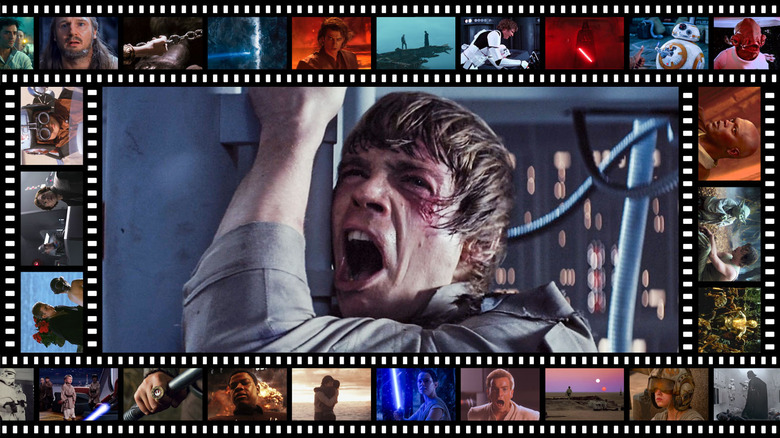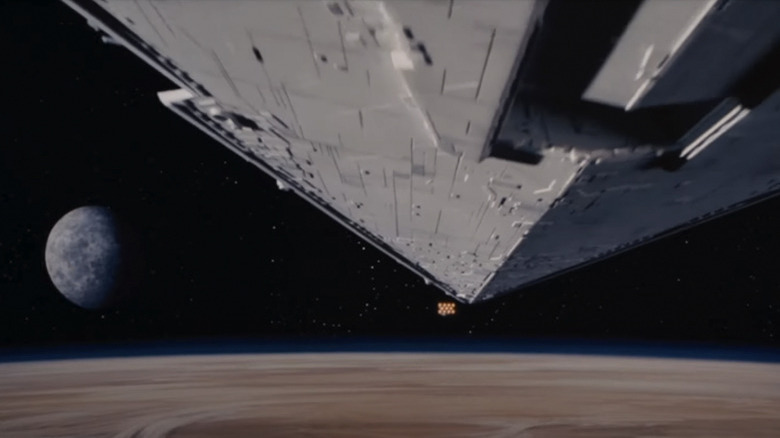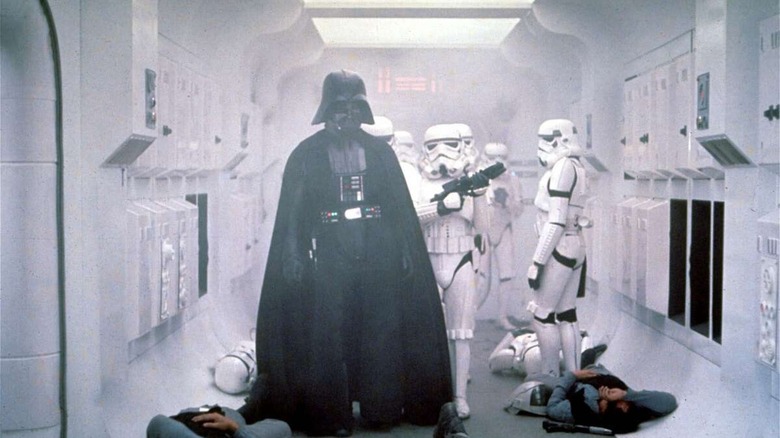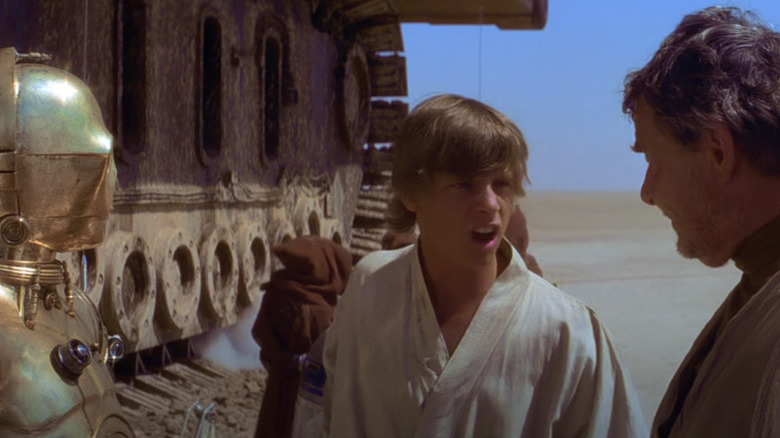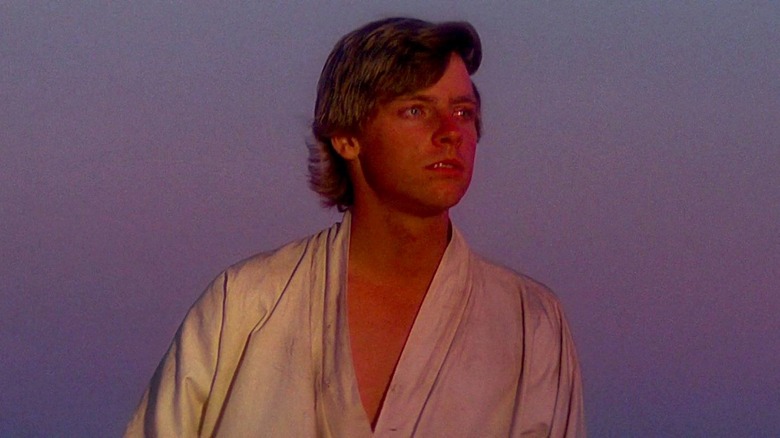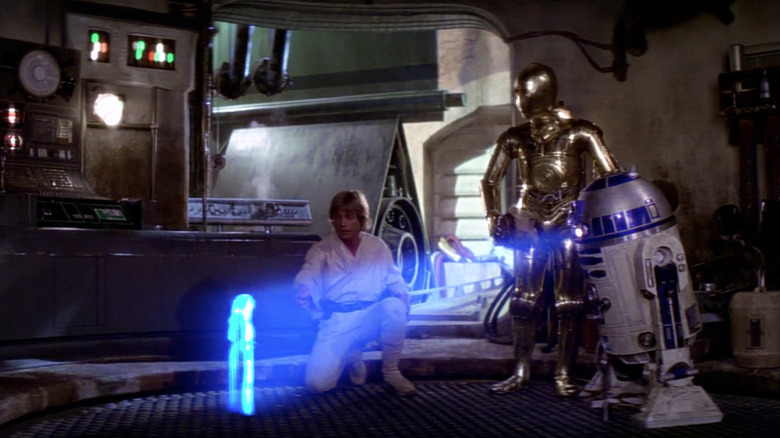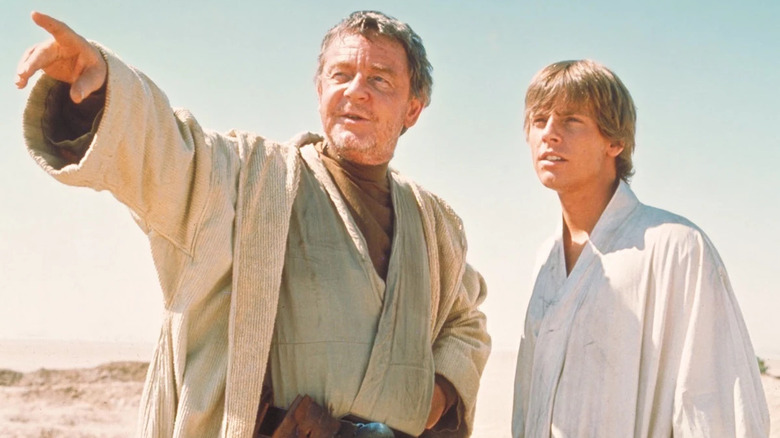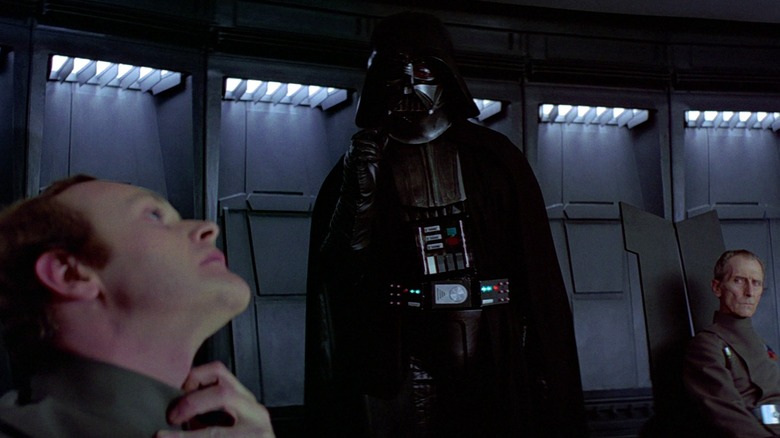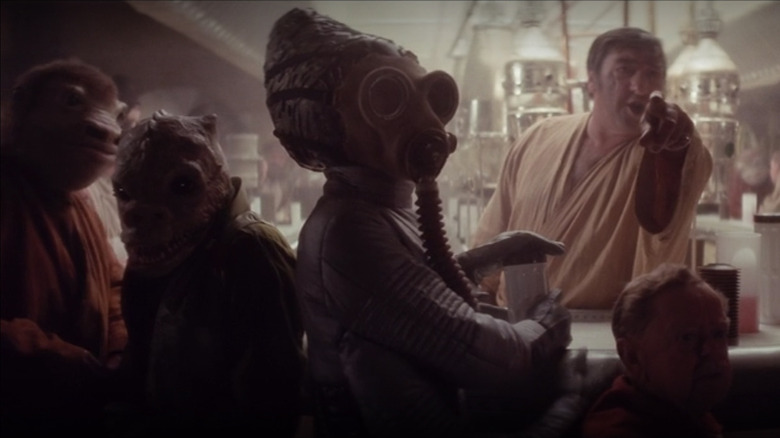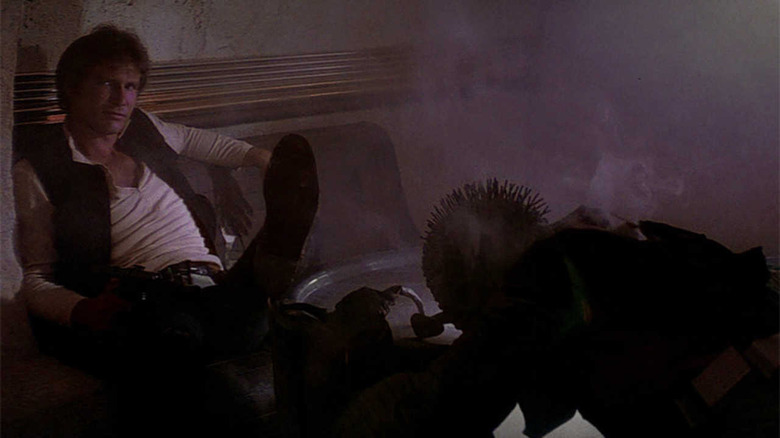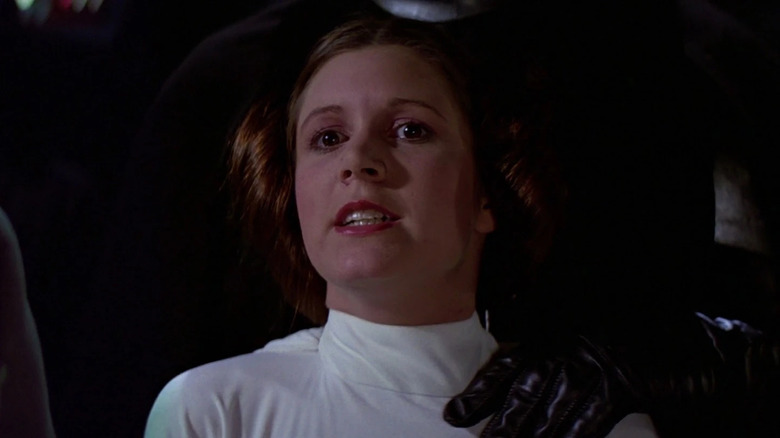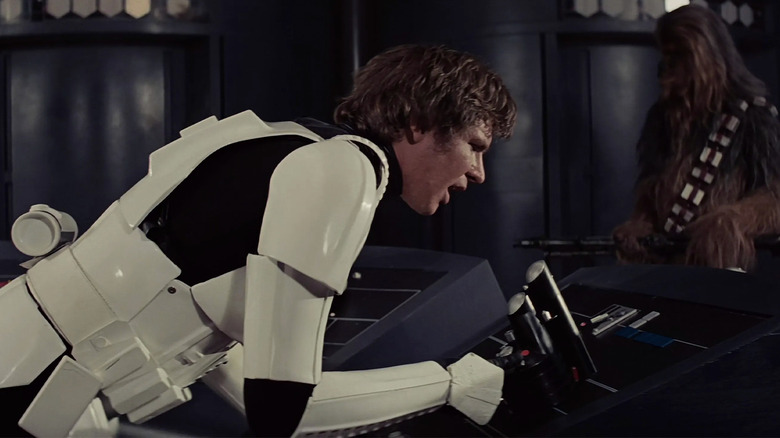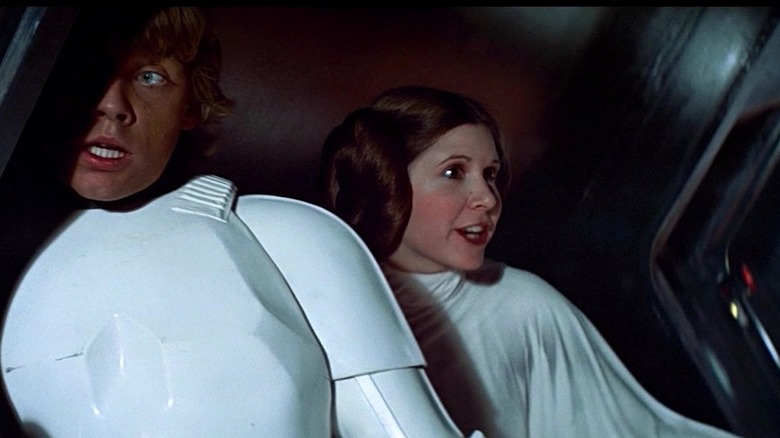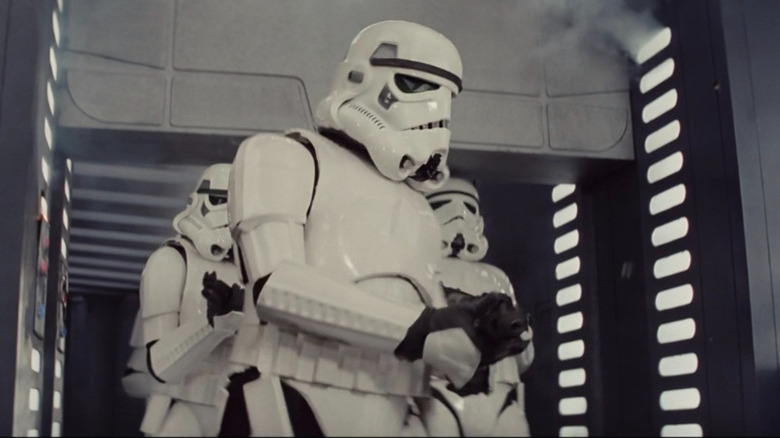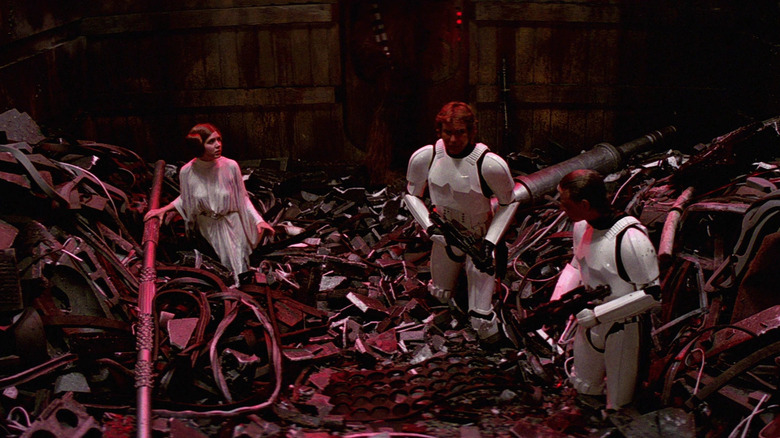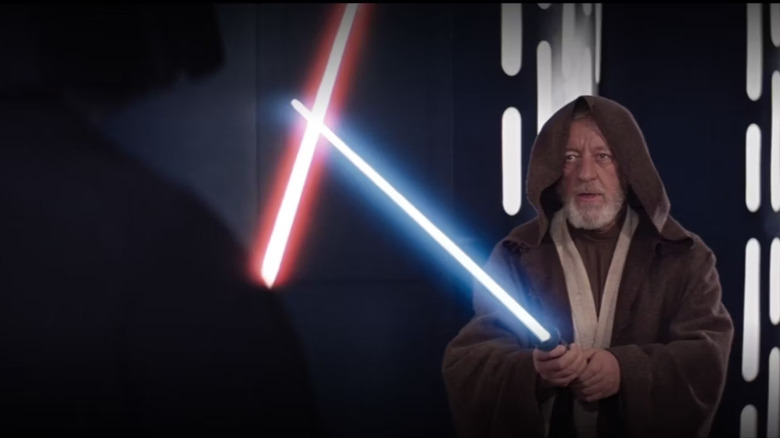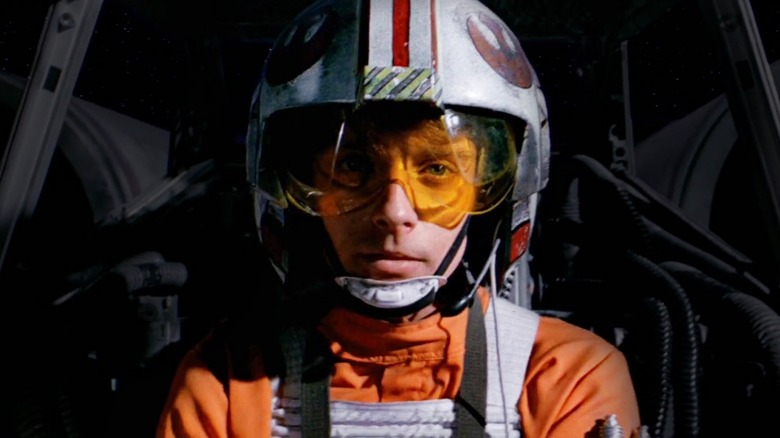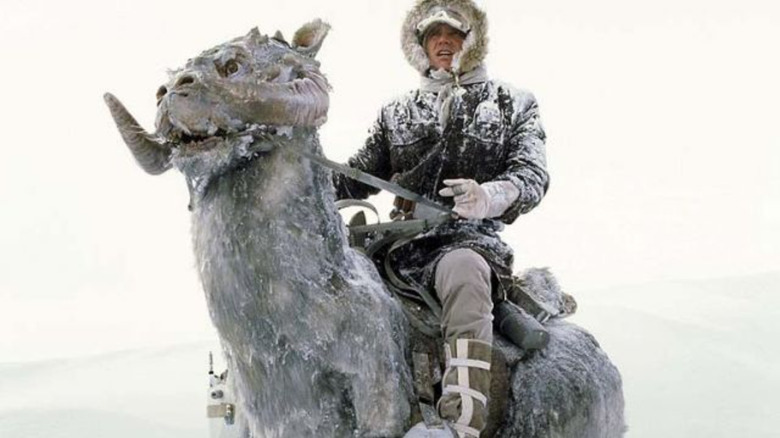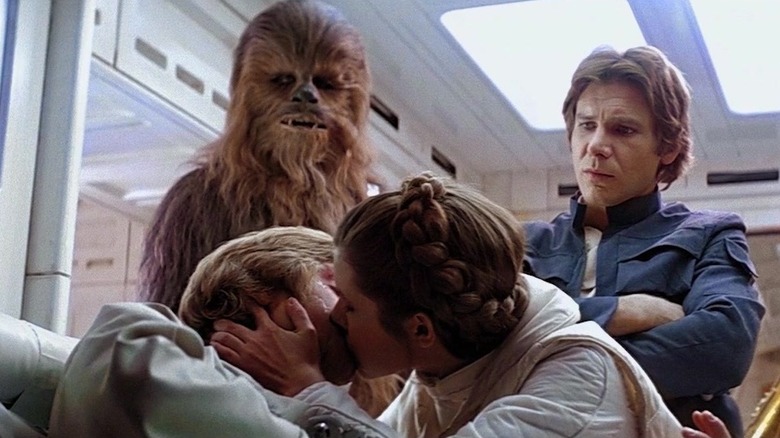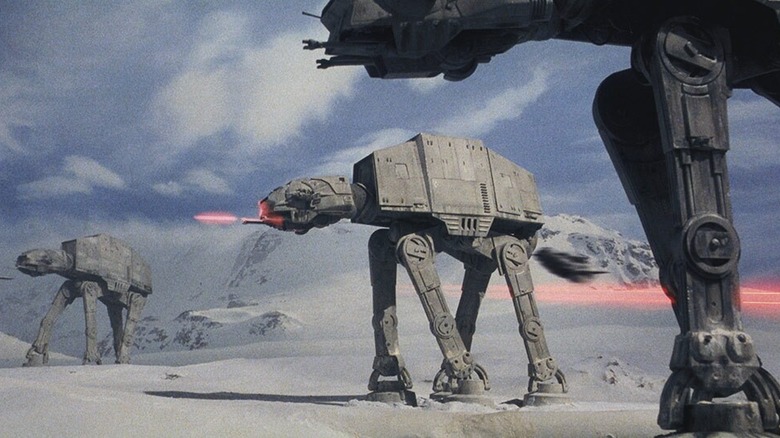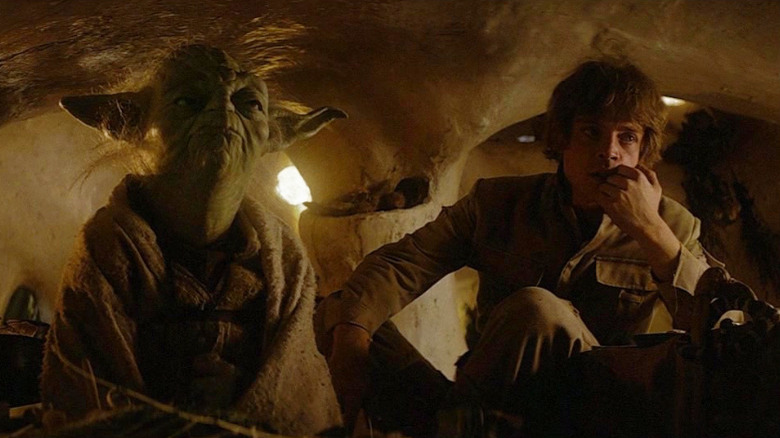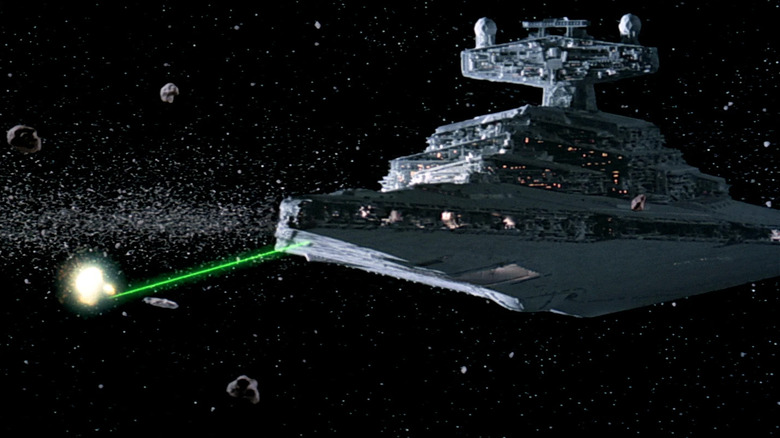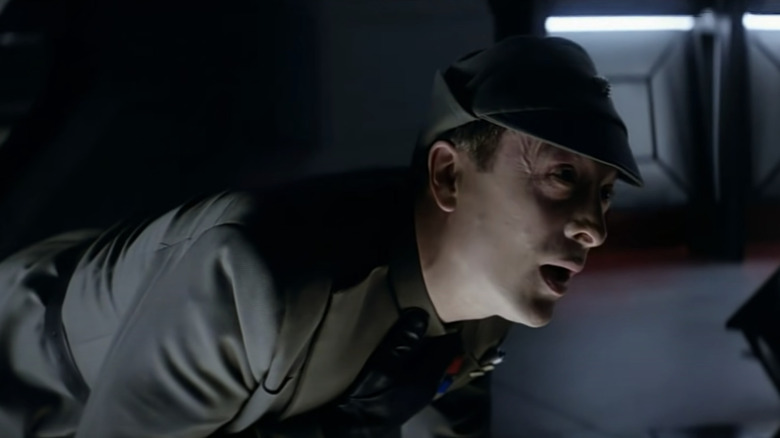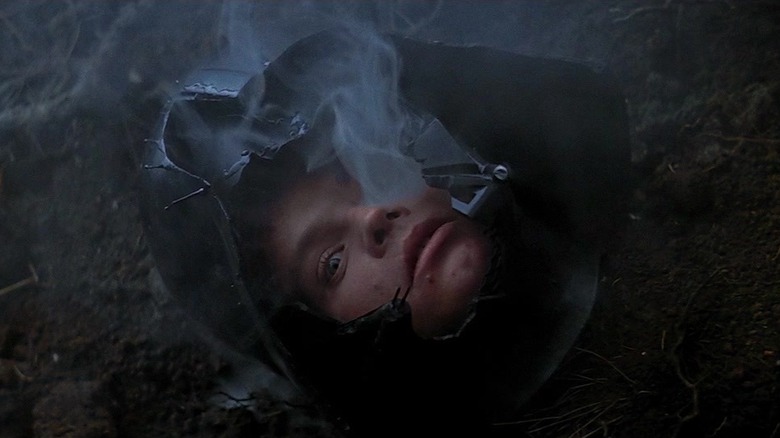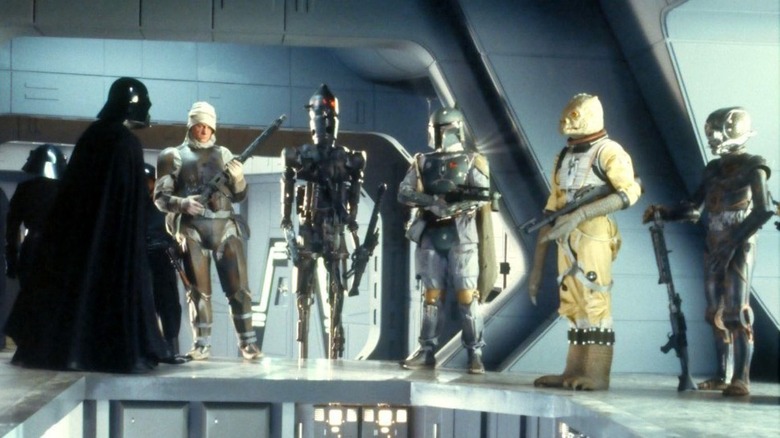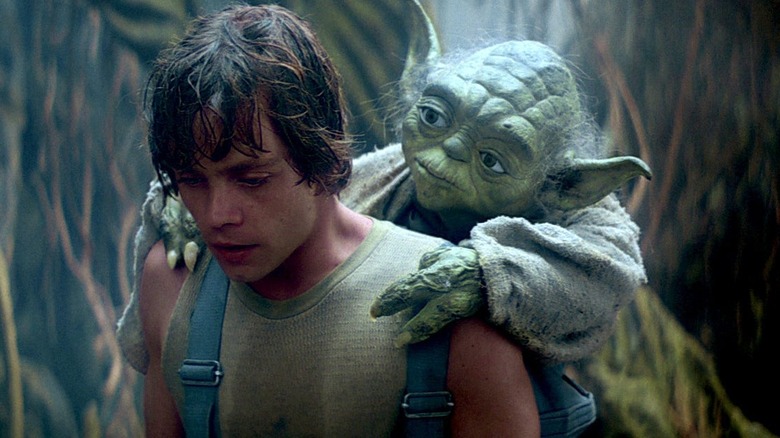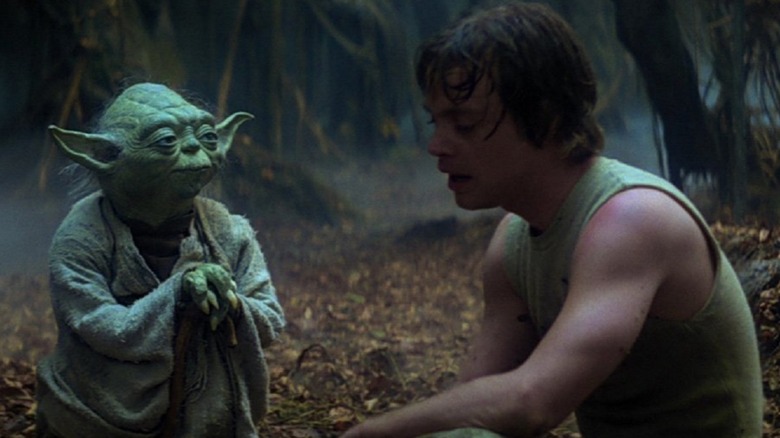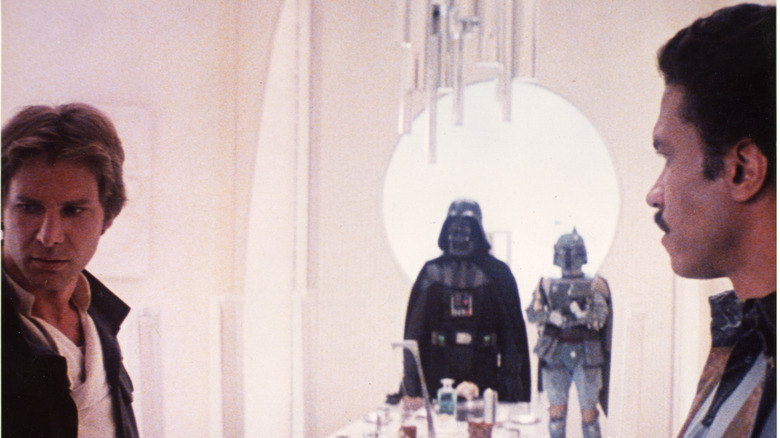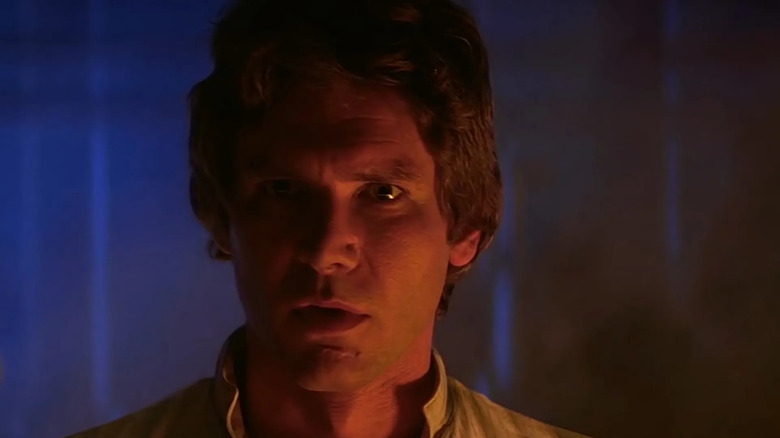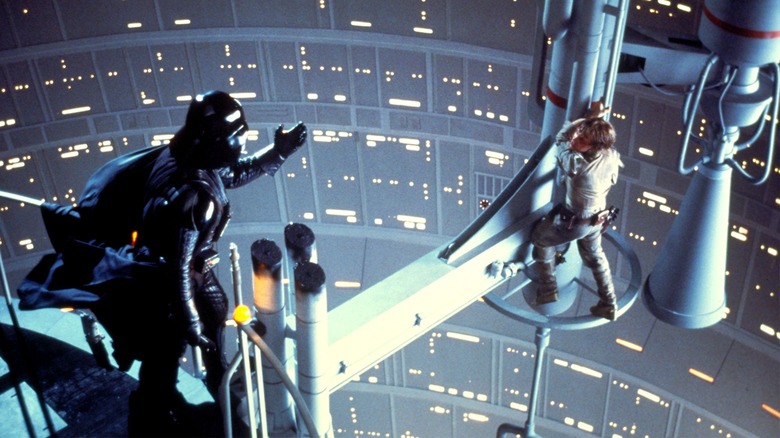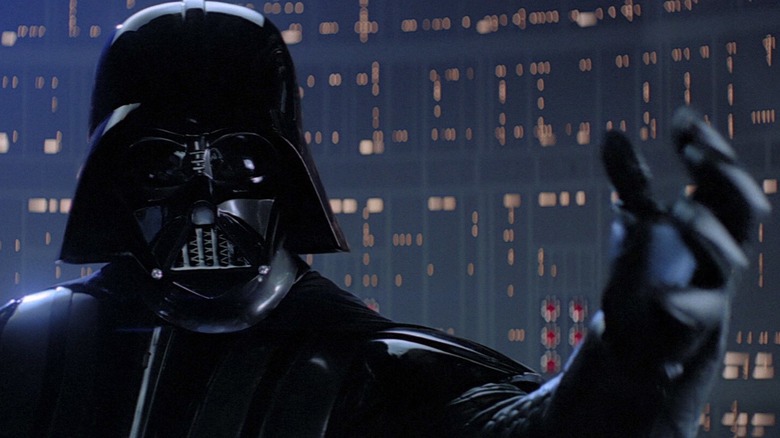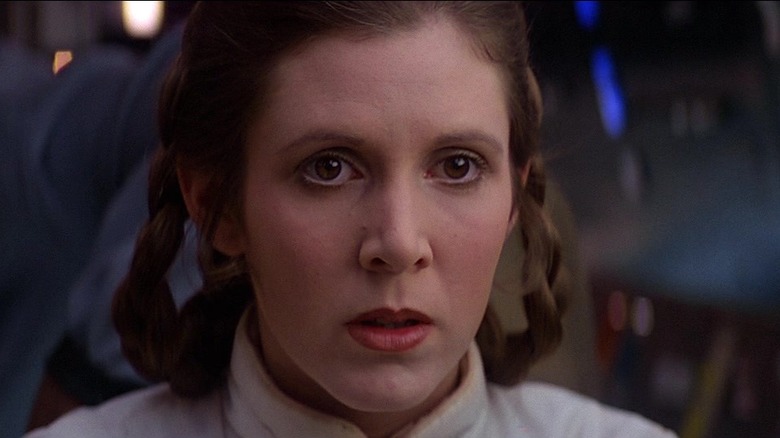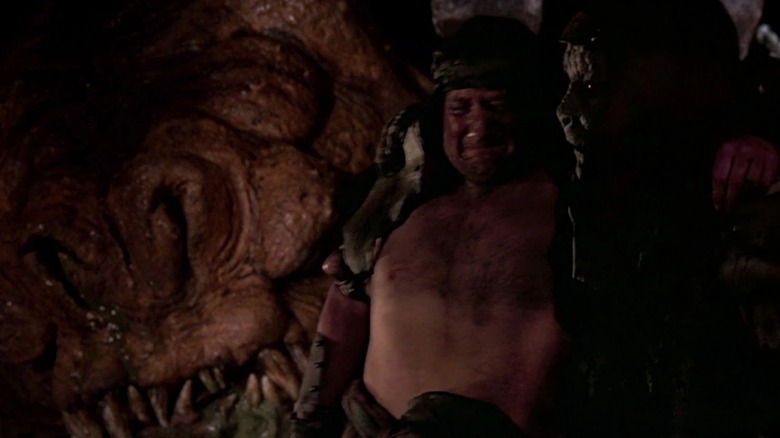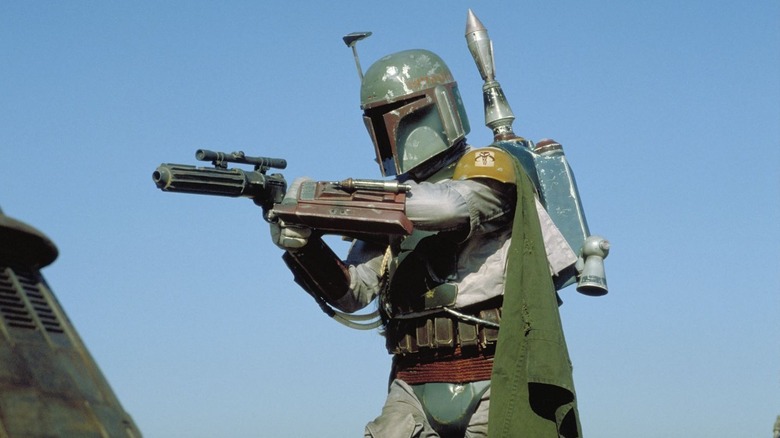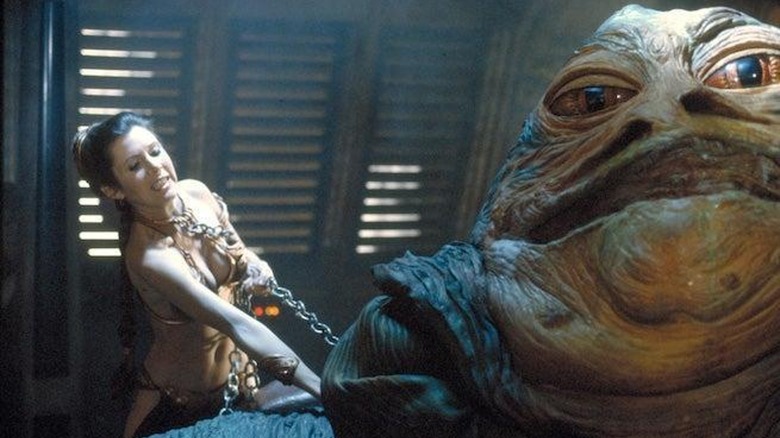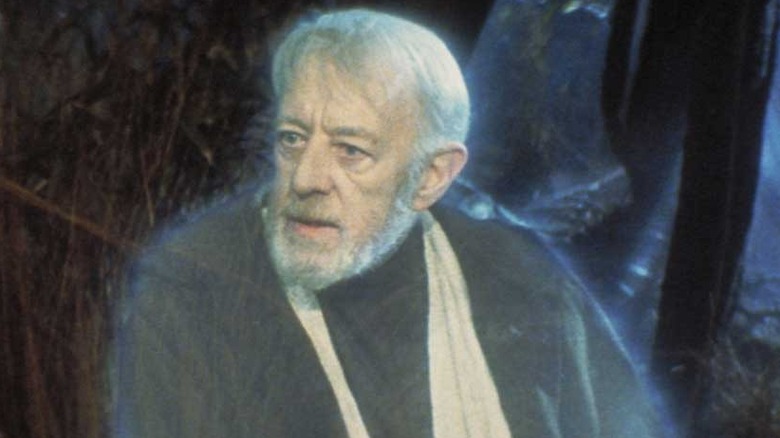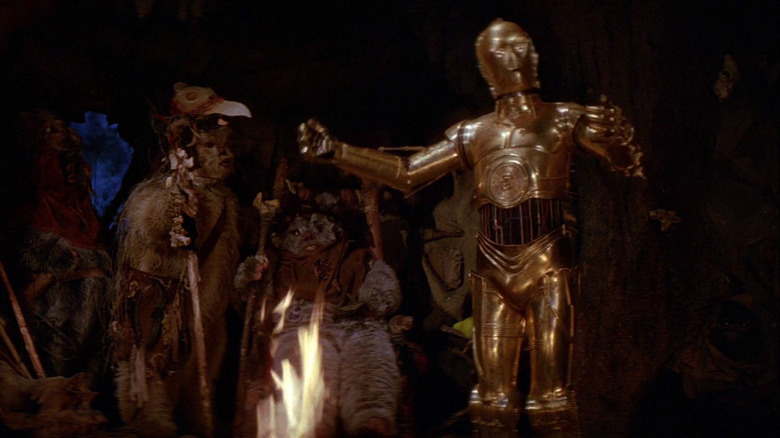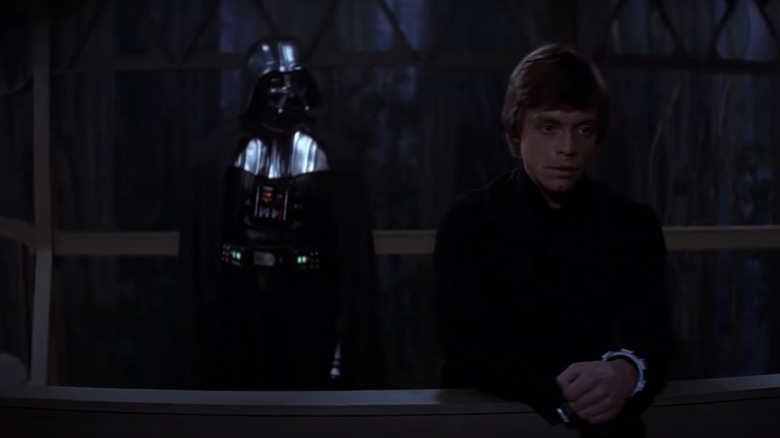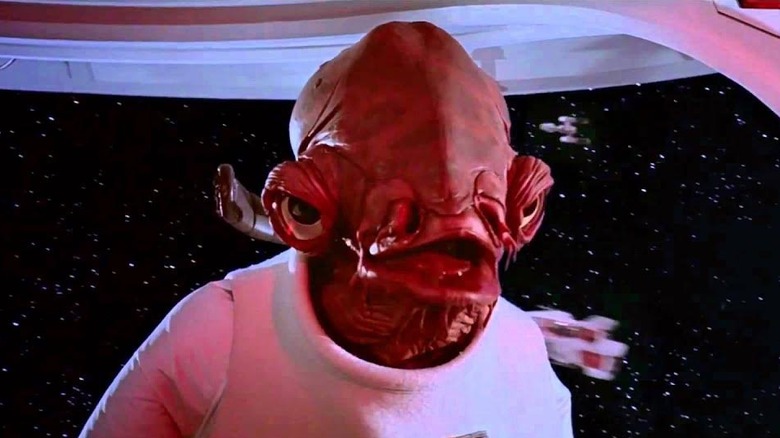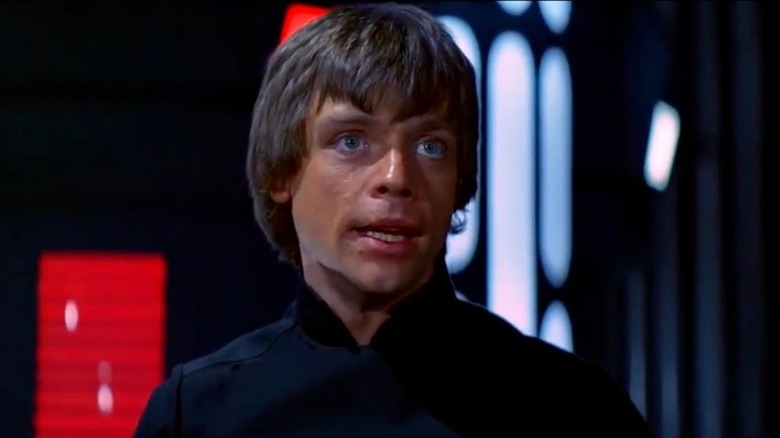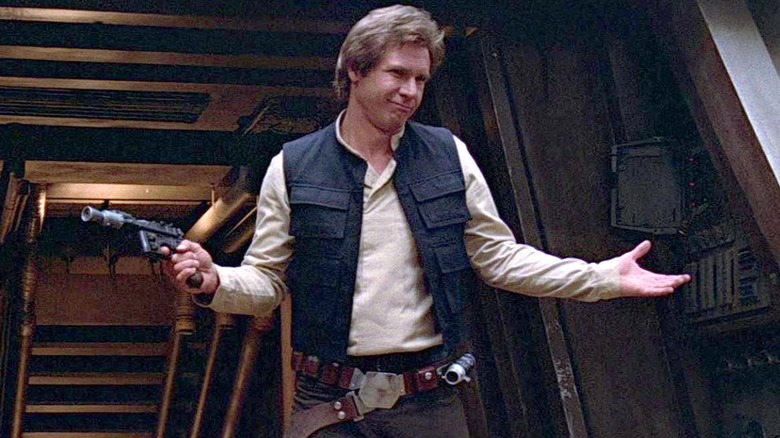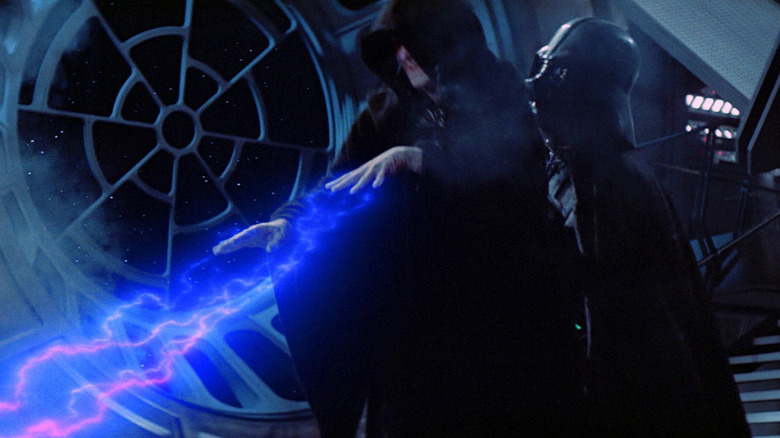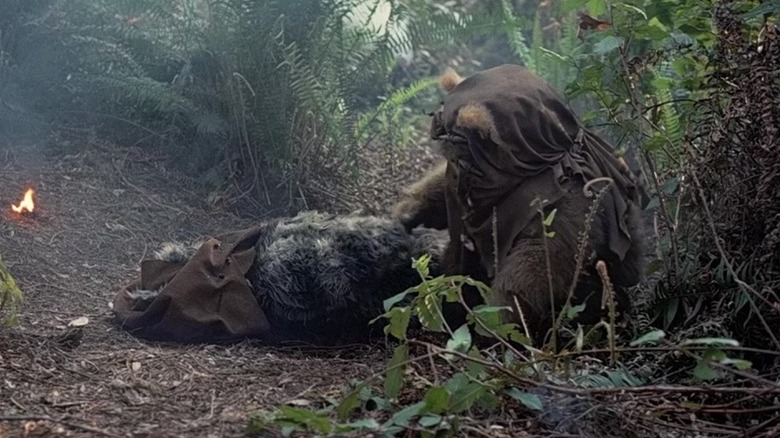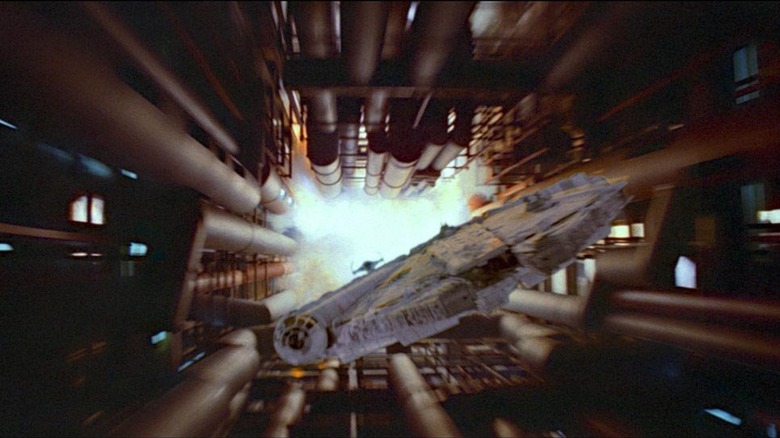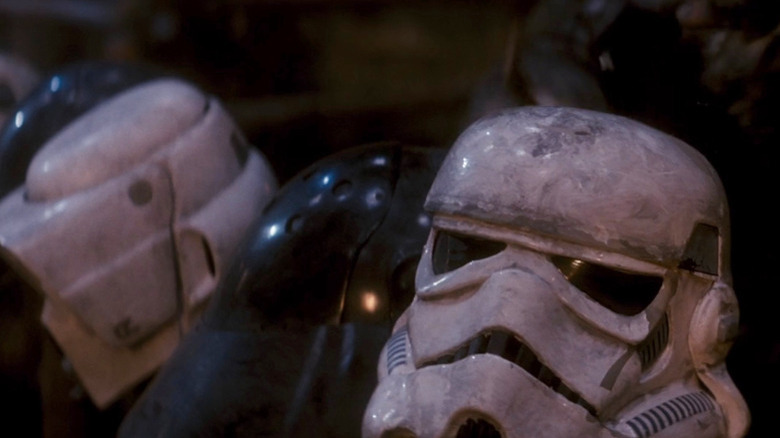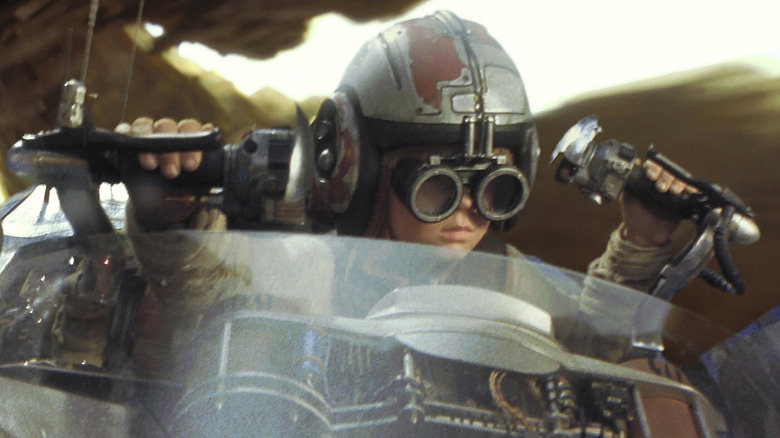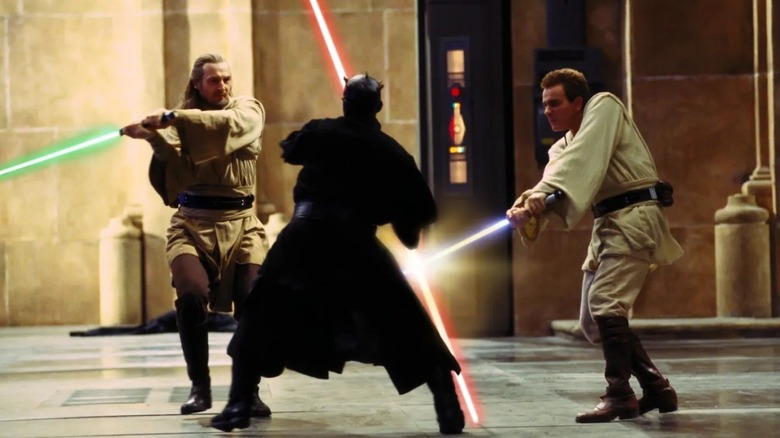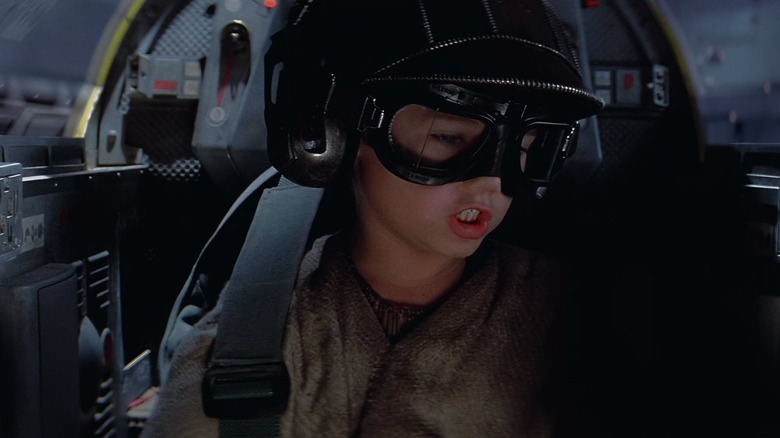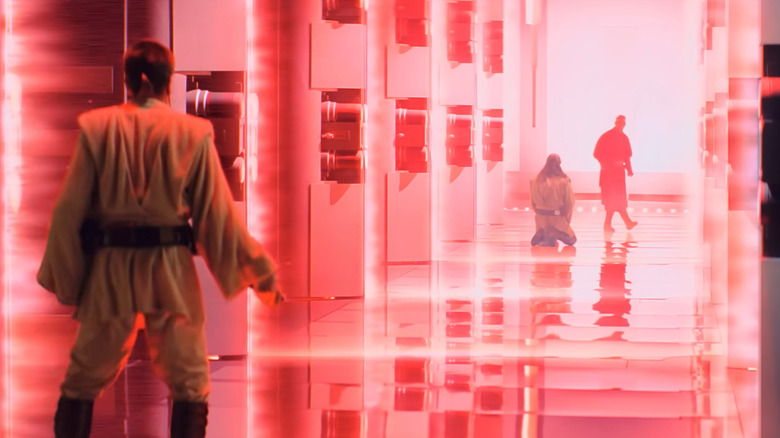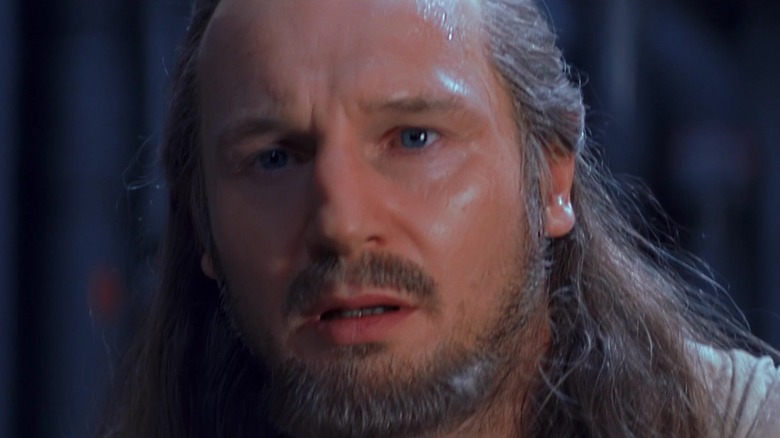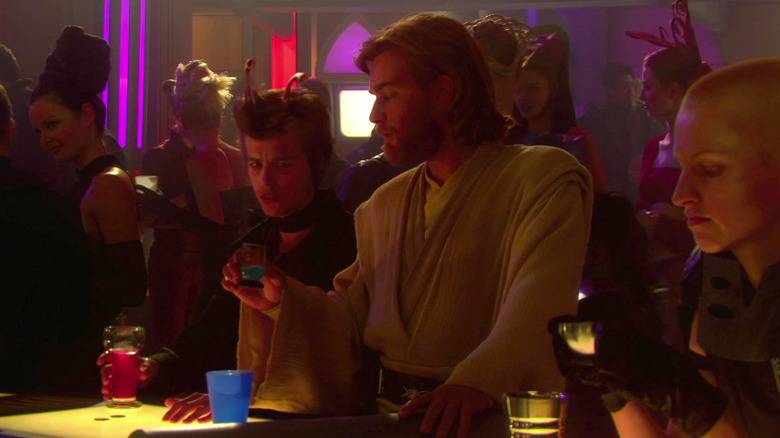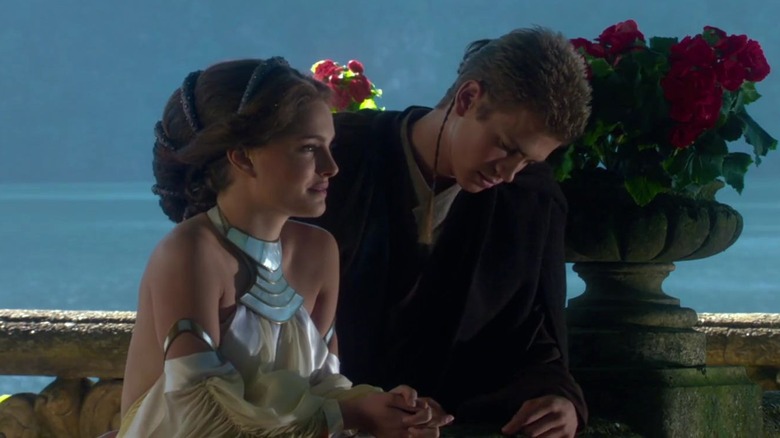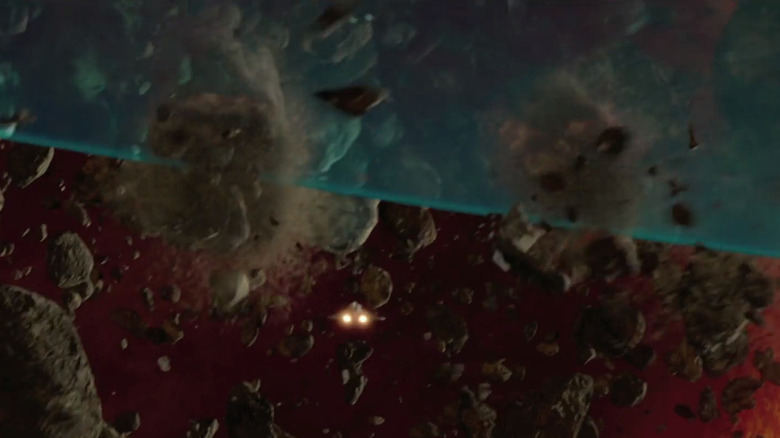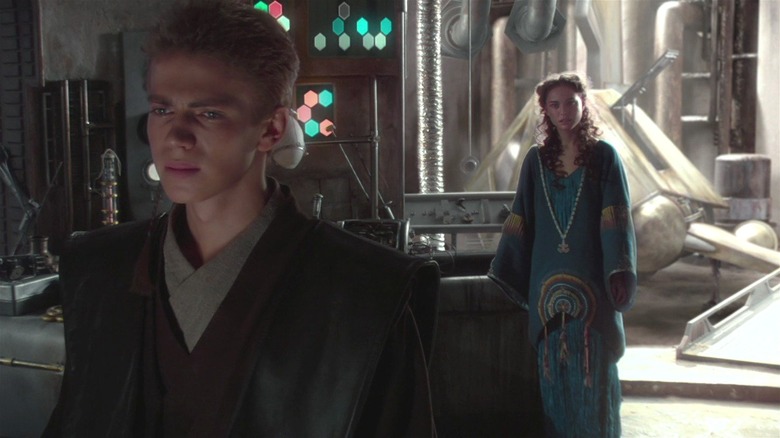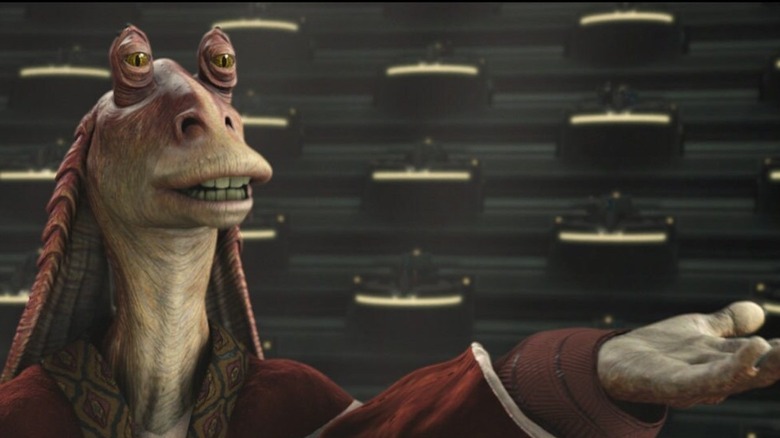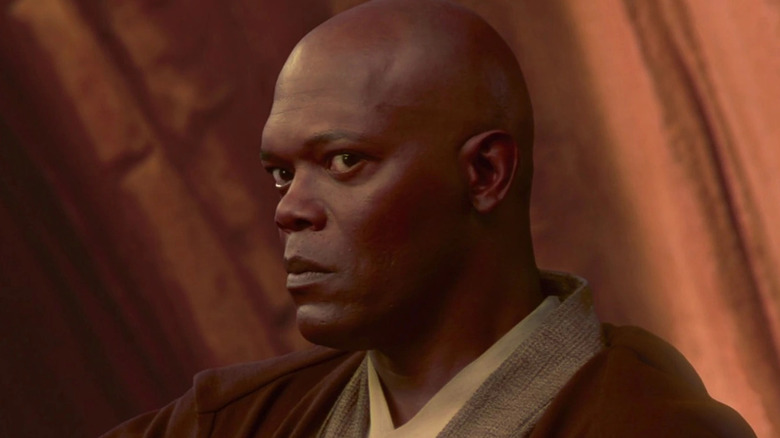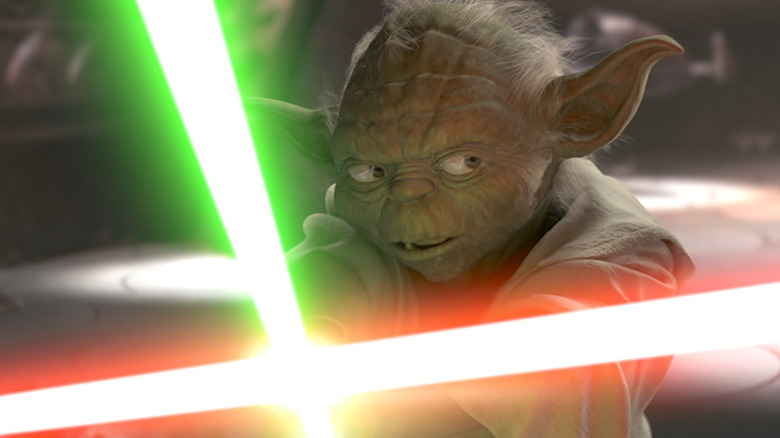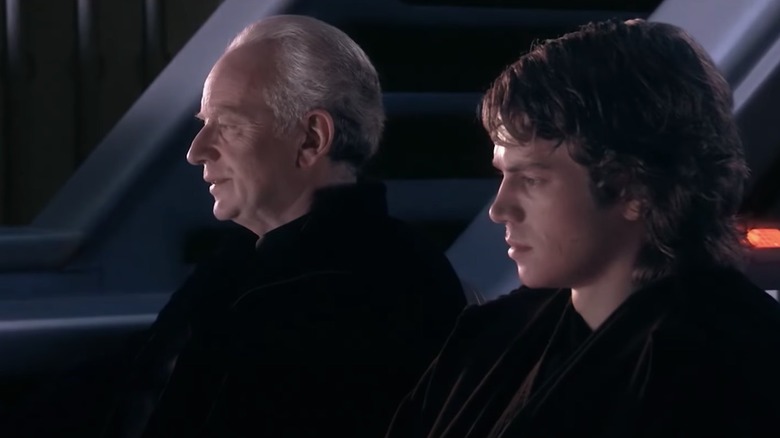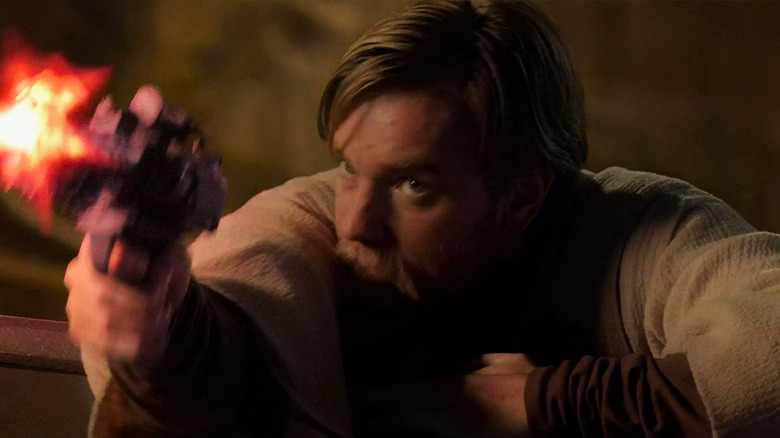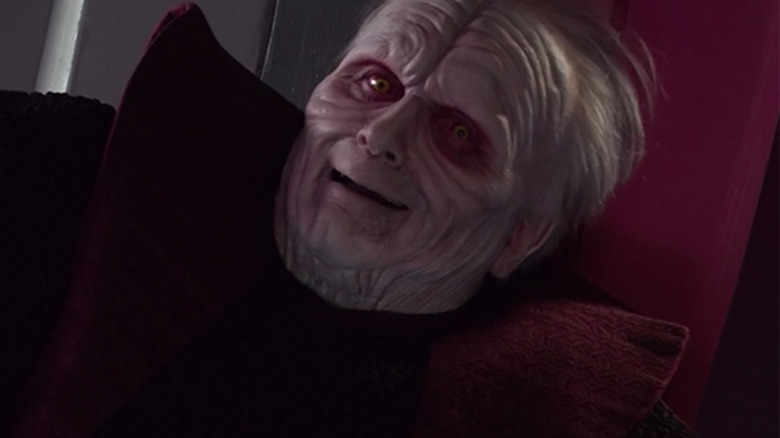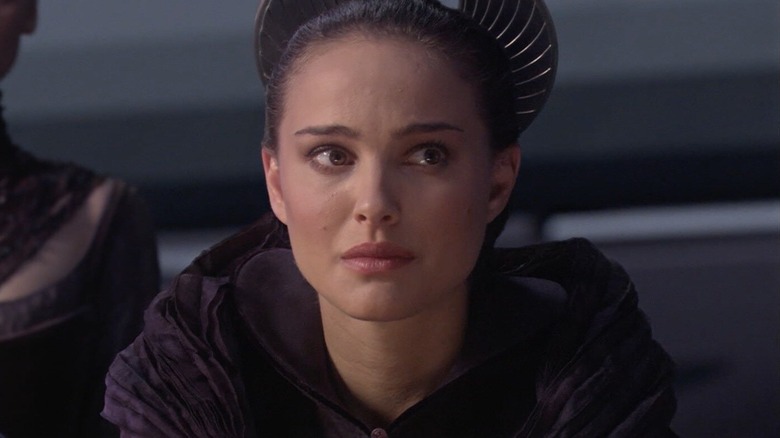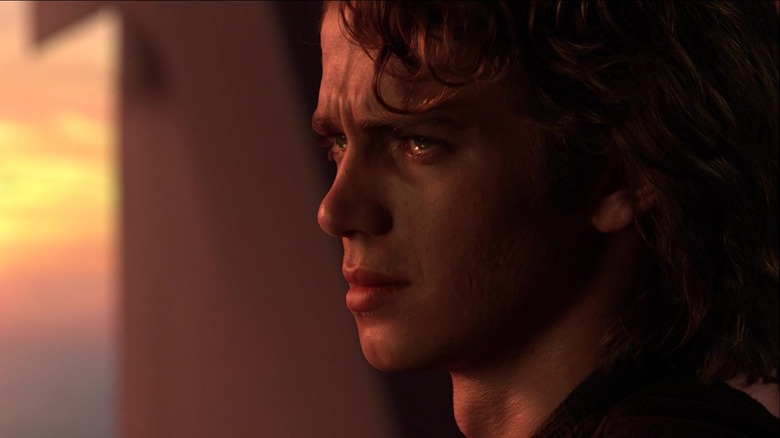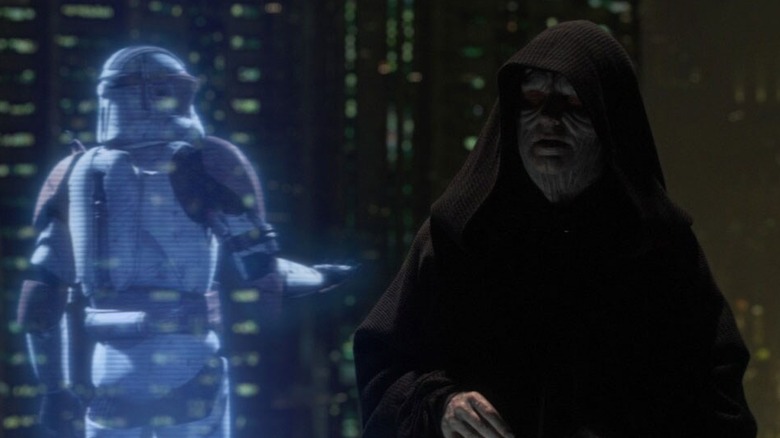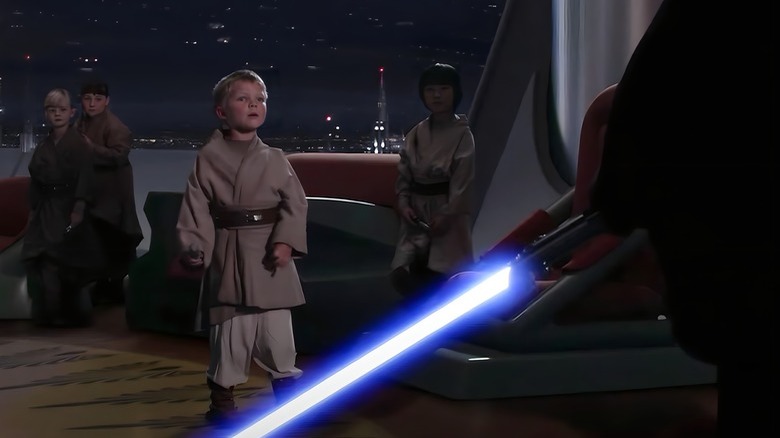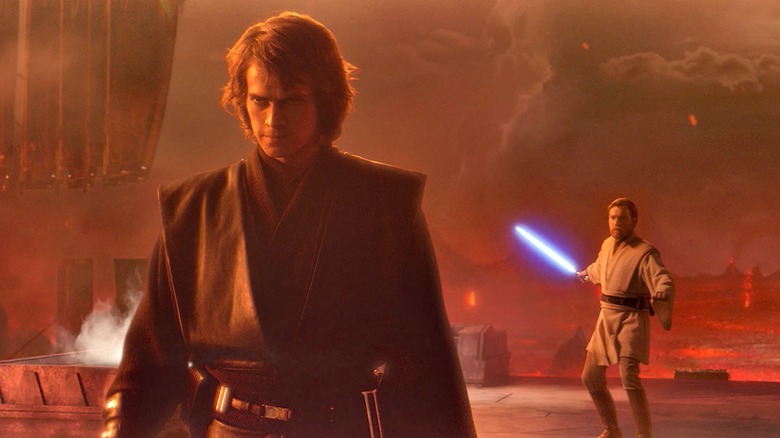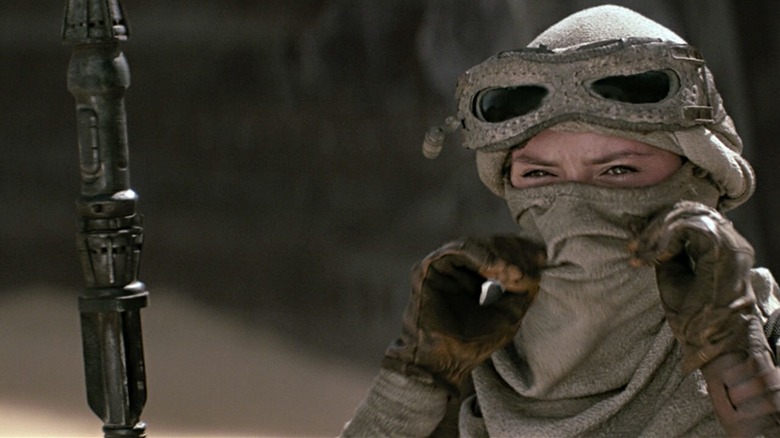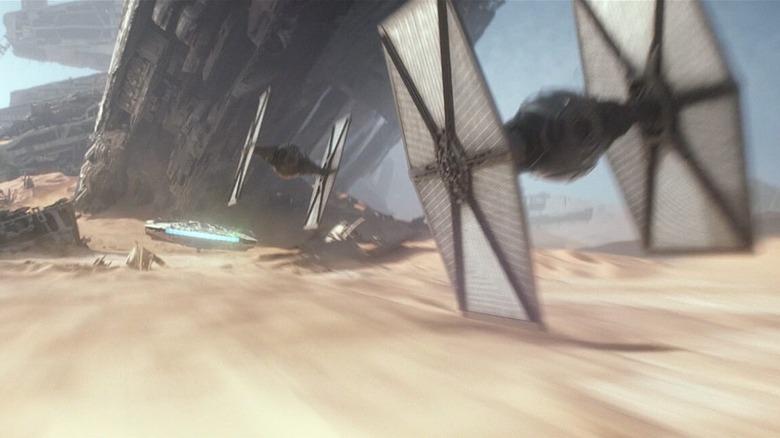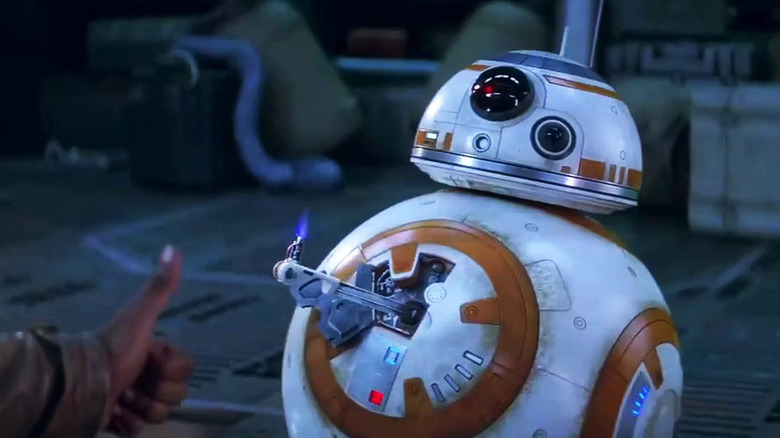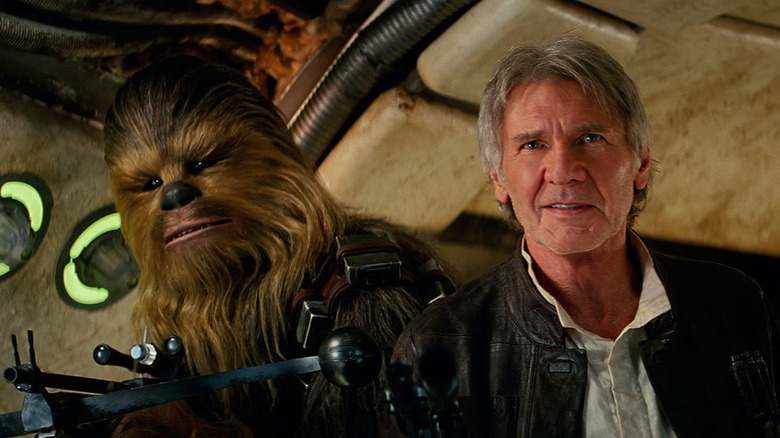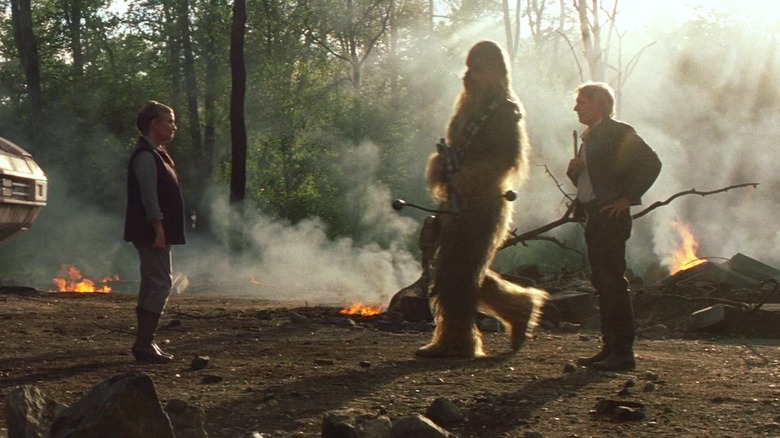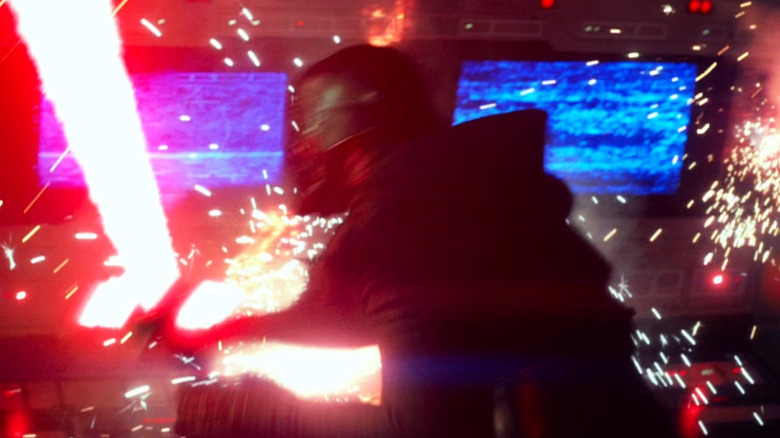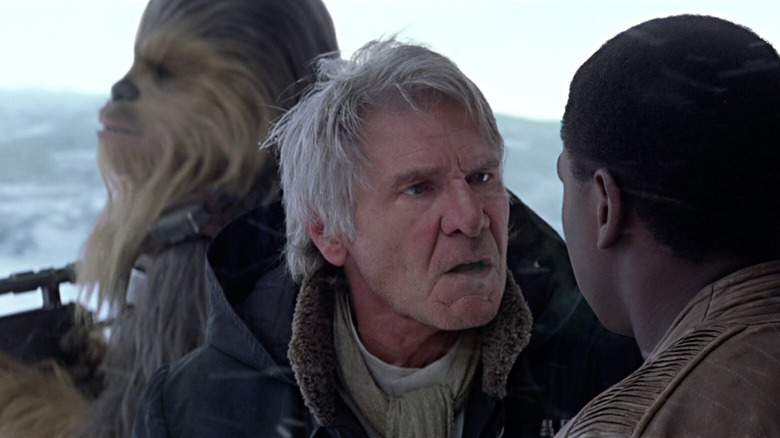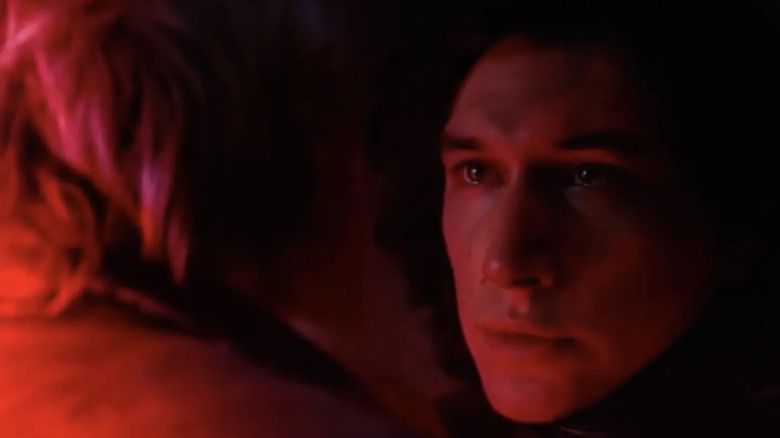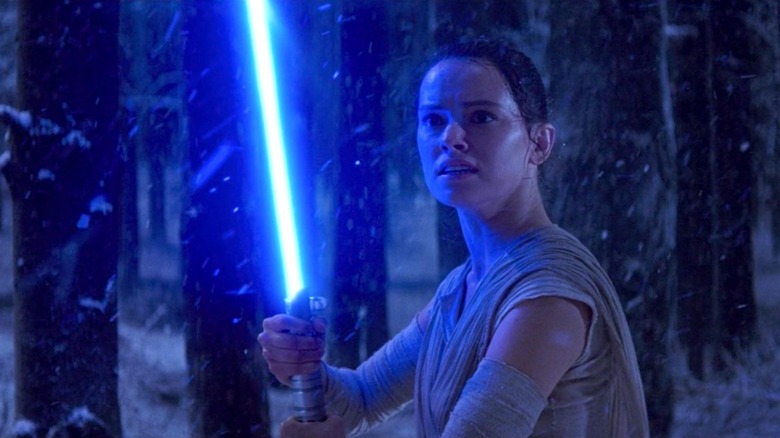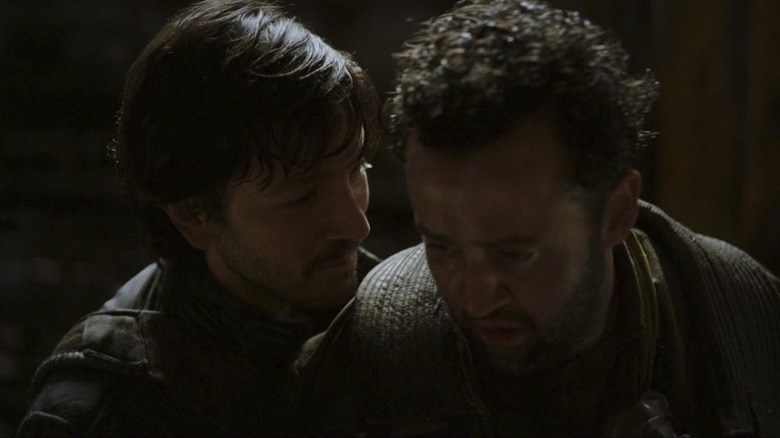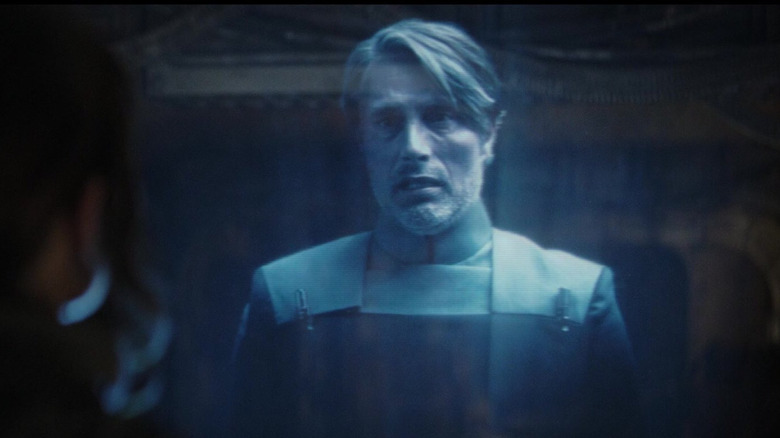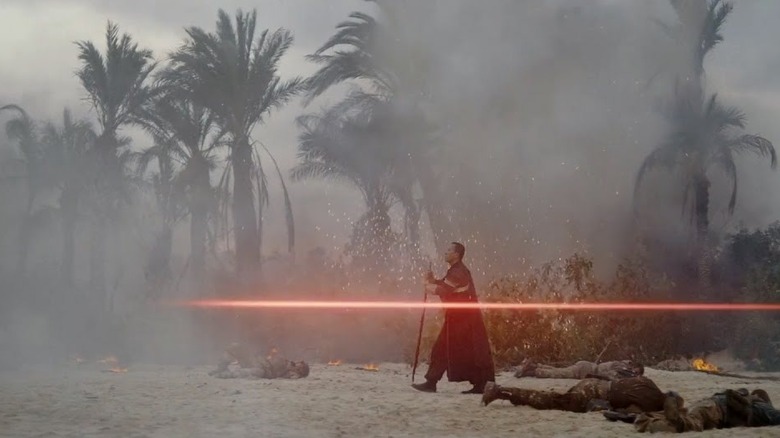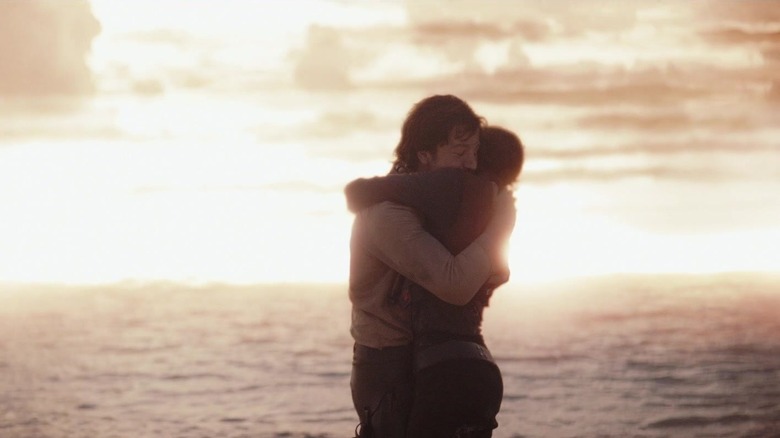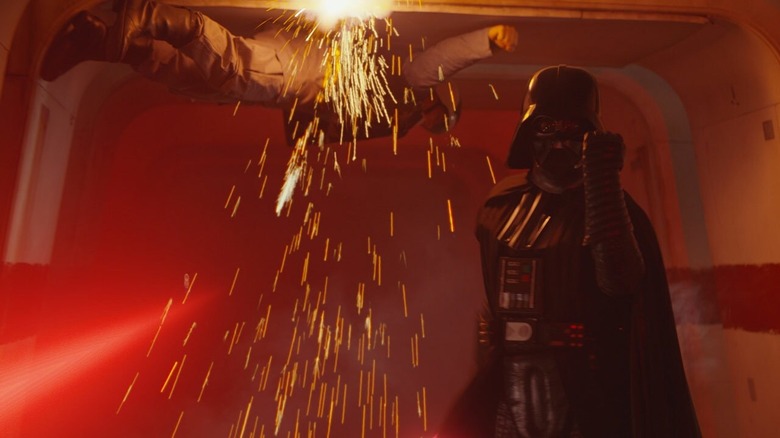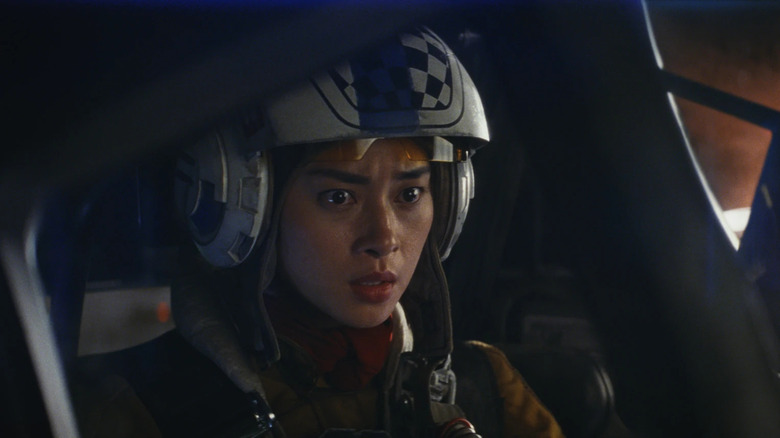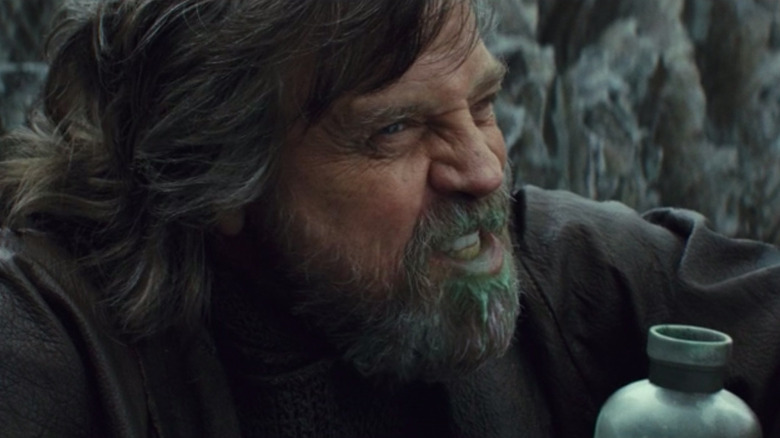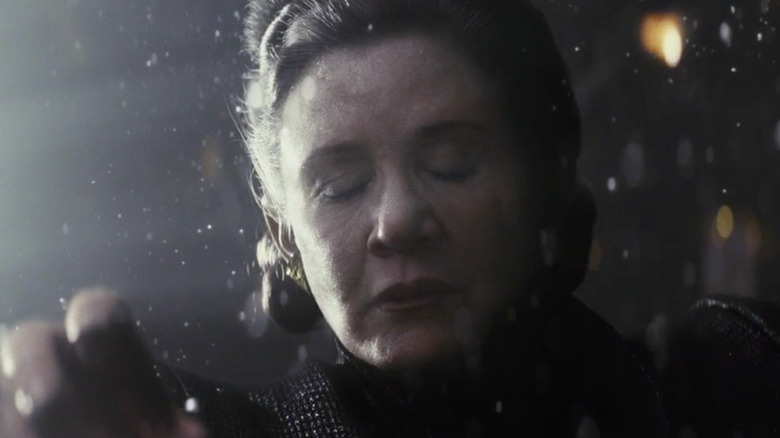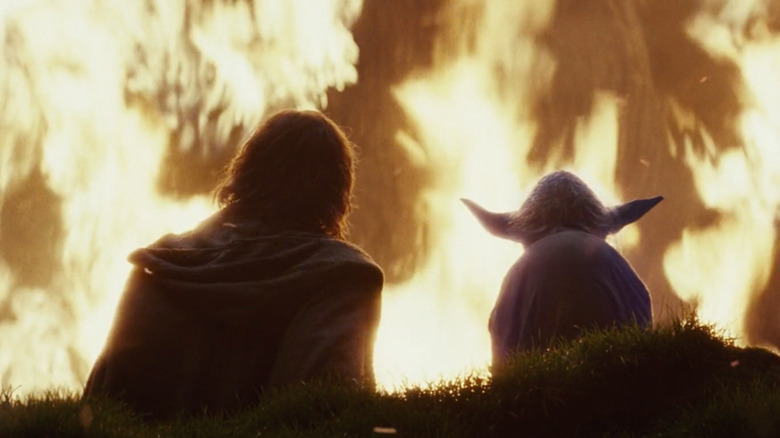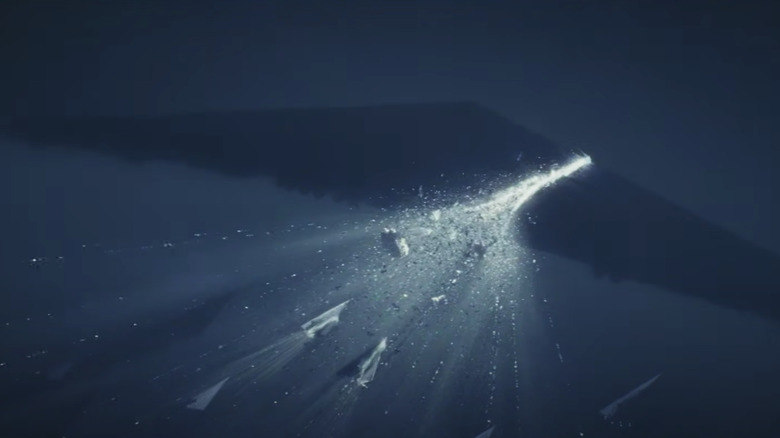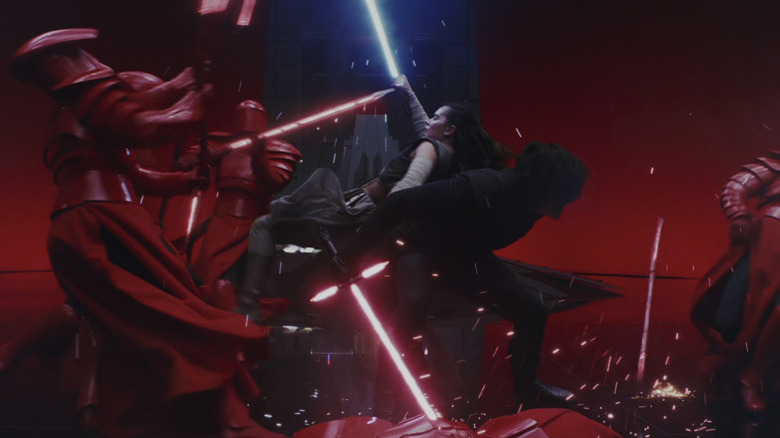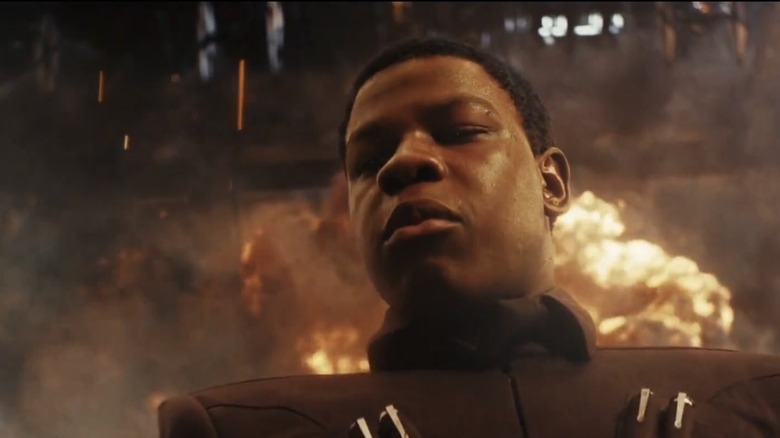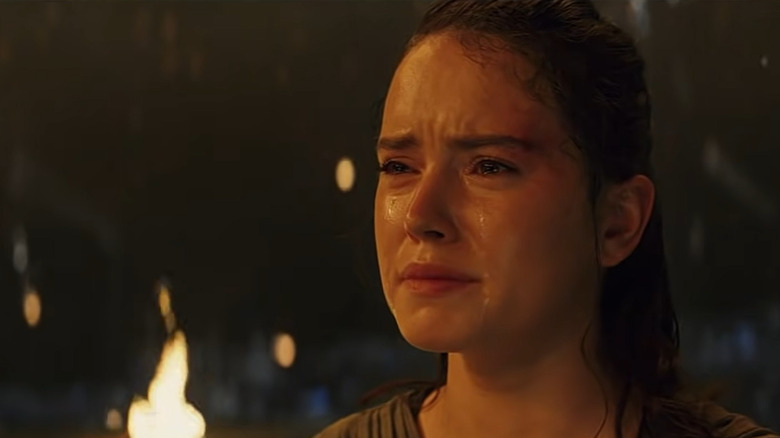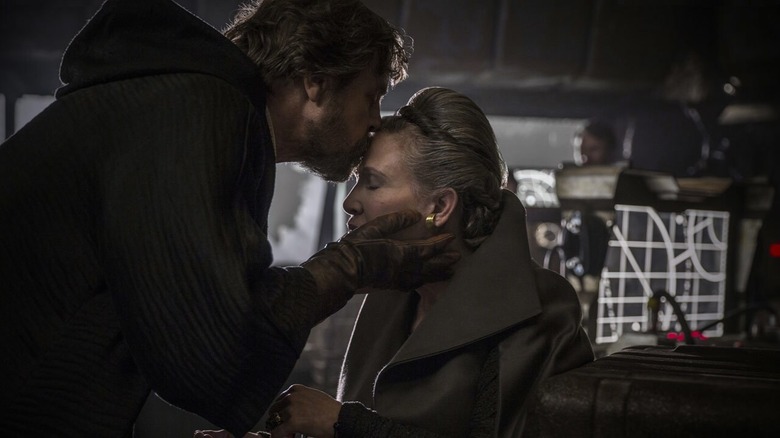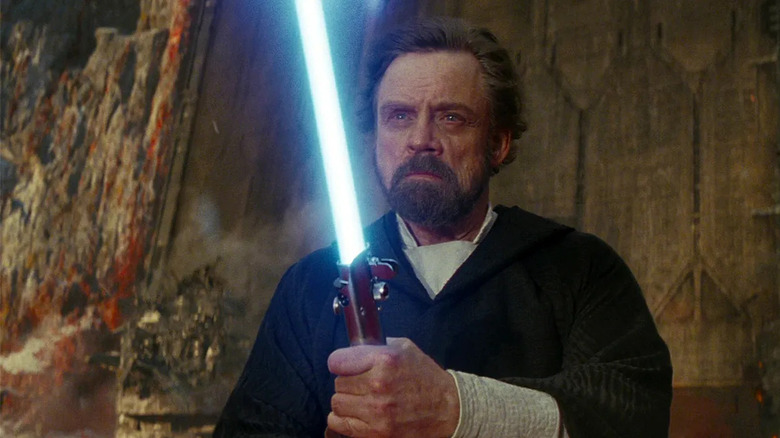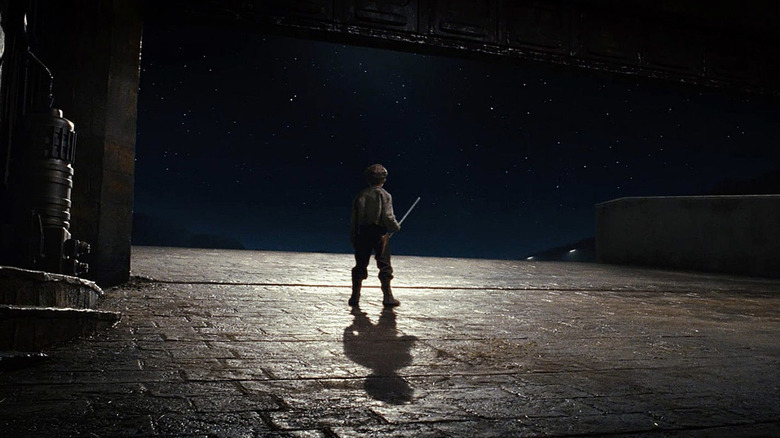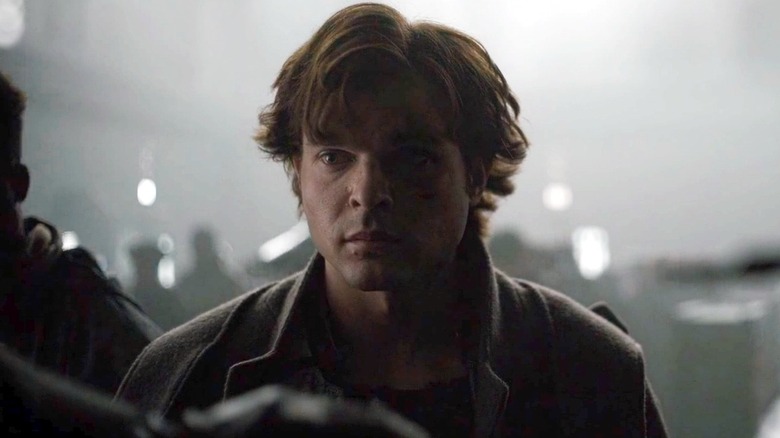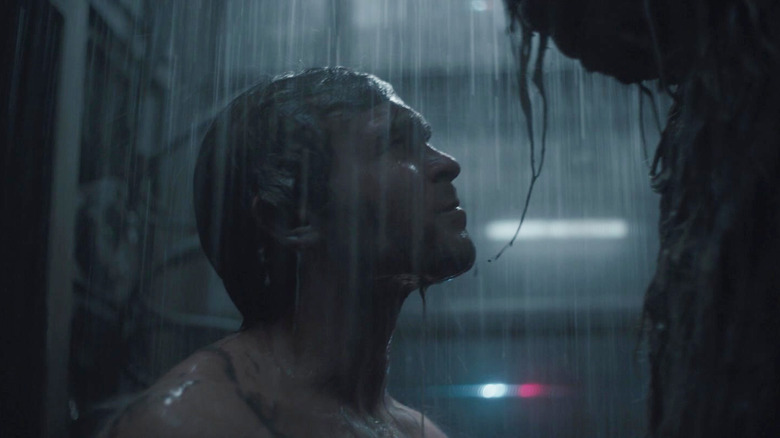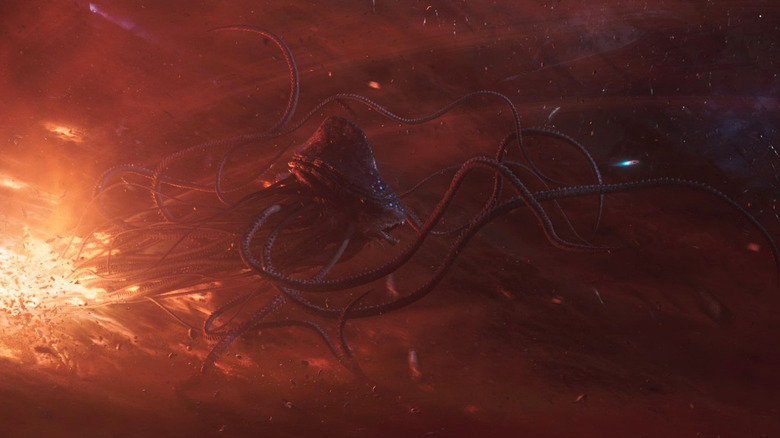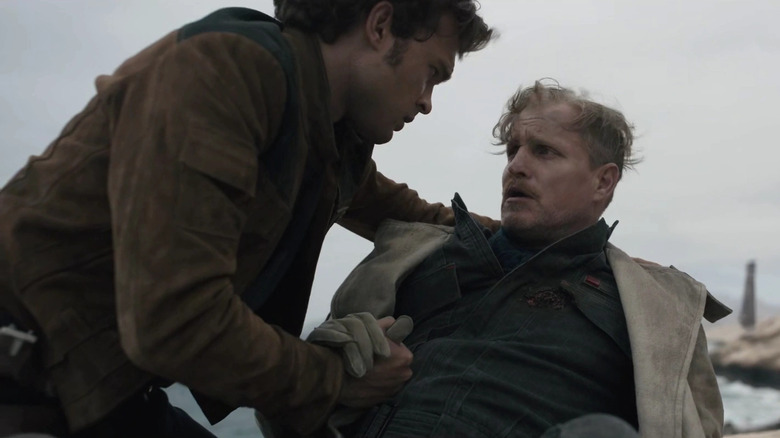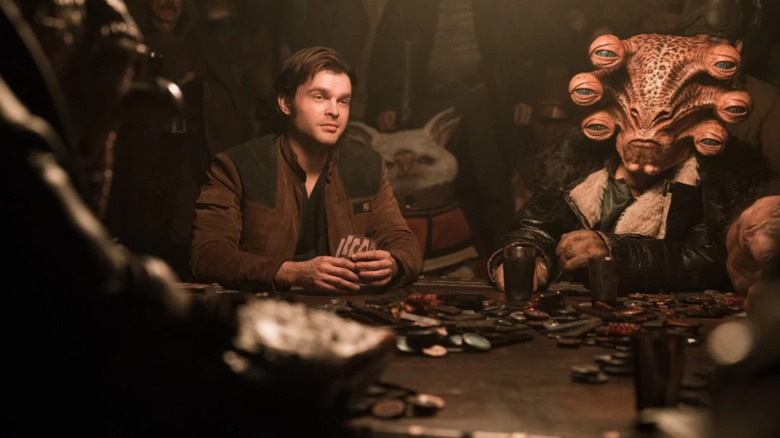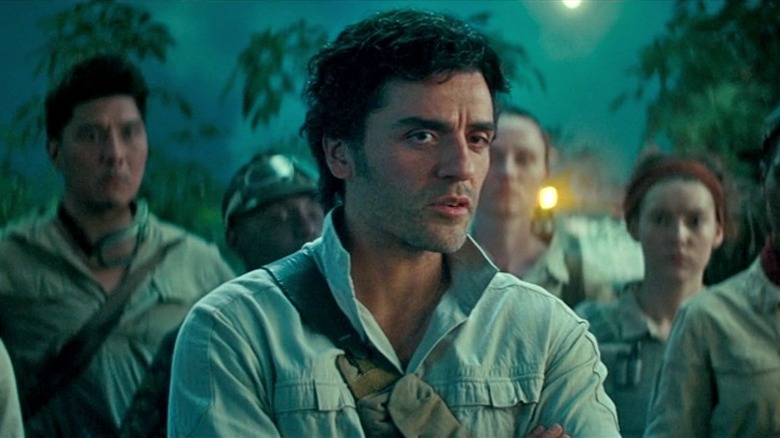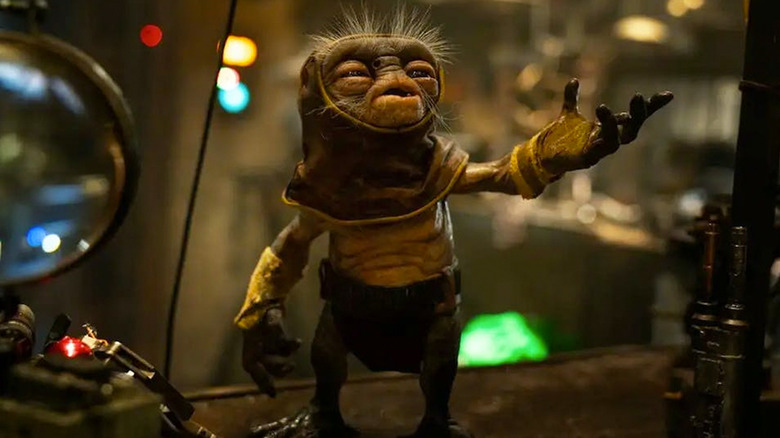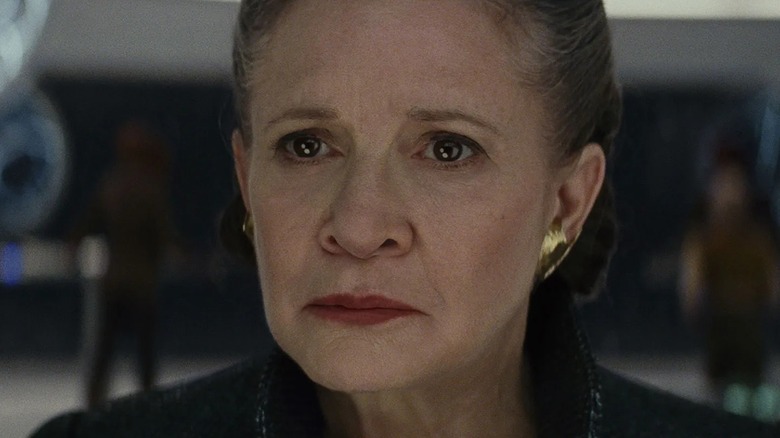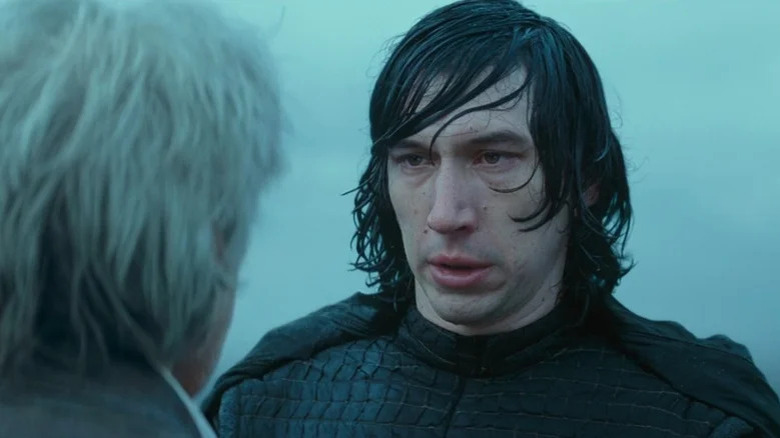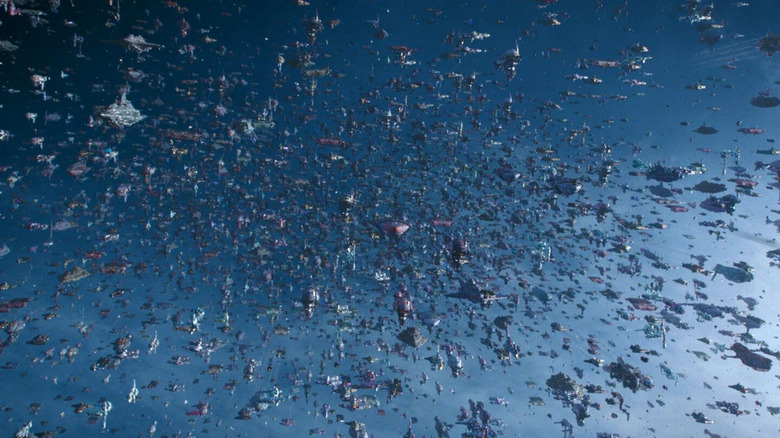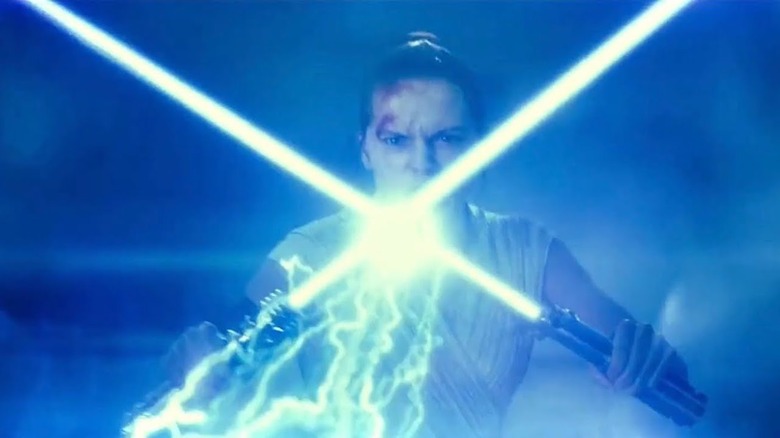The 100 Greatest Star Wars Movie Moments Of All Time
"Star Wars" is great. And when it isn't great, it's interesting. Or weird. Or hilarious. Or baffling, moving, annoying, profound, stupid, and inspiring. When you're a film franchise with nearly a half-century of staying power, you can be a lot of things. You can be everything.
/Film has been publishing articles about the "Star Wars" saga for as long as we've existed. We've waxed nostalgic about the original trilogy. We were on the frontlines of the "Last Jedi" wars. We've even watched as the prequels journeyed from "universally hated" to "begrudgingly respected." We love "Star Wars." And we sometimes love to hate "Star Was." But we mostly love "Star Wars." Like, a lot. Even the dumb stuff (especially the dumb stuff).
That brings us to this article: The 100 Greatest Star Wars Movie Moments Ever.
The /Film team sat down and nominated over a thousand moments, a sprawling list that was whittled down until we were left with the best of the best. This list chronicles the stunning, iconic moments that define the most popular film series of all time. But it also features the tiny touches, the throwaway lines, that have stuck with us over the years. And there are also the moments so memorably awful that we can't help but love them for one reason or another. There were two rules for entries on this list: a moment had to be from a theatrically released "Star Wars" movie (TV will be its own future list, thank you very much) and it had to be a moment we just, well, loved. The reason for that love is between the writer and their god. But as long as that reason exists, that's enough.
May the Force be with you. Let's go.
An Opening Crawl, And Then Two Ships... (Star Wars, 1977)
The opening moments of "Star Wars" serve as a study in contrasts. When the logo first appears, John Williams' iconic, towering score practically blasts you backward in your seat. But seconds later, the legendary opening crawl makes you lean forward.
This riff on traditional opening text, slanted and disappearing toward a vanishing point at the top of the screen, is a microcosm of what George Lucas is doing with this movie, remixing elements of pulpy "Flash Gordon" serials into something operatic and new. You immediately want — you need — to know everything you can about this world Lucas has created.
Once the stage is set, two ships fly past overhead, firing laser blasts at each other. The first ship seems tiny, but the second one is enormous, instantly and clearly laying out the stakes of the action: The big guy is chasing the little guy, and the little guy is helplessly outgunned. Everything about this is designed to immerse you in the story, including the decision to place the camera underneath these ships, so the audience is looking up at them instead of observing them from above or from afar like some sort of omniscient being. This is cinema, folks. Mel Brooks famously parodied this moment with a much longer ship in "Spaceballs" years later, but that doesn't diminish the power Lucas's film still has. I still find myself almost reflexively ducking down a little when watching this scene, because you can almost feel the weight of the Imperial ship above your head as it flies overhead. It's evident from the jump that this movie will be working with absolutely massive scopes, far bigger than the rinky-dink, small-scale science fiction of the previous decades. And all of this has happened before you've even seen a single character on screen. (Ben Pearson)
The Arrival of Darth Vader (Star Wars, 1977)
After hordes of Rebels are gunned down by Stormtroopers inside Leia's blockade runner, a mysterious, menacing figure approaches the scene and surveys the massacre. This is the first time we are introduced to Darth Vader, whose complicated, violent legacy will cast a long shadow on the events that shape the "Star Wars" universe, and this quick, yet effective moment cements his larger-than-life presence that lingers even after he's dead. While viewers are not aware of Vader's true nature or intentions at this point, his appearance alone is enough to make an unforgettable impression. The all-black costume, that mask, and even the way he breathes quickly paints him as an intriguing antagonist. The power of hindsight and added context only serves to make this introduction better, as it is succeeded by Vader participating in the destruction of Alderaan with the careless cruelty that he's known and feared for.
The unforgettable hallway scene in "Rogue One: A Star Wars Story" helps flesh out this introduction even more. Moments before, Vader had brutally cut through countless Rebels standing in his way, his red lightsaber swishing menacingly in the dark, highlighting the raw power he holds over life itself. The fact that Vader surveys the dead Rebels in "A New Hope" with indifference and mild disinterest is a subtle peek into the detached atrocities he is capable of, a stark contrast to the deeply compassionate, empathetic Anakin Skywalker we get to meet down the line. And oh, the scene also looks unbelievably cool, of course. (Debopriyaa Dutta)
Lukę Skywalker Wants His Power Converters (Star Wars, 1977)
For decades, some corners of "Star Wars" fandom have liked to complain about just how "whiny" Luke Skywalker is in the first movie. But isn't that obnoxious, petulant attitude a vital aspect of the character's journey? Luke begins these films as a self-absorbed teenager who would much rather be out blasting womp rats with his friends than doing household chores (#relatable), and nowhere is that more evident than the moment where he's at absolute peak whine.
The way Mark Hamill delivers the line "But I was going into Toshi Station to pick up some power converters!" is grating, childish, and yes, annoying as all get-out. It's the "Star Wars" equivalent of nails on a chalkboard. And yet.
There's an art to the perfect whine. A musicality to it. An ineffable quality which, over time, can elevate an audience's reaction from, "Wow, I really wish that guy would shut his pie hole," to a more begrudging, "This might actually be the most annoying line reading I've ever heard, but it's perfect for this character in this moment. Respect." Hamill tapped into something universal with that delivery, and I suspect that a big part of the reason there's been so much hatred levied against it over the years is that, for a brief second, Luke Skywalker showed us a reflection of the worst parts of ourselves ... and we didn't like what we saw. But without the whine, without this moment showing Luke as a boy, his growth into a man, a Jedi, and eventually a legend wouldn't have been nearly as effective. (Ben Pearson)
Luke Skywalker Stares Into the Binary Sunset (Star Wars, 1977)
"Star Wars" is about adventure, about romance, about yearning for the chance to be part of something greater than ourselves. And if any one moment in the entire franchise perfectly encapsulates that idea, it's a brief but eternally lasting glimpse we get of Luke early on in the 1977 movie. In a scene that we could easily imagine him reenacting a thousand times over the course of his childhood and young adulthood, the impetuous, soon-to-be hero steals a moment for himself on the family farm after a tense exchange about leaving home and looks to the horizon, gazing at the sinking binary stars that have watched over his desolate home planet for eons. Without a single word spoken aloud and only Mark Hamill's tremendously expressive face to guide us, it instantly becomes clear how much longing and regret and, yes, hope is welling up from deep within.
When both trilogies that followed in its wake attempted to chase the emotional high of this one shot with their own blatant and (arguably) over-referential concluding moments, you know you've stumbled onto a genuinely iconic visual that simply can't be topped. George Lucas might not be the most gifted, Tarantino-level dialogue master or the kind of filmmaker who would ever be considered an actor's director, but let's not forget why this franchise became such a hit in the first place. Lucas managed to tap into an instinctive, almost primal human urge that's as universal as breathing. In the space of just one lingering shot and the swelling of composer John Williams' equally as evocative Force Theme, we all became Luke Skywalker — transported far, far away and swept up in the adventure of a lifetime. (Jeremy Mathai)
Help Me, Obi-Wan Kenobi, You're My Only Hope (Star Wars, 1977)
There are a few lines from the "Star Wars" saga that literally everyone knows. It's like once it was released in 1977, the culture simply downloaded half a dozen of them into every new person, whether they've seen "Star Wars" or not. "Help me, Obi-Wan Kenobi, you're my only hope" is one of those iconic lines. Just reading it out loud is enough to give a person sufficiently invested in "Star Wars" the chills.
It was so iconic, Carrie Fisher would perform the scene years later on stage at conventions. And when Fisher passed away, her daughter, Billie Lourd, came out on stage at Star Wars Celebration to honor her mother and this was the moment she decided emulate and recite, word for word.
What is so powerful about this moment? It's a desperate plea for help delivered with such elegant care. That's at the core of it. This is the urgent thing that spurs Luke into action, that makes him excited again, that sends him on his adventure. This is the moment Luke takes his first turn toward being a hero.
That's why it's so powerful when Rian Johnson utilized this moment again in "The Last Jedi." R2-D2 is looking for a way to bring Luke back into the fight, and this move worked once. Why wouldn't it again? It breaks our heart to see it in this context, especially when Luke calls it out at as a cheap move. But it stirs something in him once again. Why? Because even after 40-plus years, it's still that powerful. (Bryan Young)
The Death of Uncle Owen and Aunt Beru (Star Wars, 1977)
The original "Star Wars" didn't aspire to capture the bleak, harsh truth of warfare and real-world political turbulence, despite being inspired by the Vietnam War and U.S. President Richard Nixon's attacks on democracy in the '70s. Instead, George Lucas' space opera was all about making its social commentary more palatable by filtering it through a whiz-bang hero's journey adventure. But every hero has a legitimately traumatic experience that begins their odyssey in earnest, and for Luke Skywalker, it's without a doubt the deaths of his beloved Uncle Owen and Aunt Beru.
Up to the point this happens in the film, "Star Wars" is pure, exhilarating joy. Even the more brutal moments, like when Darth Vader viciously strangles Captain Antilles to death, are intense without losing that sense of pulpy fun. That all changes when Luke realizes Owen and Beru (whom viewers have already spent time getting attached to) are in the crosshairs of the Imperials and their search for his renegade droids. Racing home to warn them, a horrified Luke is greeted by the sight of his relatives' charred skeletons, the smoke still unfurling from the scorched remains of their moisture farm. It's a gut punch of a visual and intentionally so.
It would be enough if Owen and Beru's demise were merely the genesis of Luke's decision to accompany Obi-Wan Kenobi on his mission to aid the Rebellion, yet there's more to it than that. Their horrific, tragic deaths also serve as a reminder of the countless victims of the Galactic Empire's reign and the price for refusing to choose a side in the battle against fascism. It's perhaps the closest the franchise has come to depicting the raw, unfiltered cruelty of war and the high toll it extracts. (Sandy Schaefer)
Darth Vader Finds Motti's Lack of Faith Disturbing (Star Wars, 1977)
Obi-Wan Kenobi (Alec Guinness) introduced audiences to the idea of the Force, but we first get a demonstration of its power courtesy of Darth Vader when he chokes the insolent Admiral Motti (Richard LeParmentier) with only a thought and gesture. Doing so, Vader shows his anger isn't limited to his enemies and that his devotion to the dark side trumps petty political concerns. Both actors sell the moment; James Earl Jones makes Vader's voice quiet and yet more intense than his previous booming anger, while LaParmentier convincingly gasps for air.
The scene made such a strong impression that the "Force Choke" became Vader's go-to move in subsequent media, especially when dealing with incompetent or insubordinate underlings. In fact, it's easy to forget there's a whole 90 seconds worth of build-up to the moment — the Death Star's leadership is discussing how to handle the matter of the station's stolen blueprints. All of their lines are textbook cases of George Lucas' trademark stale, overwritten dialogue.
Luckily, though, "Star Wars" was filmed in England, so minor roles were filled out with local thespians. I'm not sure the actors are convinced by the lines they're reciting, but somehow it doesn't matter. Peter Cushing, expending not even his full charisma, makes his lines sing, while the others lay it on thick to leave an impression. In the process, each character in the scene has a distinct personality: Tarkin is unblinking and quietly commanding — it is he who stops Vader's throttling — Motti is arrogant, and General Tagge (Don Anderson) is careful, if not paranoid. Even so, they all exist in Darth Vader's shadow. (Devin Meenan)
The Mos Eisley Cantina (Star Wars, 1977)
"You will never find a more wretched hive of scum and villainy." Is there a more badass way to describe a place? Granted, Obi-Wan Kenobi is talking about the entire Mos Eisley spaceport, but you can imagine what kind of people are hanging out at a bar in the middle of the day in a place like this. Thankfully, we don't have to imagine, because effects masters Rick Baker, Phil Tippett, and Stuart Freeborn came together to bring us a smorgasbord of sculpts, masks, and body suits to bring the alien clientele to life, giving us some idea of how expansive and strange the "Star Wars" universe can be.
When Obi-Wan and Luke Skywalker walk into the bar (no droids allowed!), we're gifted with two things. First, it's the jaunty music of Figrin D'an and the Modal Nodes, or the cantina band, providing a sci-fi version of the kind of saloon music that we're used to hearing in classic western bars. It's otherworldly without overdoing it.
More importantly, through a series of shots, director George Lucas introduces us to an extensive array of extra-terrestrials sitting around the dusty, smoky establishment. Whether's it's the mouthless Hammerhead (Momaw Nadon), the toothy Wolf Man (Lak Sivrak), or the butt-chinned Walrus Man (Ponda Baba), there's an unbelievable assembly of characters with unlimited potential for storytelling (and there was even an entire book dedicated to some of these customers). It's the kind of place where you can cut someone's arm off with a lightsaber or blast another patron point blank, toss a few credits to the bartender, and everyone goes about their business. Real space western kind of stuff.
This is the dive that has inspired all your sci-fi watering holes since 1977. Guy Fieri wouldn't stand a chance. (Ethan Anderton)
Han Shoots First (Star Wars, 1977)
Han Solo, hot pilot and cool adventurer, might be one of the most charismatic characters in the history of cinema. We all wanted to be like him. And George Lucas gives us a character so cool he introduces himself in the original "Star Wars" by pointing at himself and simply saying his name. But he's also a total badass.
It's with a bit of shock that we watch him get threatened by the Rodian bounty hunter Greedo and instead of negotiating further with him, he simply shoots the poor guy. For 20 years, the moment was left without Greedo trying to fire, and some consider this to be the definitive version of this moment that shows us that Han Solo can as cold-blooded as he is an arrogant bumbler.
For those who have grown up with "Star Wars" in the post-1997 world, they're vaguely aware of the different versions and resulting controversy. In the 1997 release, Greedo fires first, and in subsequent releases George Lucas tweaked it so they shot at about the same time. Regardless of which version is your favorite, the moment that makes Han firing at Greedo one of the coolest, coldest moments in the "Star Wars" saga is him coolly flipping a credit chip to Wuher, the bartender and casually apologizing for the mess. We see a sangfroid in Han Solo here that belies the guy who put all of his skill points in charisma and dexterity, but not much else. He can kill a guy in a bar (provoked or otherwise) and we're still going to root for him.
This is the glimmer of a confident Han Solo who would volunteer to lead the mission on the Endor moon without even telling his friends knowing it was likely a one way trip. (Bryan Young)
The Destruction of Alderaan (Star Wars, 1977)
One of the most important things George Lucas ever did was get Carrie Fisher and Peter Cushing in a scene together. The cast of "Star Wars" gets a lot of credit for turning a two-dimensional space opera into a soulful piece of mythology (credit that's richly deserved by the actors, as well as the uncredited dialogue punch-ups of Gloria Katz and Willard Huyck). The destruction of Alderaan is a particularly potent example of why that is, as Fisher and Cushing play off each other to elevate the film's galactic stakes while simultaneously grounding them in something real.
It's easy to forget that the scariest villain of the original "Star Wars" isn't Darth Vader — it's Grand Moff Wilhuff Tarkin. As Leia points out, it's Tarkin who's holding Vader's leash, and indeed Vader in this scene is little more than a guard dog. It's Tarkin, dressed in military garb and conversing in Cushing's distinctive clipped calm, who's here to destroy an entire planet as a political maneuver. This is a defining moment for Leia, who could have easily fallen to either extreme on a spectrum from "damsel in distress" to "wisecracking tough girl." Here Fisher allows the loss of her planet to crack Leia's strength without shattering it, her devastation making her bravery that much richer and more nuanced.
The destruction of Alderaan is a memorable moment not just because it's a crucial plot point and the prompt for Obi-Wan's iconic "millions of voices" line. It's a key piece of the identity of "Star Wars" and why the story resonates. "Star Wars" isn't just an adventure tale about wide-eyed heroes and black cloaked space warlords — it's also a drama about brave, broken people fighting the bureaucratic evil of fascism. (Andrew Ihla)
Han Solo Gets Tired of Improv With the Imperials (Star Wars, 1977)
Han Solo is not normally one to get flustered. He's the guy that wants you to think he's got it all under control. Obviously Harrison Ford understood this better than anyone — he's playing the character, after all — and he knew exactly how (and when) to subvert that. It's inspired a handful of genuinely funny moments throughout the saga, but Han's failed attempt at improv in "Star Wars" might be the most underrated.
Han's already out of his element when he joins Luke on his mission to rescue Princess Leia. While they make it to the Death Star's detention level easily enough, they do eventually attract some unwanted attention from the Imperials. Han tries to stall (and by that, I mean impersonate a stormtrooper) as best he can, even adopting a noobish tone that only sells this scene further. "Everything's perfectly all right now," he tells Imperial HQ. "We're all fine here now, thank you. How are you?"
Ford's habit of ad-libbing on set is well-established. While he never outright confirmed whether this scene in particular was improvised, it sure feels natural. Ford himself seems ruffled in the exchange: he doesn't know what he's going to say any more than Han does, and he's visibly mortified by what's coming out of his mouth. But that's absolutely what makes this brief moment so brilliant. Han is introduced as this impossibly-cool, impenetrable dude that can charm his way out of anything. He's not a paper pusher! He's the guy that shoots from the hip — and that is exactly what he ends up doing.
When he does finally handle it in his own way, we all know they're pretty much doomed — but we also know he'll find another way out of this mess. He always does. (Lyvie Scott)
Leia Takes Charge (Star Wars, 1977)
For kids who saw "Star Wars" around the time it came out, Princess Leia was a revelation. Unlike most of the women we saw on the big screen back then, Leia took control of every situation she was in. She wasn't an ornament or arm candy for the male lead. Leia was a Senator, a Princess, and a badass with a blaster rifle. Whenever things went wrong, Leia pushed herself to the front. She certainly did in that beautiful moment in the original "Star Wars" when she grabs Luke's blaster, shoots the Stormtroopers, and finds a smelly escape route.
That moment is just complete perfection. It's not that it wasn't clear that she wasn't your typical fictional Princess from the moment she stood up to Darth Vader. It's just that words are one thing, and actions are quite another. The way Leia's eyes lit up as she yelled, "Somebody has to save our skins!" and took off shooting is one of the first hero moments I remember. As a little girl in that particular decade, that was absolutely not common. My first (and current) hero was a woman, and it made me want to be one as well.
I am not alone in this. Leia has inspired generations. She wasn't a prize. She wasn't a smiling face waiting to be rescued. She ran out there and risked her life over and over again for a cause that mattered to her. That moment with the blaster showed us exactly who Leia Organa was. (Jenna Busch-Henderson)
A Stormtrooper Bonks His Head (Star Wars, 1977)
"Did you see it?"
"See what," I asked, only half-interested and eating my Fruit Roll-Ups.
"The scene in 'Star Wars' where the Stormtrooper hits his head on the top of the set?"
"Shut up."
"No, really!"
A long time ago, in a playground far, far away, rumors about movies would spread like wildfire. This was before DVD and streaming, where you couldn't watch a movie in high-definition, frame-by-frame, and single out all the little bloopers. A lot of us didn't have VCRs, and if we did, we didn't necessarily own "Star Wars."
So a moment like this — where an extra in the movie bonks their head on the top of a door, a blink-and-you'll-miss-it bit of nonsense that, really, has no place in a film as self-serious as the original "Star Wars" — sounded like a fake. It was like the rumor that in "King Kong vs. Godzilla" a different monsters wins depending on what country you saw it in. (That wasn't true.)
But it was enticing. We had to check. So we rented "Star Wars," and by god, there it was. One of the silliest things we'd ever seen, and they left it in the movie. Maybe it they never noticed. More likely, they did notice, but figured that there was no way audiences would ever be so obsessed that they'd go through this weird sci-fi throwback over and over and over again.
It was a moment that humanized the film. George Lucas made mistakes too. What's more, it was such a cherished little gaffe that even when Lucas "fixed" most of the "mistakes" in the special editions, he didn't just leave the head bonk in. He called attention to it by adding a cute little sound effect.
He must have liked it too. (William Bibbiani)
Surviving the Trash Compactor (Star Wars, 1977)
The weird power of the trash compactor sequence in the original "Star Wars" is that you can somehow smell it. Seriously. Close your eyes and think about this scene. You surely remember the imagery. The weird alien creature with the eyeball stalk that pulls Luke below the water. The way the walls close in oh-so-slowly, threatening to flatten our heroes in the most humiliating manner imaginable during an already-chaotic rescue plan. How those white costumes stand out against the browns of the walls and the garbage itself, highlighting just how much they don't belong here, and how them being in this place is a big, big mistake.
But you also smell it, right? I imagine it's a blend of sweet food waste and rusted metal. I imagine the stolen Stormtrooper armor Han and Luke wear in this scene never stopped carrying an odor. I imagine that Han and Leia, deep into their beautiful but doomed relationship, would think back to this moment and laugh their you-know-whats off because that's when the rebellion, the spark of hope that defeats the Empire, could've ended. With three heroes smooshed in a garbage pit.
This is a hugely effective scene, a harrowing sequence supported by just enough goofy humor courtesy of C-3PO, who just can't comprehend the gravity of the situation from afar. But compared to the epic duels and massive battles that follow, it's small potatoes. And that's why it works. Saving the galaxy is a long process, and not every adventure is all that grand. Sometimes, it just stinks. (Jacob Hall)
Obi-Wan Becomes More Powerful Than You Can Possibly Imagine (Star Wars, 1977)
Regardless of when you first encounter the scene where Obi-Wan Kenobi sacrifices his life to let Luke Skywalker escape on the Death Star, it's a potent, emotional moment that crescendos into something awe-inspiring and amazing.
For those who encounter this scene first, we get the impression there's a history between Vader and Kenobi and the end of their story is tragic. We feel the weight even if we aren't sure of the details. It's well-designed and forces a gasp from an unsuspecting audience. We share Vader's disbelief that Obi-Wan simply vanishes.
But what makes this moment even more incredible is the added gravitas when you combine all of the history from the prequels, "The Clone Wars," and even the "Obi-Wan Kenobi" television series. This moment goes from something that implies a lot of history to a moment that carries all of its grim weight. But Obi-Wan Kenobi's sacrifice isn't a sad moment. It's triumphant, keeping in line with George Lucas's intentions of showing audiences of his new mythology that a selfless sacrifice is nothing to cry about. The power we gain by helping others, even at the cost of our own life, is incalculable. George Lucas was creating a myth, and Obi-Wan Kenobi's death is a symbol for that idea. We need to work to better the future of those younger than us, to make their sunrise better, even if we'll never get to see it ourselves.
Literally and figuratively, Obi-Wan's selfless sacrifice opens a pathway to immortality. He will never be forgotten, and his example and his lessons will shine on and echo for the Luke beyond his own life. (Bryan Young)
Luke Uses the Force, and Han Solo Returns (Star Wars, 1977)
A farm boy who becomes an orphan who becomes a Rebel who saves the day. In many ways, this is the Campbellian hero's journey writ large on the biggest possible canvas. But what hero can accomplish such extraordinary feats on their own? Thanks to the wise old Jedi master Ben Kenobi, Luke is introduced to a much wider (and stranger) world than he ever even dreamt of knowing. Chief among these concepts is the Force, a mystical energy that old Ben explains in only the broadest of strokes. But let's put it this way: it's one thing to deflect blaster shots from a training drone while blindfolded; it's another entirely to set aside conventional thinking and trust the Force enough to guide your shot right into the heart of the Death Star. When Luke does just this after surviving the famous trench run, however, he officially takes his first step on his path towards becoming a Jedi.
But the key to this scene isn't that it belongs to Luke alone — in fact, his hero moment is only possible because it brings Han Solo's arc to a proper close, too. The selfish, greedy rogue who's only interested in the bounty but secretly possesses a heart of gold is a classic archetype going back to the heyday of classic Westerns (and beyond). But when Han abandons his friends on the eve of a hopeless battle against the Empire, the lovable cowboy has never quite felt so unlikeable. Nothing short of a last-minute change of heart to turn the tide could possibly redeem him in the eyes of audiences, and that's exactly what he does. Together, this one-two punch of drama, catharsis, and reversal helped make "Star Wars" a bona fide classic. (Jeremy Mathai)
Han Solo Will See You in Hell! (The Empire Strikes Back, 1980)
Imagine what would have happened if Han didn't risk his own life to venture out into the harsh tundra of Hoth to save Luke at the beginning of "The Empire Strikes Back." The fate of the galaxy would have been dramatically altered if Luke had succumbed to his wounds suffered during the Wampa attack, freezing to death, alone and abandoned. When Han straddles his tauntaun moments before the shield doors are closed at Echo Base and yells "Then I'll see you in Hell!," it's a spur of the moment act of rebellion against the Rebel Alliance that gets to the heart of who Han is as a character.
Han is a friend first and a soldier second. He doesn't have the patience for procedure or protocol when Luke's life is at stake. Han's last minute rescue aboard the Millennium Falcon at the end of "A New Hope" may be more indelible, but it's the moment when he rides off into the unknown past the first marker on Hoth where Han truly becomes a hero.
It's also fun to speculate why Han is making a biblical reference that would only make sense to someone from Earth, our home planet that doesn't exist in official canon (although a planet called Urthha is referenced in the Expanded Universe). Does Han believe that there's a Hell? If he does, he's not the only one. Luke's prickly Uncle Owen does, too. Or at least he mentions it first in "A New Hope" when he threatens that his wide-eyed nephew "better have those units in the south range repaired by midday, or there'll be hell to pay."
Understandably, it's Han who gets the glory in an act of defiance that gives Harrison Ford the chance to be a cowboy and a Captain all at the same time. (Drew Tinnin)
Luke and Leia Share a Not-Creepy-Just-Yet Smooch (The Empire Strikes Back, 1980)
Before the world knew about the biggest revelation in science-fiction films — that Darth Vader was Luke Skywalker's father — many people assumed Luke and Leia would get together romantically." The farm boy and the Princess" is a pretty standard trope in fairy tales. He wins her hand with his bravery, blah, blah, blah. The "Star Wars" saga turned that right on its head, with a little sibling weirdness thrown in for good measure.
The kiss between this brother and sister (now I need to Purell my brain) didn't look like anything more than an attempt to make Han Solo jealous (or repel his advances ... I wasn't sure as a kid), but that moment told us a lot about all three characters. Leia may have been self-possessed and heroic, but she wasn't perfect or above using a jerk move like this. Luke was just so proud of himself for being liked. (That look on his face is extra-creepy now.) Han is jealous and wishing he was in Luke's chair while trying to cover it all with bravado. It defined each of them beautifully.
The scene might have a different impact on people who knew about Luke and Leia being twins going in, but for those of us who didn't, it just made sense. Han was being an egotistical jerk, and she wanted to make him jealous. Not the healthiest strategy, but it did work. My only issue here is that in the third film, Leia that she's always sensed that Luke was her brother. Then why did you kiss him on the lips, madam? (Jenna Busch-Henderson)
AT-ATs on Hoth's Horizon (The Empire Strikes Back, 1980)
There are many reasons that "The Empire Strikes Back" is held up as one of the greatest movie sequels of all time, but its core strength is intimacy. You can't just go bigger than "Star Wars" — how do you top a weapon that can destroy an entire planet? The next chapter needs to go deeper, to get more personal, and every element of "Empire" does exactly that. That quality is obvious in the simmering romance between Han and Leia and in Luke's turmoil over the sacrifices required to become a Jedi. But the intimacy even extends to the movie's action sequences, starting with its unforgettable first-act set piece, the Battle of Hoth.
Our first glimpse of the All Terrain Armored Transports isn't a breathtaking vista like the original film's opening shot of the Star Destroyer. Instead, director Irvin Kershner shows us the walkers far off on the snowy horizon, first as tiny distant dots and then as grainy images in a Rebel trooper's macrobinoculars. We're seeing the AT-ATs as we would if we were there, more aware of the dreadful stomping of their feet and the looming shape of them than we are of how they work or what they can do. We can only be sure of one thing: they're coming.
When we do get a good look at the walkers (brought to life by the exquisite craftsmanship of Dennis Muren, Phil Tippett, and their stop-motion team), that dread pays off spectacularly. Their wholly unreal yet completely believable movements blur the line between beast and droid, representing the cold force of the Empire as something both disturbingly unfeeling and startlingly alive. Where the Death Star was existentially terrifying, the AT-ATs conjure the more visceral, primal threat of something that's coming to kill you personally. (Andrew Ihla)
Meeting Yoda, Kooky Hermit and Jedi Master (The Empire Strikes Back, 1980)
I feel bad for all the younger "Star Wars" fans, who are so inundated with cartoons, TV shows, prequels, and merchandise, who will probably never fully appreciate just what a switcheroo Yoda was. At the beginning of "The Empire Strikes Back," Luke Skywalker has a vision of his mentor, Obi-Wan Kenobi, says "You will go to the Dagobah system. There you will learn from Yoda, the Jedi master who instructed me."
At this point, we've only met two Force-wielders from the bygone era: Obi-Wan, an old wizard played by Oscar-winner Alec Guinness, and Darth Vader, an evil black knight with no sense of humor. Jedi were, to this point, very serious people. So Luke, and the audience, expects Yoda to be yet another badass.
What we all discovered instead was a green Muppet that loves food only slightly less than wasting Luke's time. The revelation that this comic relief character was a Jedi master, and the greatest of them all, is a harsh lesson in opening our minds. Inspired, no doubt, by the title character in Akira Kurosawa's "Dersu Uzala" — a film which also presaged "Empire's" snow storm scene, and the "twin suns" scene in "A New Hope" — Yoda's introduction is more than a plot reversal. It's the first step on the path to enlightenment. (William Bibbiani)
The Asteroid Field Escape, and the Greatest John Williams Track Ever (The Empire Strikes Back, 1980)
The way this scene comes barging into "The Empire Strikes Back" is a thing of beauty. We're thrown directly into the chaos of a chase already in progress, accompanied by the booming horns of "The Imperial March" that kick off the track known as "The Asteroid Field," one of John Willams' best score compositions in the entire "Star Wars" saga.
This entire scene is classic Han Solo. First, the smuggler uses a tricky maneuver to get two Star Destroyers uncomfortably close. Then, he gets reasonably frustrated when C-3PO won't shut up. On top of that, he has to hurriedly fix the hyperdrive when his exit strategy sputters out with an industrial whir. But the best thing about thing about this sequence is the asteroid field itself, because if there's one thing Han Solo is good at, it's turning accidents into opportunities.
As Han tries to fix the hyperdrive, the ship is rattled, but our hero knows it's not by a laser blast. Yes, Han Solo has so much experience with being shot at that he can tell when the ship has been hit by an asteroid. This seems like a problem, Han turns it into a solution, and he doesn't hesitate to veer the Millennium Falcon straight into the asteroid field. A mix of visual effects wizardry and perfect score composition creates danger, suspense, and excitement all at once. Of course, we get one of Han's all-time classic lines, too, as C-3PO explains how they're statistically unlikely to survive, Han cockily says, "Never tell me the odds."
After starting with a menacing boom, we end with a more peaceful though somewhat ominous calm as the Falcon flies a loop into a larger asteroid cavern, with the score providing the perfect accent to the ship's swoop maneuver. Like I said, it's a thing of beauty. (Ethan Anderton)
Darth Vader Accepts Captain Needa's Apology (The Empire Strikes Back, 1980)
In 2016, audiences rolled their eyes when Darth Vader warned Director Orson Krennic (Ben Mendelsohn) not to "choke on [his] aspirations." However, this ignores that Vader has always had a wicked sense of humor. Just look at "The Empire Strikes Back," the one chapter of the original trilogy where he's front and center as the main villain — and when he "punishes" the most Imperial Officers.
Take Captain Needa (Michael Culver) of the Star Destroyer Avenger. After losing track of the Millennium Falcon, he apologizes to Vader in person. This alone is a nice bit of characterization, especially for an ultimately inconsequential villain. Though he serves an evil regime, Needa is honorable enough to accept his failure and walk to his death, so long as doing so spares the lives of his officers. Sure enough, an establishing shot of Needa's departing shuttle is followed by a smash cut of him keeling over. Vader, looking over Needa's corpse, accepts his apology.
By this point in "Empire," we've already seen Vader kill one of his officers, the incompetent Admiral Ozzel (Michael Sheard). That scene is straight-up scary, with Vader booming that Ozzel had "failed [him] for the last time" as the other officers barely keep from trembling. It also builds on Motti's choking in the first film — this time, there's no Tarkin around to hold Vader's leash and even his own men have to live in fear of his power.
To avoid being repetitive, Needa's death needed a bit of dark humor. It's not just flippancy on Vader's part either. Take note of how he only says "apology accepted" after Needa dies. The price of Needa's failure was his life, so once that was taken, Vader forgives him. (Devin Meenan)
Luke's Cave Vision (The Empire Strikes Back, 1980)
Filmmakers and studios love to tout their latest sequel as being "the 'Empire Strikes Back' of the series," but what does that even mean? Director Irvin Kershner's entry in the Skywalker Saga never descends into nihilism, yet it acknowledges keeping the forces of evil at bay is easier said than done. It also delves deeply into its characters psychologically, exploring how the potential for darkness exists within us all.
When Luke enters the cave on Dagobah in the film, he's yet to learn the truth about his connection to Darth Vader. He simply sees Vader as the terrible embodiment of everything he stands against, which is why it's such a shock when our hero picks up his lightsaber against a figment of his enemy and slices their head off ... only for Vader's helmet to explode, revealing Luke's own dead face staring back at him. For the first time, our hero's faith in himself is truly shaken. Is he really as righteous as he believed? Or is the line between good and bad not as clearly defined as he thought?
Therein lies the key to what it means to be "the 'Empire Strikes Back' of the series." The film proved "Star Wars" could tackle more mature themes and a darker, meditative tone without losing the sheer exuberance that defined "A New Hope." The rich, nuanced philosophical lesson at the heart of Luke's cave vision — that what appears to be the quicker and easier solution for solving your problems, like a show of violence, could lead to something worse — embodies this notion as well as any other scene in the film. It also set the stage for future "Star Wars" projects, like "Andor," to take these ideas a step further, painting a galaxy far, far away in even richer shades of grey. (Sandy Schaefer)
No Disintegrations (The Empire Strikes Back, 1980)
Boba Fett, it almost goes without saying, is one of the most popular characters in all of "Star Wars." He managed to accomplish this with mere minutes of screen time in the original trilogy and very few lines of dialogue. Still, sometimes less is more and, in the case of this bounty hunter, that has proved to be true. Perhaps no moment exemplifies why Boba Fett is so beloved and badass than in "The Empire Strikes Back" when Darth Vader assembles a murderer's row of bounty hunters to track down the Millenium Falcon. Yet, even amongst the likes of Bossk and IG-88, it is Boba who is given a warning by Vader and that warning is simple: no disintegrations.
Clearly, the two have a history (and that history has been explored a great deal in the expanded universe). This line is brilliant because it hints at a larger history without beating audiences over the head. That's something that "Star Wars" historically has done very well. It also gets at the heart of why Boba Fett is so badass even without the expanded universe lore. In short, it's all about subtext. In one short scene, we learn that Fett is one of Vader's most trusted hired guns, and that he — at least once — straight up disintegrated a bounty paid for by the Empire. If that doesn't get to the heart of that old west badass outlaw archetype, only in space and retrofitted to a guy with a jetpack, I don't know what does. (Ryan Scott)
Do or Do Not, There is No Try (The Empire Strikes Back, 1980)
I first heard "do or do not, there is no try" from the mouth of Yoda in "The Empire Strikes Back," but that was far from the last time. This line has been echoed on everything from t-shirts to internet memes and inspired an eponymous TV Trope (defined as "a tough love comment or speech from the mentor to get the hero to stop holding back").
Yoda has many quotable lines, but I'd argue this one is the most so. Why? Its context and purpose extend outside the realm of "Star Wars" or even fiction. No, these eight words contain true wisdom. No one will ever struggle to use the Force in real life, but we all have obstacles that we write off as insurmountable. If you believe you're destined for defeat, then of course you'll make only a halfhearted effort. Merely trying is materially no different than failing before you begin — and when you do fail, you have the excuse of "I tried" to fall back on. If you take that approach, you might as well just not do the task at all.
Plenty of writers have tried to recapture this line's spirit. Take "The Matrix" — another Joseph Campbell-ian hero's journey like "Star Wars" — where Morpheus instructs Neo: "Don't think you are, know you are," which carries the same message about how you can't believe in yourself only halfway. Talking from my personal experience, one of my high school teachers used "there is no try" as a motivational reminder to his own students like Yoda does to Luke. Hi, Mr. Bowen! (Devin Meenan)
Yoda Shows Luke Skywalker Why He Fails (The Empire Strikes Back, 1980)
The ways of the Force don't come easy ... not even for one of the greatest and most powerful Jedi to ever live. Part of the brilliance of "The Empire Strikes Back" is that even as it goes bigger and more spectacular than "Star Wars" ever did, the sequel never misses a chance to put our heroes through a lesson or two in humility. Nowhere is that more apparent than on Dagobah, where the wizened (and slightly kooky) Yoda begrudgingly agrees to put poor Luke through his paces. But like a precursor to fanboy complaints about "The Last Jedi" decades later, the old Jedi Master takes every other path other than the obvious one in teaching Luke some tough truths about what he's truly capable of accomplishing. As any good sequel ought to do, "Empire" brings its hero to his lowest point through the imposing act of Force-lifting an X-Wing out of the swamps. When he inevitably fails and quits in discouragement, Yoda heaves a heavy sigh and steps in to show him exactly how it's done.
As the greatest show of the Force we'd ever seen at the time, audiences are once again placed directly in Luke's shoes and invited to share his shock at Yoda's effortless success. "I don't believe it," he finally manages to squeak out as everything he thought he knew is once again upended completely. In as succinct a statement as only Yoda could utter, he lets Luke in on a little secret: "That ... is why you fail." Although Luke almost immediately doubles down on his recklessness and goes on to make even greater mistakes, it's here where the future Jedi is taught his most valuable lesson of all. (Jeremy Mathai)
A Dinner With Darth Vader (The Empire Strikes Back, 1980)
Much has been made of "The Empire Strikes Back": its characterizations, special effects, set pieces, look, and so on. One of its ingenious aspects is its structure, as it's the first "Star Wars" film to adopt a trick or two from film noir (see also: "Attack of the Clones"). Where the original "Star Wars" film was a Joseph Campbell-meets-JRR Tolkien pulp space adventure, "Empire" muddies the waters considerably in a number of ways.
One of those ways involves the subplot of Han Solo, Princess Leia, and the splinter Millennium Falcon crew's flight to the supposedly neutral territory of Cloud City on Bespin playing out much like a '70s conspiracy thriller. After being relentlessly pursued for scene after scene since the fall of the Rebel base on Hoth, Han and Leia have made one daring, narrow escape after another, and believe they've found a safe haven. Yet Han's old Sabacc buddy Lando Calrissian leads them right into the jaws of Darth Vader and the Empire, and to add insult to injury, this trap is sprung with a large amount of civility, Vader expecting his captives to join him for a meal rather than blasting them into space.
Han at first refuses in the most swashbuckling way possible, but to no avail; he's no match for Vader and the Force. As Boba Fett and multiple stormtroopers surround the now trapped Falcon crew, the white Art Deco-style sets for Cloud City by Norman Reynolds lend the moment a certain World War II resonance. This makes the scene even more chilling, lending a historical frisson to the ignoble defeat of our intrepid heroes. (Bill Bria)
Leia Loves Han, and He Knows (The Empire Strikes Back, 1980)
"I love you."
"I know."
It's probably the single most romantic exchange in movie history. Well, top five. It's up there. And on paper, it reeks of arrogance, of a character spurning a moment of honest, heartfelt affection to satisfy his own ego. But in execution, from two actors who understand their characters and their relationship so profoundly, it melts you.
You know the scene. Everyone knows the scene. Han Solo is about to be frozen in carbonite. Leia, whose deep affection for this scruffy-looking nerf herder has lurked beneath a layer of disdain for much of their shared screen time, knows this could be the last time she sees him. She drops the act. She gets honest. Her steely veneer opens, for the briefest of moments, for the duration of that "I love you." And Han, deadpan, drops that "I know." A scoundrel to the end. The man Leia has fallen in love with through and through.
Frankly, it works because of Harrison Ford. Effortlessly charming, staggeringly handsome, and one fine actor, Ford knew the scripted line ("I love you too") wasn't working. The line cooked up on the set, that now-iconic "I know," cuts through the nonsense. Han Solo is not a man to say he loves Leia back, but he is a man capable of communicating that love through a wisecrack, and the tiniest of smiles as he's lowered into the freezing chamber. Han and Leia are powerless here. They're scared. They're in pain. The bravest thing she can do is admit her feelings. The bravest thing he can do is remain himself until the very end. They're made for each other. The heart swoons. (Jacob Hall)
A Duel at Cloud City (The Empire Strikes Back, 1980)
The duel at Cloud City is not just a memorable, immaculately crafted lightsaber battle between two characters — it is a sequence that defines the relationship between two people who chose to embark on divergent paths. The older, power-drunk Darth Vader regards a young Luke Skywalker (Mark Hamill) as a misguided child yet to understand the true nature of things. And this is true to an extent, as Luke learns a horrible truth about his parentage during this fateful fight. What makes this sequence so special boils down to a merging of style and substance: Vader and Luke engage in a mad dance with their weapons in a space drenched mostly in shadows, with neon hues lighting them to enhance the emotional impact of the scene.
The way in which the two choose to engage in this battle reveals a lot about who they are, and how they view the world. Luke, eager to defeat Vader, swishes his saber with quick dexterity, while the latter fights languidly, perhaps because he underestimates Luke's determination to do right by the world. Vader is caught off guard by Luke's fiery defiance and tries to lure him to the dark side, and this back and forth is perhaps the most crucial aspect of the film, as it paints the characters in nuanced hues that feel more meaningful with added context down the line. Vader also displays contrarian impulses, as he tells Luke that he acknowledges his potential, but cuts off his hand unceremoniously at the same time. (Debopriyaa Dutta)
Darth Vader is Luke Skywalker's Father (The Empire Strikes Back, 1980)
Before 1980, there had been numerous films that featured huge plot twists, and there had been sequels that made new and surprising deviations from before. Yet there hadn't really been a film that combined these elements until "The Empire Strikes Back," a movie that not only set the template for the "dark second chapter" of a trilogy or franchise, but one that established how powerful a rug pull could be as a storytelling tool.
The moment where, at the conclusion of their first fateful lightsaber duel, the victorious Darth Vader informs Luke Skywalker that he is, in fact, Luke's father, doubles as the culmination of creator George Lucas' interests in experimenting with narrative as well as theme. In those terms, it takes "Star Wars" from a more wistfully nostalgic "American Graffiti" space into the bleak sociopolitical world of "THX 1138," forcing young Luke to come of age spiritually and face the darkness within himself, his parent revealed as the very "black hat" coded villain he'd been fighting since the first film.
Lucas and director Irvin Kershner didn't take this reveal lightly; not only did they go to extreme measures to keep it a secret from the press as well as their fellow co-workers (only informing Vader voice actor James Earl Jones during the ADR sessions in post), but Lucas even contacted psychologists after worrying that the mythological underpinnings of the moment might be too much. There's also the reveal's ambiguity, less talked about now in a post-Prequel era: Vader doesn't reveal himself as Anakin Skywalker, just Luke's father, which is far more disturbing. "Star Wars" was already a game changer within the film industry, but this moment made "Empire" and the entire franchise truly immortal. (Bill Bria)
Leia Finds Luke Through the Force (The Empire Strikes Back, 1980)
It's always been infuriating how little attention the "Star Wars" films pay to Leia's latent ability to use the Force, with "The Empire Strikes Back" (which, yup, is still the best "Star Wars" film) being the exception. When Luke, down a hand and perilously hanging from an antenna at the bottom of Cloud City, reaches out and contacts his sister through the Force, it's Leia's turn to do the rescuing this time. It's a powerful, understated sequence, considering it features one heck of a reveal about Leia's untapped powers while alluding to the truth about her own dark heritage.
Sadly, the other films in the Skywalker Saga never followed through on this. Oh sure, "Return of the Jedi" had Luke assure Leia the Force flows just as strongly through her as it does the rest of their family. Then there was what you could describe as Leia's Mary Poppins maneuver during "The Last Jedi," which was far more satisfying and reasonable than its detractors would have you believe. It's also impossible not to wonder what might've been, had Carrie Fisher not died prior to production on "The Rise of Skywalker" (although my cynical side suspects J.J. Abrams would've still found a way to muck up Leia's storyline).
In the end, Leia using the Force to locate Luke in "The Empire Strikes Back" is all we got (so far as Fisher's run playing the character is concerned), which only makes this moment all the more special. Years later, the franchise would eventually introduce other female protagonists with Force sensitivity, but Leia was the first to break through that glass ceiling. Luke may have gotten most of the glory, but his sister was just as important as he was in the grand scheme of things. (Sandy Schaefer)
Malakili Mourns the Death of the Poor Rancor (Return of the Jedi, 1983)
As much as the franchise prides itself on grand, operatic stakes, some of the absolute best moments can be found in the margins. Those animatronic alien creatures popping up out of little nooks and crevices, a Cantina full of the most virulent scum of the galaxy, and, yes, villainous henchmen getting a moment to cry their eyes out over the death of a bloodthirsty monster all add distinct flavors to one of the most unique examples of world-building that you'll ever see. The "Star Wars" universe is far bigger than just the adventures of Luke Skywalker and his pals, which one delightful curiosity of a scene in "Return of the Jedi" proves emphatically.
We're talking, of course, about the memorable moment after Luke heartlessly murders the poor Rancor (who, of course, has been given the canonical name of Pateesa) in Jabba the Hutt's palace. Stricken by the loss of his beloved friend, a weepy slave named Malakili stumbles into the pit to mourn over the fallen Rancor who bravely gave his life in service of Jabba the Great. And as the camera lingers just long enough on this shocking show of unrestrained emotion from a supposed "bad guy," we suddenly remember that there's an entire galaxy out there of (relative) no-names who simply want to eke out a meager existence alongside their Rancor buddy. The scene hits hard even without knowing the rather in-depth backstory invented for Malakili after the fact to explain his love of monsters and his post-"Return" fate. It's a bizarre, silly, and oddly moving slice of "Star Wars" life that our heroes will never even think twice about — and that's exactly what makes this an all-time great franchise highlight. (Jeremy Mathai)
Boba Fett 'Dies' Like a Chump (Return of the Jedi, 1983)
There's nothing that "Star Wars" or its fans love more than a good underdog story ... but the saga and fervor surrounding Boba Fett might take that to a whole other level. In a quintessential example of turning absolutely nothing into an inextricable part of franchise lore, fans went completely gaga over little more than an action figure draped in some admittedly nifty costume design. Such admirers would point to the bounty hunter's introduction in "The Empire Strikes Back" and Darth Vader's plea for "No disintegrations" as the start of their love affair with the Mandalorian, but I'd much rather focus on his incredibly anticlimactic "death" (as far as the original trilogy is concerned, at least) by the Sarlacc in Tatooine's Great Pit of Carkoon.
Contrary to the impotent cries of countless fanboys these days, there are no sacred cows in this franchise. Yoda's first appearance didn't resemble the wise and supremely powerful Jedi Master Luke expected, but an annoying little Muppet who raided his supplies and beat R2D2 over the head with a stick. The great Anakin Skywalker was introduced as a maladjusted, 10-year-old wunderkind prone to yelling things like "Yippee!" And Boba Fett, the mysterious foe who made quite the impact standing in the background looking cool, was doomed to an eternity of being ingested by the Sarlacc after Han Solo accidentally hits him in the jetpack and sends him careening down the pit.
Sure, subsequent media wouldn't be able to resist resurrecting the villain and continuing his story, but real ones know that he was never the badass the fandom built him up to be. The man, the myth, and the legend Boba Fett went out like a chump. And that's how we like it. (Jeremy Mathai)
Leia Strangles Jabba the Hutt to Death (Return of the Jedi, 1983)
Princess Leia (Carrie Fisher) being forced to wear chains and a metal bikini while captured by Jabba the Hutt is a strange, unsavory choice that "Return of the Jedi" makes, especially due to the way the camera leers at and lingers over her. The slave outfit rightfully led to conversations about problematic male gaze in films when it comes to female characters, but the fact that Leia gets to strangle the dude almost makes up for it. After suffering blatant, humiliating objectification, Leia decides to choke Jabba with the same metal chains used to capture her — it is an empowering, cathartic moment that feels thoroughly earned, with no moral judgments attached to this act whatsoever. Which should be the case. Point blank period.
What makes the scene so special is the way everything unfolds, as Luke and the rest of the crew are engaged in tense fights after infiltrating the crime lord's den. But the chaos that ensues does not take anything away from Leia's big moment. While the handling of this particular Leia is awkward and intensely problematic, Leia's eagerness to take revenge by choking the Hutt who objectified and demeaned her with literal chains of bondage (and patriarchy) is extremely satisfying. Leia does not have to tap into the Force to punish a man who deserves it: her bare hands and justified rage are more than enough. (Debopriyaa Dutta)
From a Certain Point of View, Ghost Kenobi Tries to Explain the Trilogy's Biggest Plot Holes (Return of the Jedi, 1983)
It's hard to consider now, but there was a time when it looked like "Star Wars" was just going to be a trilogy of movies and not much else. Commercialism and demand changed all of that, giving way to the expanded universe in the years after "Return of the Jedi" put a button on things. The expansion of the universe often means coloring in the lines where a story already exists. This can be tricky as one doesn't want to disrupt what is already there. But George Lucas and Lawrence Kasdan, in their infinite (perhaps accidental) wisdom, built in a little speech for Obi-Wan Kenobi that has allowed creators to operate in the margins for decades now. Heck, it even allowed Lucas to make the prequels.
After Yoda dies, Luke gets a little visit from Obi-Wan, in which it's explained to him that his father, Anakin Skywalker, only died "from a certain point of view." When Anakin became Vader, the man Obi-Wan knew and trained was dead, in a manner of speaking. This retroactively brilliant piece of writing ended up paving the way for so much storytelling in this galaxy that it's honestly difficult to picture the franchise without it. Not only is this a very impactful moment in the movie itself, but it has allowed so much else we have enjoyed to exist in the first place. And, not for nothing, it does make sense. "Many of the truths that we cling to depend greatly on our own point of view." Kenobi with the wisdom bomb. (Ryan Scott)
C-3PO Recaps the Saga for the Ewoks (Return of the Jedi, 1983)
C-3PO is basically a walking punchline throughout the "Star Wars" saga. His penchant for getting into trouble turns rather ridiculous in the prequels, but in the original trilogy, the golden droid's comedic antics mostly work, especially when he and R2-D2 are in full Laurel & Hardy mode. But perhaps C-3PO's coolest solo moment from the old days of "Star Wars" comes in "Return of the Jedi," when he recounts the story of the saga so far for a captivated audience of furry little Ewoks.
Speaking in the Ewok language and using sound effects to enhance the story, C-3PO basically becomes an audiobook that delivers an abridged version of what has happened in the fight between the Empire and the Rebel Alliance. That includes references to Luke Skywalker, Princess Leia, Obi-Wan Kenobi, Han Solo, and Darth Vader, complete with an impression of his signature breathing, as well as laser blasts and lightsaber sound effects. It reminds me of those books for kids that came with a soundboard that you'd activate every time a certain audio cue was needed to enhance the story. C-3PO's penchant for the dramatic has never been so useful, and the Ewoks are caught up in it as if they're an audience watching "Star Wars" in theaters. They're enthralled by their golden god, even cowering in fear when they get to a scary part of the story.
As amusing as this sequence is, it's also a meaningful one that illustrates the power of storytelling, whether it's spreading awareness of the rebellion against the Empire to inspire more people for the cause, or a real world audience being captivated by an adventure unfolding a long time ago in a galaxy far, far away. (Ethan Anderton)
Luke Has a Private Chat With His Father (Return of the Jedi, 1983)
What is radical about "Return of the Jedi" is that it makes Darth Vader into a human being for the first time. When he and Luke come face-to-face, reunited after their duel in the previous movie, they call each other "father" and "son" — Luke does so first, having to coax his father out of the dark side.
Take note of the blocking in the scene, which conveys the pair's dynamic in perfect unison with their words. Everyone rightfully remembers James Earl Jones' vocal work as Vader, but in "Return of the Jedi," David Prowse's physical acting is the key ingredient.
There's the way Vader stops in his tracks and aggressively points the lightsaber hilt in his hands to Luke, all because the latter to dared call him "Anakin." The way Luke looks up in slight fear when Vader activates that Lightsaber and admires his son's handiwork. How Vader turns his back as Luke's pleas start to crack his armor.
Through those cracks, we see emotion from the previously ice-cold Vader. "Obi-Wan once thought as you do," Vader declares, finally expressing regret about his old master's fate. Then the crowning denouement: "It is too late for me, Son." Luke responds "Then my father is truly dead," before he's escorted away, but the scene wisely doesn't end there. Vader walks alone, silently pondering those words. The climax of the film is about Vader's choice as much as Luke's, so we need to see him both from Luke's own perception and divorced from it. In other words, as a whole, human character. (Devin Meenan)
Admiral Ackbar Realizes It's a Trap (Return of the Jedi, 1983)
Admiral Ackbar is a perfect example of a "Star Wars" character with very little screen time who went on to become bigger than the sum total of his on-screen moments. This is in no small part — if not almost entirely thanks to — the legendary "It's a trap!" line from "Return of the Jedi," which is uttered so iconically during the greatest space battle ever committed to screen. The line has been meme-d, put on shirts, and is a regularly used reaction gif. The internet took it and ran with it years after the film's initial run. But the moment's greatness extends well beyond the internet's ability to turn it into something funny. That gets lost in the conversation. It's a great moment for a genuinely great character, and a pivotal one at that.
The Rebel fleet is attempting an act of sheer bravery in attacking the Imperial fleet in order to have a chance at destroying the second Death Star. It's a big gamble, but it's a calculated one, with Ackbar having a big part in the planning of the assault. But when it dawns on all of those poor souls that they've played right into Palpatine's hand, the gravity of what is really happening dawns on the good Admiral. That line is a genuine response to a horrifying realization, with Erik Bauersfeld delivering arguably one of the all-time great line readings — he makes that bit of dialogue sing. The mere words on the page couldn't give it eternal life, but the combination of post-release use for humor, Bauersfeld's stellar performance, and the effectiveness of the line in context to the film make this pitch-perfect moment. We would all do well to put a little respect on Admiral Ackbar's name. (Ryan Scott).
Luke Refuses the Call of the Dark Side (Return of the Jedi, 1983)
Luke Skywalker has his father, Darth Vader, the legendary Sith Lord, on the ropes. He's given into his anger, channeled his rage, and sliced dad's lightsaber hand right off. The duel is over. The next step is execution. But that's not what happens. In one of the most powerful moments of the saga, Luke throws his lightsaber away. He will not give in to the hatred, the fear that made his father into a brutal machine powered by the dark side. "You've failed, your highness," Luke tells his audience of one, the insidious Emperor Palpatine, who was hoping to see this young man become his new right hand. "I am a Jedi, like my father before me," Luke says.
And Palpatine responds, in an icy croak that sends chills down the spine: "So be it, Jedi."
It's a radical moment for any kind of action hero, and Hamill — an underrated actor then as well as now — sells it with conviction. We believe that this farmboy from Tatooine has made this transformation into a warrior powerful enough to discard his very weapon. And Ian McDiarmid, never better as Palpatine as he is in this very moment, spits a gallon of acid with only a few words. Luke has chosen the righteous path. One of peace. Of love. Of forgiveness instead of revenge. And now, he will suffer for it. Greatly. Because when "Star Wars" is at its best, it's a story about how making the right choice is often the most painful one, and how choosing the path of decency is going to get you hit by a freight train of Sith lightning.
But making that choice defines us. And Luke makes it. (Jacob Hall)
Han Solo Shrugs (Return of the Jedi, 1983)
When you seize control of the power generator on the forest moon of Endor, you take it seriously because you're a professional. When Han Solo seizes control of the power generator on the forest moon of Endor, he shrugs and smirks because he's a total badass who can pull it off and make being the coolest guy in the universe look effortless. If you tried this, you'd look like a tool. Sorry. (Jacob Hall)
The Redemption of Darth Vader (Return of the Jedi, 1983)
When Anakin Skywalker's story is complete, it feels rather obvious that George Lucas was heading toward a story like "Faust." A good man has made a deal with the devil and spent many years heading down that path, but even at the last minute finds good left in him. He reneges on his deal and is able to find redemption.
What more important or powerful message is there? No matter how far down a path of evil you go, there is always a chance to do the right thing. Luke taps into that goodness that turned Vader dark in the first place, manipulated and twisted by the "Star Wars" equivalent of the devil Anakin made that Faustian bargain with.
The reason this moment sings so much is because of the evil we've seen Vader do, and the humanity we're able to read in his mask. The shot choice between Luke's torture and back to Vader, then over to Palpatine, then back to Vader. Without him speaking a single word, we understand the thought progression of everything going on in that helmet. It's pure cinematic filmmaking, the kind of stuff Hitchcock used to rave about. And then, in one lunging move, Vader picks up the ultimate evil in the galaxy and tosses him into the reactor. He's saved his son, but not himself.
Luke holding him there (a moment Lucas echoed in "The Phantom Menace" with Qui-Gon and Obi-Wan), showing compassion to his enemy of a father, proves that love wins the day. Tying Anakin's fate to Qui-Gon's, it is no wonder that he's able to find the path to immortality and appear as he did as a young man on Endor.
This moment is the entire point of George Lucas's "Star Wars" saga and it's nothing short of stunning. (Bryan Young)
They Actually Kill an Ewok in the Final Battle and His Buddy Grieves (Return of the Jedi, 1983)
As a steadfast Ewoks defender, it's nice to see more people have come around to the furry residents of Endor in the 40 years since "Return of the Jedi" hit theaters. The (only somewhat) murderous teddy bears were inspired by the Việt Cộng fighters who battled the U.S. forces during the Vietnam War, and their guerrilla tactics prove remarkably effective against the Empire during the film's final battle. Before the tide turns, however, these forest-dwellers find themselves on the verge of being overwhelmed by the Imperials, so much so the film actually has the audacity to kill one of the Ewoks in front of our very eyes, leaving their companion to mourn them.
Trash the Ewoks as a marketing ploy to sell kids' toys all you want (it's not an entirely unfair criticism), but this scene is a perfect example of why they're worth defending. There's no way Lucasfilm would have the guts to kill off an adorable "Star Wars" character this way under Disney's thumb (can you imagine Babu Frik biting the dust like this?), and it serves to underline just how dire the situation is for the Rebels at this point in this battle. It also reminds us that even the adorable Ewoks aren't immune to the pain and suffering inflicted by war, lest the franchise lose sight of the real-world atrocities and horrors that inspired it.
Bambi's mom getting shot in "Bambi," Littlefoot's mother getting ripped to pieces by a Sharptooth in "The Land Before Time," Scar sending Mufasa plunging to his death in "The Lion King" — you could add this moment to the all-time list of great traumatizing death scenes involving kid-friendly non-humans and it's hard to imagine anyone complaining. (Sandy Schaefer)
Lando Scratches the Paint on the Millennium Falcon (Return of the Jedi, 1983)
The big space battle around, and ultimately inside, the second Death Star is one of the most impressive action sequences in the original trilogy. If it feels a smidge quaint by modern standards, that's not the fault of director Richard Marquand, who puts every penny on the screen and pushes the envelope of what was possible in 1983.
So why, whenever I think about this utterly massive sequence, do I always transfix on the destruction of the Millennium Falcon's radar dish as it narrowly escapes the exploding (fully operational) battle station? Why do I forget about the bombastic moments seen elsewhere and just remember Lando Calrissian — borrowing the Falcon from his old rival Han Solo — scraping the top of the ship against the roof of a tunnel and taking that dish straight off?
I think it's because it's the kind of little detail that lends life to what could've been a generic action scene. It's a reminder that the heroes of "Return of the Jedi" are as flawed as you or I, and that Lando's navigation of the Death Star interior isn't effortless. It's hard! It's really hard! And a pilot as skilled as Lando freakin' Calrissian barely gets out alive. And the most famous ship in the galaxy is permanently altered because of it! (The Falcon has a completely different radar dish in the sequel trilogy.)
In the "Star Wars" saga, the heroes are real people. They have baggage. They mess up. They lose lightsaber duels. They get frozen in carbonite. They learn. They grow. They rebuild. And yes, they skim the top of their best frenemy's beloved ship against the roof the Death Star tunnel because fighting space fascists is hard. (Jacob Hall)
An Ewok Plays Drums on a Stormtrooper Helmet (Head?) (Return of the Jedi, 1983)
Murder bears.
The Ewoks are usually written off as cute comic relief sidekicks, the stars of two unpopular TV movies (the second of which, "The Battle for Endor," is actually quite good), and an animated series for little kids. But don't be fooled. They may be fluffy, they may be cute, but they are and always will be murder bears.
When we first met the Ewoks what were they doing? They were getting to ready to eat the heroes of "Star Wars." Han, Luke and Leia weren't even dead yet, which means the Ewoks were going to kill them first using rudimentary woodland tools. And they don't seem to be confused about it. They've clearly done this before.
After all, the Empire has had an outpost on Endor for a while now, and it doesn't take much convincing to get the Ewoks to risk their lives to murder all the stormtroopers they can find.
So when "Return of the Jedi" ends, and we see an Ewok using stormtrooper helmets as a set of bongos, we know what was really happening there. That's a not a funny little joke. There are heads in those helmets. The rest of the stormtroopers are probably being served to the Rebels right now, as a delicious stew.
Murder bears, man. I'm telling ya. (William Bibbiani)
The Podrace (Star Wars: Episode I – The Phantom Menace, 1999)
A lot of people don't really like the podrace in "The Phantom Menace." I have to confess that I was one of those people once, back when I was first getting into "Star Wars." It's just a little ... boring, at first glance. More than that, it takes up so much of the film's runtime. I've never been interested in racing, but even I knew that a good race is typically short and to-the-point.
My dad, however, loves a race of any kind — be it NASCAR, Formula 1, or drag — and it was he who taught me to appreciate the sequence that I once found so banal.
There's a lot more going on in the podrace than meets the eye. It's a crucial moment for our new hero, slave boy Anakin Skywalker, as he essentially wins his freedom in this race. Of course, he has no idea that so much is riding on his success: Qui-Gon Jinn (Liam Neeson) stakes a bet with slave owner Watto for his freedom, all without Anakin knowing. It's an effective exercise in irony, but it also establishes just how much faith Qui-Gon has in the kid.
The podrace is another great way for Lucas to double down on the role of fate in "The Phantom Menace." So much of Anakin's future seems determined by other forces, and that becomes even more apparent as the prequels go on. Given his strength in the Force, though, you have to wonder if he actually was controlling his own destiny. So much goes wrong for Anakin during the race, but he still overcomes the odds and goes on to win. Say what you will about Lucas and his grasp on subtlety, but "The Phantom Menace" might be one of his best-written sequences on this point alone. (Lyvie Scott)
Duel of the Fates (Star Wars: Episode I – The Phantom Menace, 1999)
"The Phantom Menace" earned a negative reputation during its initial release, but there's no changing just how electrifying theaters across the world felt on that day in 1999 when we first saw Darth Maul ignite not one, but two lightsaber blades. It is a moment that changed everything for the franchise and signaled a very different style of lightsaber duel.
Gone were the slow and methodical movements, and instead George Lucas and fight choreographer Nick Gillard designed fast-paced, kinetic flurries of lightsaber swings, quick footwork, and stunning acrobatics. The movie made it clear: the Jedi of the prequels are not Samurai-like warriors, but Shaolin monks with great prowess as well as spiritual wisdom. The film's villain was not some bulky cyborg, but a lean, mean, demonic acrobat who could fight two Jedi simultaneously, jumping around, and twirling as he blocked attacks from all sides, always with an angry grin on his face.
Though there is a lot of spectacle in this fight, between the acrobatics and the Plasma Refinery Complex set filled with catwalks looking down on massive and very dangerous shafts, the Duel of the Fates' place in the "Star Wars" canon is so significant because of its emotional impact too. Like the final duel between Luke and Vader, this fight is for the soul of Anakin Skywalker, with the result of the battle being a moment Dave Filoni calls the most important of the entire prequel trilogy. And, of course, this is the fight scene that gave us one of John Williams' very best pieces of "Star Wars" music, the eponymous "Duel of the Fates," an operatic, almost ritualistic piece of music that symbolizes a turning point in the "Star Wars" franchise. (Rafael Motamayor)
'Now This is Podracing!' (Star Wars: Episode I – The Phantom Menace, 1999)
Young Anakin Skywalker sits in the cockpit of a Naboo starfighter. The kid is a natural pilot, able to enter the final battle against the Trade Federation without missing a step. Even his bumbling proves effective, like when he decides to spin the craft because it's a "good trick." And if you were in a theater in 1999, you probably remember the universal tightening of skin, the reddening of faces, in collective shame as lil' Annie declares, "Now this is a podracing!" Even though, no, it's not podracing. Not at all. This is the movie we were so excited about?
Time has been...weird to "The Phantom Menace." Decades later, it's not a better movie, but its sins feel less egregious and its oddities more special in a homogenized blockbuster landscape. George Lucas followed his muse and straight-up DGAF about what you, or any "Star Wars" fan, wanted. One respects the nerve, if not always the execution. And perhaps because of that, moments like "Now this is podracing!" have been embraced, both by young fans and old curmudgeons alike. I'd be lying to you if I said I didn't quote this line often. I'll make a pretty good sandwich and declare, "Now this is podracing!" I'll unclog the vacuum and announce to my dog, "Now this is podracing!" A traffic jam will end, and I'll mutter to myself, "Now this is podracing!"
Because like it or not, this shameful moment has entered the pop culture lexicon, and the embarrassment has dripped off of it like gold melting in a furnace. Jake Lloyd's performance? Not great. "The Phantom Menace" overall? A grand misfire. But this is podracing, baby. And we've learned to roll with it. It's a good trick. (Jacob Hall)
Forcefields Interrupt a Fateful Final Battle (Star Wars: Episode I – The Phantom Menace, 1999)
"The Phantom Menace" is widely considered to be one of the worst movies in the "Star Wars" saga, and a lot of that's because of the dialogue. The lines aren't just woodenly delivered; they were clunkily written, often serving no other purpose than sheer exposition. That's why the best scene might just be the one with no words in it: Obi-Wan and Qui-Gon Jinn are battling Darth Maul when the three are suddenly separated from each other by ill-defined forcefields, ones that seem to turn on and off at random.
The result is that for 60 seconds, the movie slows down and gives us some effective, compelling silent storytelling. Darth Maul, an otherwise underwritten villain, gets his moment to stare down Qui-Gon and pace menacingly back and forth. For the first and only time, Darth Maul seems scary, intriguing, like more than just a villain of the week. Adding to this feeling is the fact that Qui-Gon's now been separated from Obi-Wan; instead of a two-against-one fight, the stoic Jedi master is now completely on his own. It's a perfect upping-the-ante moment.
The scene also serves as a goodbye to Qui-Gon, who takes the moment to quietly meditate. We see him embrace the side of the Jedi that Yoda taught Luke about back in "The Empire Strikes Back," a stark contrast from the mindless, over-the-top fight scenes that otherwise characterize the prequels. Here, we're quietly shown the self-assured inner strength that makes Qui-Gon such an admirable Jedi, which only makes it sting even more when the next scene takes him away from us. (Michael Boyle)
The Death of Qui-Gon Jinn (Star Wars: Episode I – The Phantom Menace, 1999)
Is there any single event in the Skywalker Saga that doomed the "Star Wars" galaxy like the death of Qui-Gon Jinn (Liam Neeson)? The scene is dramatic enough in the moment, with Obi-Wan Kenobi (Ewan McGregor) screaming in despair, unable to immediately rush to his mentor's side when he's struck down by Darth Maul (Ray Park, et al) during the climax of "The Phantom Menace." Yet, it's only after we come to realize just how monumental Qui-Gon's demise truly is.
Qui-Gon, as we see throughout the film, had a much more progressive and liberal outlook on the Jedi Code than his fellow Jedi Masters. As much as Obi-Wan meant well in fulfilling his mentor's dying wish and training Anakin Skywalker in the ways of the Force, Qui-Gon was the teacher Anakin needed and would've been far better suited to guiding him away from the dark side. Qui-Gon was also the glue holding the Jedi Council together. As later films and series would reveal, his death was the final straw for Count Dooku, who, disillusioned by the council's complicity in the corruption of the Republic and lost in his grief, embraced the darkness by joining the Sith and setting the Clone Wars into motion.
George Lucas' prequel trilogy remains deeply flawed (especially "The Phantom Menace"), yet Lucasfilm's animated "Star Wars" shows have brought new dimensions to its story and characters, Qui-Gon included. Lucas' films have also been rightly re-evaluated for their political prescience and the way they illustrate just how easily seemingly stable democracies can collapse into totalitarianism if not proactively maintained. In that respect, Qui-Gon's has come to carry a great deal more weight. Liberty dies with "thunderous applause," as Padmé observed in "Revenge of the Sith," but its decline begins with one less person to fight for it. (Sandy Schaefer)
Obi-Wan Makes Elan Sleazebaggano Rethink His Life (Attack of the Clones, 2002)
The tragic tale of Elan Sleazebaggano began when somebody, probably George Lucas, named him "Elan Sleazebaggano." That's a heck of a name to be saddled with. What are you supposed to do with a name like "Elan Sleazebaggano" except become an intergalactic drug dealer? It's the kind of name you grow into, I guess.
In "Attack of the Clones" this poor guy walks right up to Obi-Wan Kenobi — who isn't hiding that he's a Jedi, is within a flying car-ride from Jedi headquarters, and is wearing a Jedi uniform for crying out loud — and asks if he wants any Death Sticks. That's an illegal drug, obviously, and he's offering it to a space cop. Then again, apparently Jedi have enjoyed Death Sticks before (thanks, Wookieepedia) so maybe Elan had his regulars and assumed word of mouth got to this new dude.
Anyway, Obi-Wan doesn't just say no, he uses a mind trick to force Elan Sleazebaggano to "go home and rethink your life." We never see him again. It's tempting to think that he got his act together, but then again, maybe using space magic to rewrite the personalities of people you've never even met before is a red flag suggesting even "good" Jedi have moral failings. Maybe Elan Sleazebaggano got in trouble with his supplier. Maybe that supplier killed Elan's family over the money he owed. How could Obi-Wan know?
It's funny, but this moment is no joke. (William Bibbiani)
Anakin Skywalker is No Fan of Sand (Star Wars: Episode II – Attack of the Clones)
One of the most infamous moments in "Star Wars" history demands a second look. Anakin Skywalker stands on a balcony with Padme Amidala, the love of his life and the future mother of his children. He says: "I don't like sand. It's coarse and rough and irritating and it gets everywhere. Not like here. Here everything is soft and smooth."
It's a groaner of a line, one that a skilled and versatile actor would struggle to bring to life. (And let's just be polite and say Hayden Christensen has a ... specific range.) For all of his technical virtuoso, George Lucas can't write a proper romance scene to save his life. This moment, this line, has entered the pantheon of bad movie moments. It's on the Mount Rushmore of clunky scenes.
But what if the intention of the scene, of the dialogue, makes total thematic and emotional sense? Anakin survived as a slave on Tatooine, barely getting by with a single mother. It was a painful life, a brutal one, an existence where he struggled to find dignity as the property of a bloated bug alien who treated him as something less than human. And now, in this moment, he is a promising Jedi apprentice. He is with the woman he loves. And the sands of that planet, the sands that define his pain, are nowhere to be found.
Conceptually, it's beautiful. It's evocative. It makes total sense. In execution, it's about as awkward and unintentionally hilarious as moviemaking gets. Therein lies the fascination of the prequel trilogy: a collection of brilliant ideas, filmed in the most baffling, alien way possible. I kind of love it? (Jacob Hall)
The Very Specific Sound Jango Fett's Seismic Charges Make in the Asteroid Field (Star Wars: Episode II – Attack of the Clones, 2002)
One of the most consistently great elements of the "Star Wars" franchise is world class sound design. Just about anyone on this planet can picture what a lightsaber sounds like when it ignites, or what R2-D2 sounds like. It is one of the underrated elements that helps set "Star Wars" apart from just about any other sci-fi franchise out there. But one of the very best sounds ever created for this franchise just so happened to take place in one of its least-liked movies: "Attack of the Clones." The second entry in George Lucas' prequel trilogy is, at best, a mixed bag. But it contains one gloriously cool sequence with one of the most badass sounds you'll ever hear in a galaxy far, far away. When Jango Fett's seismic charges detonate as he's in pursuit of Obi-Wan Kenobi, it's about as thrilling as these movies ever get.
It should not be lost on anyone that the chase in the asteroid field between Jango and Obi-Wan is pretty impressive even without those seismic charges. But once Jango releases those big ol' boom canisters and, more to the point, once they go off and we hear that deafeningly awesome sound, it ratchets everything up to another level. Even those who outright dislike Episode II would be hard-pressed not to acknowledge the coolness of this moment. It's a moment that, in some ways, gets at the very heart of why we all love these movies. Even at its arguable worst, "Star Wars" can still be the best. (Ryan Scott)
Anakin Confesses What He Did to the Tuskens (Star Wars: Episode II – Attack of the Clones, 2002)
Anakin (Hayden Christensen) slaughtering the Tusken Raiders after the death of his mother Shmi marks a palpable shift in his moral stance as a person and as a Jedi. We're all aware of the "I killed them. I killed them all" viral meme, but this particular confession perfectly encapsulates the tragic, heartbreaking circumstances that contribute to Anakin's eventual fall. There's a bristling vulnerability in the way Anakin confesses his darkest truths to Padmé (Natalie Portman), vocalizing his hatred for the Sand People who took his mother away from him. There's more to this moment than unsavory moral tussles: Anakin also feels helpless, and blames Obi-Wan (Ewan McGregor) for the tragedy right before his confession, expressing his desire to be so powerful to bring back the dead.
This is especially disheartening when framed within the context of what's to come: the fear of losing Padmé sets him on a dark path, and her eventual death seals his fate forever. What he did to the Tuskens is only a glimpse of the brand of brutality he will be known for years later as Darth Vader, a man who kills indiscriminately and without remorse. Here, Anakin struggles with his emotions, which spiral out of his control — soon, he won't even be able to do that, scarred and unrecognizable as he becomes from without and within. The embers of terrible, desperate ambition are ignited right here, engulfing him completely during the fateful duel at Mustafar. (Debopriyaa Dutta)
Jar Jar Binks Dooms the Galaxy (Star Wars: Episode II – Attack of the Clones, 2002)
One of the most pivotal moments in "Star Wars" comes in "Attack of the Clones" and it highlights everything George Lucas was trying to say in his sadly prescient political commentary of the prequels. "How do you give away a democracy to end up with a tyrant?" George Lucas is quoted as saying in "The Star Wars Archives: Episodes I-III." "They give it away — there's no coup, there's no rebellion. They vote it in, which is what happens in real life."
As the most loyal and pure-hearted character in the saga, allowing Jar Jar Binks to be manipulated by Palpatine into handing over power is a potent symbol for our real world, full of "useful idiots" and unsuspecting sheep who will hand over all of the real power to the wolves. Jar Jar is fooled into thinking that he is doing the right thing for the right reasons, which is what we all think we're doing every time we go to a ballot box, regardless of how manipulated we really are. Jar Jar is potentially any of us.
There's a grandiosity to the scene and a grim resignation from Yoda and Mace Windu watching over it, as the amphibious exile turned representative unwittingly hands the keys to the galaxy to the enemy, all while thinking he's doing what Padmé would want. Lucas balances the moment between absurdity ("Dellow Felagates") and the somber realization that things are changing in the galaxy that are beyond the control of those destined to keep the peace. We know this is a sad moment, this is going to tear the galaxy apart, and Jar Jar is so pleased that he's done "the right thing" that it simply breaks our hearts. (Bryan Young)
Mace Windu Declares the Party to be Over (Star Wars: Episode II – Attack of the Clones, 2022)
Samuel L. Jackson is one of the baddest muthas around, but when he joined the cast of "The Phantom Menace" and only got to sit around in a meeting room, it felt like a waste. So when "Attack of the Clones" came out and Mace Windu shows up and finally ignites his purple lightsaber, it finally paid off Jackson's casting and gave us one of the all-time great "Star Wars" lines: "This party is over."
It's an effective moment because of the context. Anakin, Obi-Wan, and Padmé are about to be executed, and when the Master Jedi shows up, it brings with it a sigh of relief. And he is not alone. He arrives with a whole army of Jedi — the first time we properly see the might of the Jedi Order as feared monk warriors — and it is a moment of triumph. Jackson's uber-serious delivery of the line, and more importantly, the fact that he calls it a party while holding a lightsaber to the throat of Jango Fett while his young son watches, is not just the coldest thing Windu does, but also the closest we got to Samuel L. Jackson being Samuel L. Jackson in the prequel trilogy. With a single line, we understand Windu is not just a stern Jedi who cares for tradition more than a child's psychological well-being, but also a ruthless warrior who not five minutes later decapitates a dude with a samurai movie move. He's a ruthless warrior that nevertheless likes to crack a joke on occasion. When Samuel L. Jackson says the party is over, the party is over. (Rafael Motamayor)
Yoda Joins the Fight Against Dooku (Star Wars: Episode II – Attack of the Clones, 2002)
It's no secret George Lucas got a little carried away with the innovations of digital filmmaking and the growing ease of computer generated visual effects in the "Star Wars" prequels. But there was at least one VFX-driven moment that works rather well, despite throwing one of the greatest pieces of "Star Wars" practical effects out the window.
In "Attack of the Clones," fans finally got to see Yoda on the battlefield as the conflict between the Trade Federation and the Republic reaches its breaking point. As Count Dooku attempts to escape the fight, Obi-Wan Kenobi and Anakin Skywalker are quickly taken down by the powerful Sith. But Dooku isn't able to make a clean getaway, because Yoda casually strolls into the scene.
First, Yoda shows his incredible strength in the Force by absorbing bolts of Dooku's Force lightning into his hand. But that's just the beginning of Yoda's prowess. When Dooku realizes he can't use the Force to stop Yoda, he opts for a lightsaber fight. George Lucas knows how badass this moment is, so he pans the camera around Yoda as he opens his cloak, summons his little lightsaber hilt into his hand with the Force, and leaps into the air over and over again, trading blows with Dooku as he executes Jedi parkour.
While it may seem blasphemous to replace a puppet of Yoda with a digital version, it was a welcome improvement over the disappointing, new puppet originally seen in the theatrical cut of "The Phantom Menace." This CGI Yoda allowed us to finally see the amazing power the little Jedi Master has, and to cap it all off, we watch him limp away on his cane when the fight is done. (Ethan Anderton)
The Tragedy of Darth Plagueis the Wise (Star Wars: Episode III – Revenge of the Sith, 2005)
Putting aside the constant memeification of this moment, there's a reason this scene is so incredible. To this point, we've only seen hints and innuendos about Palpatine's manipulations of Anakin Skywalker. As Anakin sits down beside his friend and mentor, Palpatine tells him a fable that includes everything he wants to hear. He dresses it up as something the Jedi are keeping from him, and makes him believe that power to change the future he's seen in his nightmares is attainable.
At Star Wars Celebration Orlando in 2017, Ian McDiarmid (Palpatine himself) cited this scene as his favorite of the series. "Of all of the deliciously evil scenes — and there are many — the one that stands out for me is in "Revenge of the Sith.' And that's when we all get to go to the opera...The reason I liked that so much is because I'm a theater actor too, but more than that Hayden [Christensen] and I could really sit down and, from my point of view anyway, have an evil chat. And I think it's one of the longest dialogue scenes in the whole of the saga."
And it feels evil. Like you're being lured into something wrong. The scene feels unlike anything we've seen in "Star Wars", visually and tonally. This fantastical opera puts us in a higher rung of society than we've experienced. The sound of the opera is low and ominous, giving us an aural quality that makes us uneasy. And Palpatine spins an amazing yarn about the path to immortality. McDiarmid was never better in the Palpatine persona and Hayden Christensen captured Anakin's thirst for forbidden knowledge to perfection. This scene is a foundational cornerstone in the creation of Darth Vader and that's part of why we love it.
The birth of our favorite villain starts here. (Bryan Young)
Obi-Wan Gets Uncivilized, Kills General Grievous (Star Wars: Episode III – Revenge of the Sith, 2005)
Obi-Wan is not a fan of guns. As the quintessential Jedi, this makes a lot of sense: why bludgeon someone with an energy blast when you can gracefully slice them in half with a concentrated blade of light? Sometimes, though, beggars can't be choosers — and that's exactly what Obi-Wan learns in his final showdown with General Grievous.
If you subscribe to "Star Wars: The Clone Wars," you know that Obi-Wan has been duking it out with Grievous for years, and Grievous always manages to slip through his fingers. When Obi-Wan decides he's finally had enough, he confronts Grievous on Utapau, and pulls out all the stops in a knock-down, drag-out fight all across the planet. He ends up losing his lightsaber pretty quickly though, which forces him to use everything at his disposal: his fists, his wits, and even, eventually, a blaster.
Obi-Wan doesn't just fire off one shot, either. He blasts at Grievous until the warlord literally bursts into flames, which is crazy. And after all that, he just gets to his feet, tosses the blaster aside, and reminds us all how he feels about the weapon. "So uncivilized."
Sure, but there's no way he didn't enjoy firing that gun at least a little bit. That Obi-Wan is even willing to engage in such brusque combat — not just in this scene, but in "Revenge of the Sith" on the whole — is one of the most interesting aspects of the prequel trilogy. Obi-Wan was downright ruthless in his younger days; he may look down at blasters as a product of a bygone, barbaric era, but he doesn't have much issue using them to get the job done. (Lyvie Scott)
Unlimited Power! (Star Wars: Episode III – Revenge of the Sith, 2005)
The "Star Wars" prequels don't have nearly as many iconic moments the original trilogy, but they do have plenty of campy bits so over-the-top that they've landed among the most memorable scenes in the entire saga. Such is the case with Chancellor Palpatine's transformation into the disfigured Emperor Palpatine, where he shows his true colors.
Mace Windu has just engaged in a lightsaber battle with Palpatine, having realized that the chancellor has been clouding the vision of the Jedi Council with the dark side. When it look like Windu has gotten the upper hand, Anakin Skywalker shows up, and Palpatine puts on his best "old man in distress" face, which is helped by the fact that the Force lightning that Windu deflected with his lightsaber has warped Palpatine's deceptively kind face into the Emperor's monstrous, pale expression that we know.
There are actually two brilliant bits from Ian McDiarmid that lead into this particular moment, and honestly, these quick beats made me appreciate this scene in a new way. First, as Palpatine pleads to Windu, "I'm too weak. Don't kill me, please," he momentarily glances at Anakin to confirm the Jedi is buying his little act. Then, after Anakin intervenes and cuts off Windu's arm, just before Palpatine begins to electrocute him, the Emperor briefly savors his successful ruse with a devious grin (seen above) before executing his most hammy villainous moment. That's when we get the infamous "Unlimited power!" line, and while it's a far cry from the chilling Emperor Palpatine of "Return of the Jedi," it's kind of the perfect, bombastic rise for a villain who has been hiding for years, finally able to unleash the true evil within. (Ethan Anderton)
'So This is How Liberty Dies' (Star Wars: Episode III – Revenge of the Sith)
George Lucas has always been political. "American Graffiti" is a charming coming-of-age movie haunted by the looming specter of the Vietnam War. "THX 1138" is a nightmarish descent into a technological dystopia. Lucas even planned to direct "Apocalypse Now," and film it guerrilla-style in the jungle. "Star Wars," with its tale of a small rebel force defeating an overwhelming superpower, can't help but recall many of the 20th century's most brutal conflicts. That's by design, of course. Lucas was, and remains, a smart guy with a lot on his mind, even when he's making space fantasies.
And while the prequel trilogy was widely panned for its bizarre dialogue, bizarre performances, and bizarre narrative choices, it features the creator of "Star Wars" at his angriest, and possibly at his most interesting. Released in the middle of George W. Bush's two terms as President of the United States, "Revenge of Sith" features a cackling dictator seizing power and destroying galactic democracy in the process. And the now-Emperor Palpatine is celebrated for it.
"So this is how liberty dies," Senator Padme Amidala notes. "With thunderous applause."
The scene was the topic of much conversation at the time of release, and it has only grown more powerful and prescient as we lurch deeper into the 21st century. Tinpot dictators shatter every norm, and their flag-waving supporters cheer them on. Leaders as proudly grotesque as Palpatine are more common than ever, their anti-democracy talking points gaining traction in a world on fire. In a galaxy far, far away, Lucas saw the future. And it wasn't pretty. (Jacob Hall)
Anakin Ruminates on Joining Palpatine (Star Wars: Episode III – Revenge of the Sith, 2005)
Suffice it to say, the irony has never been lost on Starwoids that the best moment between Anakin (Hayden Christensen) and Padmé (Natalie Portman) in perhaps the entire prequel trilogy is one where they're in completely different places and not talking. Be that as it may, the scene in "Revenge of the Sith" where Anakin silently ruminates on whether or not to interfere in Mace Windu's (Samuel L. Jackson) attempt to arrest Palpatine (Ian McDiarmid) makes for powerful, understated storytelling.
Using nothing more than John Williams' haunting, moaning score and some good old-fashioned Kuleshov Effect-style editing, this scene fully drives home just how tormented Anakin is by the thought of losing Padmé, while also knowing he risks almost definitely losing himself by embracing the dark side and becoming Palpatine's pupil. George Lucas' prequel trilogy can be guilty of touching on the traumatic events that shaped a younger Anakin emotionally before swiftly moving on, but "Revenge of the Sith" really pauses to ensure you feel the weight on his shoulders. It makes him easier to sympathize with him, realizing just how much Anakin struggled to make the choice that would forever dominate his destiny for the worse.
In a broader sense, this scene speaks to one of the tenets of "Star Wars" going back to 1977: Rarely is the right choice the one that is easier, ie. requires less of us. Such is the seductive power of the dark side, which (falsely) promises you can act to fulfill your own self-serving interests without paying a hefty price. To fully grasp the tragedy of Anakin's life, you need a scene like this one, wherein we see just how much our so-called Chosen One wants to do the right thing ... before he ultimately chooses not to. (Sandy Schaefer)
Execute Order 66 (Star Wars: Episode III – Revenge of the Sith, 2005)
The prequels remain a sticking point for a great many "Star Wars" fans. For quite a few people, the less said, the better. Still, the general consensus has always seemed to be that "Revenge of the Sith" is the best of the bunch, and for very good reason. It's exceptionally dark and the stuff that works really works. There is no better example of this than Palpatine rising to power and issuing the now-infamous Order 66, which leads to the Clone Army turning on the Jedi and killing most of them all across the galaxy. It is a harrowing, tragic moment, and its consequences are still being felt in the "Star Wars" universe to this day.
Primarily, the moment is great because it plays like gangbusters in the movie. We watch Jedi, the trusted protectors of the galaxy, fall at the hands of their supposed allies. And, of course, there's the famed Anakin killing younglings moment at the Jedi Temple. It's a moment that has been meme-d to death on the internet but in the actual context of the film? It's the point of no return for Anakin Skywalker. Beyond that, it's a moment that explained one of the biggest mysteries left behind in the original trilogy. Why are the Jedi so absent from the galaxy in Luke Skywalker's time? Where had they all gone? The answer is a tragedy of the highest order. But it's also one that makes the Jedi's return later all the more fulfilling. Not even near-total oblivion could completely snuff out the ideals of the Jedi Order. Good prevails and evil dies. But in this moment, evil won out in a big, bad way. (Ryan Scott).
Anakin Kills the Younglings (Star Wars: Episode III – Revenge of the Sith, 2005)
Anakin's fall to the dark side remains one of the most tragic things in all of "Star Wars," a moment audiences were told to prepare for since 1977. But seeing it actually play out is something else entirely. From seeing the clone troopers march on the Jedi Temple to the devastating montage of the Great Jedi Purge, this is the franchise at its most operatic. And yet, that was nothing compared to the sight of Anakin Skywalker, war hero and legendary Jedi General in the Grand Army of the Republic, just walking up to a group of younglings and igniting his lightsaber with murderous intent.
It is the darkest action someone has taken in "Star Wars" since Tarkin ordered an entire planet destroyed, and it works wonderfully. Anakin is silent during the scene, with the only dialogue coming from one of the younglings, a boy who comes to Anakin in fear, asking for help. Worse yet, the boy is literally the only person in the movie to refer to Anakin as "Master," the title he coveted yet didn't get from the council. That a boy would call him that, the highest honor and rank for a Jedi, right before Anakin ignites his lightsaber, is heartbreaking — but not as much as the boy shuffling back in reaction to the lightsaber ignition, a sign of surprise, confusion, and sudden horror. George Lucas cuts right before the violence occurs, but it is too late. We know what happens, and there is no coming back from this. (Rafael Motamayor)
Obi-Wan Has the High Ground (Star Wars: Episode III – Revenge of the Sith, 2005)
"It's over, Anakin! I have the high ground," proclaims Obi-Wan (Ewan McGregor) after he and his padawan reach a crucial point in their tense, emotional duel on the volcanic planet of Mustafar. Countless memes were birthed around this moment, thanks to McGregor's immaculate line reading that is hilarious and heartbreaking at the same time. Anakin (Hayden Christensen) responds with quintessential hubris, asking his master to not underestimate his power. What sells this moment, however, is Obi-Wan's soft, desperate "Don't try it" before he cuts off Anakin's legs and leaves him to die whilst the latter is engulfed in flames.
This moment comes back to haunt Obi-Wan throughout his life, as it is a constant reminder of what he had to do to ensure that the fate of the galaxy is not forever doomed. As Anakin lives and is resurrected as Darth Vader, Obi-Wan's guilt deepens and roots itself firmly in his heart, leading him to believe that he helped birth such a terrible evil. Anakin was like a brother to him, the one prophesied to bring balance to the Force, and the fact that Obi-Wan had to be the one to dismember him and leave him for dead adds layers of tragedy to the situation. In this context, "I have the high ground" is not a gleeful declaration of sureshot victory over an opponent, but a desperate plea of a mentor begging his rogue padawan to stop, before it's too late. (Debopriyaa Dutta)
Rey's Lonely Life on Jakku (Star Wars: The Force Awakens, 2015)
Our first introduction to Rey shows her in an alien-looking outfit that covers her whole face. We watch as she silently scavenges the wreckage of a crashed starship, as she makes her way through an empty desert, as she takes off her mask and drinks the remaining sips of water from her flask. Not a word is spoken here, and that only further evokes the strong sense of loneliness about her. We haven't been told yet that Rey has no real friends or family yet, that she's just barely able to feed herself on a daily basis, but we can already tell.
For about four minutes straight, the fast-paced "The Force Awakens" slows down to give us a wonderful self-contained short story that tells us everything we need about Rey: she's tough, she's patient, and she's resourceful. In other words, she's wasting her potential by sticking around Jakku. Much like Luke and Anakin long before her, we know her journey can't truly start until she leaves this barren planet.
This desert home of hers draws plenty of parallels to Luke Skywalker in particular, but at least Luke had a loving aunt and uncle, and enough free time to whine about picking up some power converters. With this introduction to Rey's precarious, quiet life, the movie expertly establishes the protagonist of this trilogy: she's a lot like the heroes that came before here, but plenty different enough to promise a fresh start. This was our first look at the character we'd be following for three whole movies, and man did it make for a great first impression. (Michael Boyle)
The Millennium Falcon Escapes Jakku (Star Wars: The Force Awakens, 2015)
There was a very specific, wonderful feeling that came about in 2015 in the lead-up to the release of "The Force Awakens." Fans of "Star Wars" were truly united and it was just pure, childlike, palpable excitement all around. Even in the aftermath, it was largely speculation and curiosity, as opposed to the vitriolic negativity that would come in the years to follow. The movie contains loads of wonderful moments capable of making grown men cry and hearts sing. "Chewie, we're home," is the best example of this but, let us not forget, that was in the trailer. As for the movie itself? One of the biggest "we're back, baby!" moments we ever had was the Millenium Falcon escape on Jakku, with Rey piloting the "garbage" away from Niima Outpost in a daring, thrilling, explosive, applause-worthy action sequence that is the exemplifies the very best of what J.J. Abrams had to offer this franchise.
As an action sequence, it works like gangbusters, and it's an outstanding way to reintroduce the Falcon, an old friend, while helping us get to know both Rey and Finn better as characters during the chase. It's the perfect marriage of the familiar with the fresh. Beyond that, seeing a full-on spaceship chase on the surface of a planet was something new, with that awesome journey through the heart of a desolate Star Destroyer to cap it all off. This moment fulfilled the promise of bringing "Star Wars" back to the masses, leaving us with that theme park ride feeling of, "Let's do that again!" Divorced of everything that came after, it was then and still remains a perfect moment. (Ryan Scott)
BB-8 Gives a Thumbs Up (Star Wars: The Force Awakens, 2015)
Few things are as intrinsically "Star Wars" as heroes with a knack for getting in way over their heads, bumbling along on their way to saving the day. So it is with BB-8 and Finn (John Boyega) in "The Force Awakens." The pair start the film on opposing sides before fate throws them together, with Finn keen to keep his dark past a secret from their newfound acquaintance Rey (Daisy Ridley). With a little help from BB-8, he manages to do just that (for a while, anyway), which the pair amusingly celebrate by giving one another an impromptu thumbs up.
At least, we all assume that's BB-8's version of giving a thumbs-up (unless our bestest rolly boy has a much wryer sense of humor than we realized).
Like other "Star Wars" memes, gifs of BB-8's thumbs-up have taken on a life of their own thanks to the internet. They've come to embody the universal experience of people coming together to cooperate as they scramble to keep their heads above the water, just like BB-8 and Finn during this moment. This author can personally testify that replying with a custom-made emoji of BB-8 and his makeshift "thumb" on Slack became a short-hand at their previous workplace for "I appreciate you, but I'm currently suffocating under an avalanche of work and this is all I have the time/energy/ability to reply with right now."
"The Force Awakens" plays things safe, yet there's just something so relatable about the next generation of "Star Wars" heroes it introduced. Indeed, who among us living in the year 2023 can't relate on a spiritual level to a droid who's just trying to do their job under extremely stressful circumstances while being as polite as possible? (Sandy Schaefer)
Han and Chewie Are Home (Star Wars: The Force Awakens, 2015)
"Star Wars: The Force Awakens" marked the highly anticipated return of the sci-fi franchise after Disney purchased Lucasfilm. Fans couldn't wait to see where their favorite characters from the original trilogy ended up. When it comes to Han Solo and Chewbacca, you couldn't have asked for a more perfect return for the beloved duo.
This moment perfectly encapsulates both the history of Han and Chewie and the love fans have for their camaraderie, including the trusty hunk of junk known as the Millennium Falcon. After new "Star Wars" characters Rey and Finn have made a quick escape from pursuing Imperial troops on Jakku by stealing the Falcon and leaving the planet, they (rather conveniently) run into a ship that brings the Falcon into their docking bay. That ship just so happens to belong to Han Solo and Chewbacca. But we don't know that yet. And that's what makes Han and Chewie's return work so well.
As Han and Chewie barge into the Falcon with their blasters drawn, their looks of urgency and anticipation of danger turn to comfort and warmth. With a shot that frames our heroes in a way that recreates one of the most famous publicity photos of Han and Chewie, the duo takes a moment to appreciate that they've just been reunited with the ship that they co-piloted together for so long. With gruff charm, Harrison Ford says, "Chewie, we're home." There's a reason this moment was used to cap one of the best trailers for "The Force Awakens," and that's because it verbalized the feelings that generations of "Star Wars" fans had upon seeing their beloved franchise return. For many of us, "Star Wars" feels like home, and here, we're all Han and Chewie. (Ethan Anderton)
Han and Leia, Reunited (Star Wars: The Force Awakens, 2015)
After years without a new "Star Wars" film, we finally got to see if Leia Organa and Han Solo got the happily ever after that was implied by the end of "Return of the Jedi." They didn't, and it broke so many hearts, including my own. It also made sense. Fireworks are one thing, and that can certainly lead to love, but these two people were very strong-willed and hard-headed. It never really seemed like they'd be together forever. It made their first meet-up in years in "The Force Awakens" so bittersweet. As much as many of us wished to see them joyfully working together in the Resistance, the depth of the looks on their faces — and how that mirrored the actors' shared history — when they met after losing their son to the Dark Side was more of a gut punch than anything else in the franchise.
The entire scene defines their lives, or at least what I imagine their lives to have been. They see each other and start to speak about their feelings when they're interrupted by C-3PO, then Chewbacca (though he's less intrusive). It's the perfect metaphor for their characters. They want to be together and care deeply for each other, but things keep getting in their way. However you think their romance should have worked out, life happens, and it isn't always kind. Still, the looks in their eyes tell the whole love story. (Jenna Busch-Henderson)
Kylo Ren Loses His Cool (The Force Awakens, 2015)
You'd be forgiven for thinking, the first time you watched "The Force Awakens," that Kylo Ren was just a Darth Vader knockoff. He had a scary voice, a scary mask, he dresses all in black, and he works for an evil mysterious Sith Lord from his headquarters on a space station that's also a projectile weapon the size of a planetoid. Sure, he's intimidating, but what makes Kylo Ren special?
Then it happens, a moment that proves that Kylo Ren is something different. He's a Darth Vader knockoff, alright, but he knows it and he is deeply insecure. When his henchmen lose sight of the film's protagonists, Kylo Ren doesn't speak with steely confidence and determination. No, he has the world's biggest hissy fit, unleashing his light saber and going furiously to town on the nearest computer station while his underling watches, extremely awkwardly, clearly wondering if he should be here for this or get going.
This the moment we realize that Kylo Ren isn't a bad guy with decades of experience in villainy. He's a petulant child lashing out when he doesn't get what he wants. But instead of making him look weak, it actually makes him look more dangerous. He's a bratty child with a loaded weapon in his hands, and he'll use it even if it's just to make himself feel big. A flaw in his character, an intriguing development, and a hilarious, intense scene. (William Bibbiani)
Han Solo Knows That's Not How the Force Works (Star Wars: The Force Awakens, 2015)
"Star Wars: The Force Awakens" is one of the funniest films in the series, especially when it leans into the Han Solo of it all. The old smuggler is at his curmudgeonly best in the film, even (especially?) when it's clear that the decades have made him a very different man.
Late in the film, Han learns that Finn's plan to sneak into Starkiller Base is flawed at best, leading to some incredible comedic acting from Harrison Ford. When Finn suggests they just use the Force to solve their problems, Han snarls, "That's not how the Force works!"
It's a hilarious moment right when the film needs a comedic beat, and Ford beautifully summons that classic exasperation that so often erupts from beneath Han Solo's cool, collected demeanor. But it's not just Ford's pitch-perfect delivery that makes the moment sing. It's the fact that the audience has known Han for decades, and we know that the Han of the original trilogy would've scoffed at the very idea of the Force. And here he is, lecturing this kid about the finer points of space mysticism. What a remarkable balancing act: This is still the Han Solo we know and love from the original trilogy, but it's also a Han Solo who has spent the past 30 years realizing he was wrong to ever doubt the Force and he's since become familiar and comfortable with its power. We laugh because the line is good and because Ford is funny, but also because it's embedded directly into profound character change. We laugh because Han Solo has grown up, and we love that for him. (Jacob Hall)
The Assassination of Han Solo by the Coward Kylo Ren (Star Wars: The Force Awakens, 2015)
The "Star Wars" Sequel Trilogy has a fascinating place in pop culture history: its task was to try and carve out its own unique identity while attempting to please a number of demanding masters from the studio, the fans, and nostalgia itself. Due to this, the Sequels found their own special thematic corner by turning that subtextual struggle into text.
Acting as spokesman for the concept of a younger generation trying to escape the fate and legacy of their elders is Ben Solo, aka Kylo Ren. Alternately a genuinely wounded young man and tantrum-prone spoiled child, Kylo lets all the pressures of carrying on his bloodline combined with the betrayals from his family crush his soul, allowing the likes of Supreme Leader Snoke to support his more destructive, insecure impulses. He's not unlike the historical figure of Robert Ford, himself a weak-willed man looking to get out of the shadow of his infamous friend Jesse James.
"The Force Awakens" sees a fateful reunion between father Han and son Kylo go tragically south, something director JJ Abrams telegraphs by staging the scene in a room highly reminiscent of Luke's encounter with his own father years earlier. This moment cleverly recalls the ambiguity of that duel through Adam Driver's remarkably emotional performance, the struggle between the Light and Dark sides of the Force within him revealed as a ruse in order to draw an unsuspecting Han in for the kill. The "rhyming poetry" of the "Star Wars" saga continues as, this time, son defeats father in the name of hate, Kylo is set up for an extremely long road to redemption, and — on a metatextual level — Harrison Ford gets the glorious on-screen death he'd always longed for. (Bill Bria)
Rey Uses the Force and Calls a Lightsaber (Star Wars: The Force Awakens, 2015)
The Millennium Falcon reveal. Han Solo and Chewbacca's first appearance. Kylo Ren's true parentage. When it comes to pulling off carefully-crafted moments of nostalgia and dramatic surprises, it's hard to argue with the choice to hire director J.J. Abrams for "The Force Awakens." The master of the mystery box used every tool at his disposal to create the "Star Wars" movie he seemingly always wanted to make since first becoming a director, but perhaps his crowning moment came much later during the climax of the legacy sequel. You can probably picture it now: a snowy forest, a fallen Finn, and a terribly wounded Kylo Ren summoning up his Dark Side abilities one last time to call Luke Skywalker's lightsaber to him. It ever-so-slightly begins to move, Kylo strains even more, and suddenly it flies right towards the screen ... and past Ben Solo to land in the grasp of Rey.
As the heir apparent to a new trilogy of "Star Wars" movies, this is the defining moment when Rey came into her own as a fully-fledged member of the franchise. After hours of breathless anticipation and various hints of her Force sensitivity, one only needs to look back at the near-ubiquitous applause that most theater audiences spontaneously broke into in order to confirm just how effective this moment really was (and continues to be). Finally, a new generation of fans — ones who grew up attached to such larger-than-life figures from the originals but only from a distance — could see themselves reflected in another young and relatable hero. Of all the stand-up-and-cheer surprises in the entire series, this ranks near the top. (Jeremy Mathai)
Cassian Andor Murders a Guy (Rogue One: A Star Wars Story, 2016)
It's not typical for a character in a Disney movie to kill someone moments after the audience meets him, especially when the killer is a protagonist of the film. But like Han Solo before him, that's exactly what happens in the opening minutes of "Rogue One: A Star Wars Story" when Rebel spy Cassian Andor (Diego Luna) murders an informant named Tivik (Daniel Mays), who has just relayed vital information about the Empire's plan to build a weapon described as a "planet killer."
Cassian and Tivik are discovered by some Stormtroopers in a shadowy alley, and when the soldiers demand to see the spies' paperwork, Cassian shoots them, drawing more attention and setting off a metaphorical clock which, if not immediately heeded, will lead to his capture and probable torture. With Tivik already injured and that clock now ticking, we can see the wheels turning in Cassian's head as he pulls Tivik close and then pulls his trigger, ending his life.
It's not a crime of passion or a cold-blooded killing — it's pure calculation, and Luna's performance perfectly conveys the truth of the moment as he backs away from the slumped body and adopts a thousand-yard stare while Cassian grapples with the impossible decision he's just had to make. It's a quick moment, but it tells us everything we need to know about this character's commitment to his cause and the types of sacrifices he's willing to make to potentially strike a major blow against the Empire. The early "Star Wars" films worked in almost mythological levels of black and white, but Cassian shooting Tivik proved that Lucasfilm was capable of delving into the murky grey when the story called for it. The best "Star Wars" TV series, "Andor," was born when Cassian pulled that trigger. (Ben Pearson)
Galen Erso's Final Message to His Daughter (Rogue One: A Star Wars Story, 2016)
Out of all the feature films to come out of Lucasfilm during the Disney era, "Rogue One" is not only the best of the bunch on a purely cinematic level, it also features one of the most emotional moments in all of "Star Wars" history. Jyn Erso has been estranged from her father Galen (Mads Mikkelson) ever since he was recruited as an Imperial scientist to help develop the Death Star, the most feared weapon in the galaxy. When they're finally reunited, it's bittersweet — they can't even have an actual embrace together. As the planet killer he helped design bears down on them on the desert moon of Jedha, Jyn breaks down at the sight of her father's heartfelt pre-recorded message that finally redeems him in her eyes.
Not only is it some of the finer acting in a franchise that's sometimes maligned for wooden performances, Galen's farewell has a profound impact that ripples across the galaxy. In one heartbreaking speech, the critical flaw that Galen back-doored into the Death Star is exposed, which inevitably leads to Luke's triumphant moment at the end of "A New Hope." In a series that, at its core, is about the relationships between fathers and sons, Jyn and Galen are only allowed this one moment together as father and daughter. Through tears, Galen even calls Jyn by her childhood nickname "Stardust," giving her the crucial codename to steal the plans to the Death Star.
The way Galen's final message to Jyn works both as a crucial connection within "Star Wars" canon and as a real moment of catharsis is genuinely astounding. If you want to add even more impact to this scene, read James Luceno's prequel, "Catalyst: A Rogue One Novel." (Drew Tinnin)
Chirrut is One With the Force, and the Force is With Him (Rogue One: A Star Wars Story, 2016)
We've seen several characters refer to the Jedi as a religion, but it wasn't really until "Rogue One" that we truly saw what that meant. And it leads to one of the best moments in the franchise. Donnie Yen's Chirrut Îmwe leaves an impression the moment we meet him, but it's in his death scene that he cements himself as one of the best characters in the whole saga.
During the Battle of Scarif, Chirrut recognizes that the Rebels need to open up communications so they can send the Death Star plans to the fleet above Scarif. In one of the most badass moves in all of "Star Wars," Chirrut walks out into an open space surrounded by Stormtroopers, not even bothering to evade blaster shots, but simply moving forward, calmly and solemnly, while reciting his religion's mantra: "I am one with the Force, the Force is with me." Somehow, the blasters don't hit him, as if by the will of the Force itself. Between the gorgeous wide shot of Chirrut walking in the middle of the beach, blasters going left and right of him, his non-stop repeating of his mantra, and Michael Giacchino's somber and emotional score, it makes for an awe-inspiring scene that gives us the biggest display of power from a member of the Jedi religion since Obi-Wan declared that his death would only make him more powerful than in life.
Chirrut may not have had Force powers or a lightsaber, but for one moment, he was as powerful as any Jedi has ever been. (Rafael Motamayor)
Final Moments on the Beach (Rogue One: A Star Wars Story, 2016)
When "Rogue One" came out, much was made of how it corrected the biggest "plot hole" in the original "Star Wars," i.e. the first Death Star had a weak spot. As is usually the case when people fixate on supposed plot holes, however, this reading very much missed the forest for the trees. The film's greatest contribution to the franchise was the way it reframed Luke Skywalker's legendary trench run, showing how it was only possible thanks to the selfless acts and sacrifices of others (many of whom would be all but forgotten by the citizens of the "Star Wars" galaxy).
To that same point, "Rogue One" fairly gets flak for its distracting acts of fan service and CGI necromancy, but of all the Disney-era "Star Wars" films, it's the one that goes the furthest in making its setting and characters feel real and grounded. It's why Jyn (Felicity Jones) and Cassian's (Diego Luna) final moments on the Scarif beach hit so hard. There's no deus ex machina to save them from being vaporized by the Death Star, nor is there a contrived sense of closure to the way their story ends. All the two can do is hug one another and ponder what might've been — had their companions lived and, especially, had they been able to explore a relationship with one another — as they await their imminent doom.
The beach scene ranks among the most visually striking "Star Wars" moments ever brought to the screen, yet it's maybe the closest the property has recently come to recapturing that feeling of bittersweetness and uncertainty from the end of "The Empire Strikes Back." Thanks to "Andor," the climax of "Rogue One" has only taken on greater dimensions, as has its reframing of Luke's first triumph. (Sandy Schaefer)
Darth Vader Cuts His Way Through the Corridor (Rogue One: A Star Wars Story, 2016)
It's often amazing how effectively constrained "Star Wars" storytelling can be. There is no better example of this than director Gareth Edwards' 2016 entry into the saga, "Rogue One." The first standalone film in the franchise effectively took a couple of lines of text from the opening crawl of "A New Hope" and turned it into an action-packed, two-hour treat for fans. In particular, the third act of the film, when the Rebels make their way to Scarif to actually steal the Death Star plans, is just about some of the best "Star Wars" to ever "Star Wars." But what audiences couldn't have possibly known is that Edwards and Lucasfilm were, against all odds, saving the best for last, as Darth Vader was about to demonstrate the true power of the dark side in a way we have not witnessed before or since.
As the Rebels attempt their getaway, Vader proceeds to dock with their ship and absolutely level every single poor soldier caught in that hallway. The audience truly has no idea what's about to happen until it's already happening. Once that red lightsaber extends and provides a little light in the ominous darkness, we learn just how brutal Vader truly can be. It's something that was always inherently understood, but we had just never seen it demonstrated on screen to this level. No punches are pulled, and the movie is so much better for it. It may sound blasphemous, but this could be Darth Vader's best moment in the history of the series. At the very least, it's far and away the most crowd-pleasing. It's the perfect punctuation mark on a very good movie. (Ryan Scott).
The Heroic Death of Paige Tico (Star Wars: The Last Jedi, 2017)
The opening sequence of Rian Johnson's "The Last Jedi" is a thrilling encapsulation of what makes Johnson such a diverse and riveting filmmaker. At first, Poe Dameron is engaging in some delightfully offbeat banter with the increasingly frustrated General Hugs (sorry — Hux) in order to buy some more time for the Resistance to evacuate D'Qar. A few moments later, an exciting full-scale battle has broken out, which quickly turns into a harrowing conflict as the Resistance finds they need to utilize their few remaining StarFortress bombers to quell the forces of the First Order.
Thus begins a moment that harkens back to the pulp WWII roots of "Star Wars" and its space battles, as the last bomber and its pilot, Paige Tico, find themselves the Resistance's only hope. As Paige struggles to overcome a series of mishaps that include falling from a great height, losing consciousness and then narrowly catching the bomb control device before it floats off into space, Johnson makes the moment into a mini-cliffhanger serial combined with a pulse-pounding war film.
What the scene does beyond that is help establish the character of Paige's sister, Rose, as someone who understands the same thing Paige does when she makes her noble sacrifice: that victory comes from those fighting with their hearts out of love and a desire to see others thrive. It also establishes one of Johnson's larger themes for the film, the idea that in these wars within the stars, there exist numerous heroes who make an incalculable difference, not just those with the last name Skywalker or Solo. The old cycles cannot truly end unless and until the contributions from less infamous individuals are properly acknowledged; in a very pointed fashion, Paige Tico is the first hero of "The Last Jedi" to make a difference. (Bill Bria)
Luke Tosses His Lightsaber, Enjoys Some Milk (Star Wars: The Last Jedi, 2017)
After "The Force Awakens" came to an end without giving Luke Skywalker a single line, fans were eager to see how the Jedi Master would react after Rey showed up on a secluded island with his old lightsaber in hand. But I don't think anyone expected Luke to respond by casually chucking that lightsaber off a cliff without hesitation. It's the first of many ways that director Rian Johnson subverted the expectations many had about the original trilogy's primary hero, which is a big part of what has made the movie so divisive among fans. Luke eventually follows this up by making a little trek to visit a thala-siren in order to drink some fresh green milk. Here's a guy who is just plain done with the universe that he previously saved, and now he's spending his days drinking milk straight from the teat and fishing from cliffsides, just like many a grizzled war veteran have surely dreamed.
Having Luke Skywalker attempt to isolate himself, after believing that he failed in his teaching of Ben Solo and a new Jedi order, gives us exactly the kind of flawed character we should have expected. After all, he's the offspring of Anakin Skywalker and the student of Obi-Wan Kenobi — the former failed to live up to expectations, and the latter failed his apprentice, left the world behind, and became a hermit. While Luke doesn't make exactly the same mistakes as his father or mentor, he still fails. But Luke learned the wrong lesson from his failure, and he must turn into a grizzled, solitary fisherman before he ultimately realizes his mistakes. Our heroes aren't perfect, but after they mess up, they eventually make the right decision, and that's what really makes them heroes. (Ethan Anderton)
Leia Escapes the Icy Grasp of Outer Space (Star Wars: The Last Jedi, 2017)
Leia's abilities in all things concerning the Force have always been a little up in the air. Though the original trilogy never outright confirmed she was Force-sensitive, she's as much the daughter of Anakin Skywalker as Luke is his son. Her powers were explored plenty in non-canonical Legends, which saw her become a Jedi in her own right. But it wasn't until "The Last Jedi" that fans really got to see Leia put her skills to good use — and in a way that no one could deny her power ever again.
It's fitting that one of the most contested scenes in "Star Wars" history would reside in one of the most divisive "Star Wars" movies. Whether you love it or hate it, it finally allows Leia to flex a muscle that most die-hards always knew she had. Even so, I don't think anyone expected it to happen the way it did. When Leia's ship is attacked by the First Order and she's sucked into the cold vacuum of space, most assumed it was the end for her character. Moments of painful silence felt like an eternity. As a pared-down version of John Williams' iconic "Princess Leia" theme played, it felt like a goodbye. But then, Leia opens her eyes. She reaches out towards what remains of her vessel, and somehow manages to bend space to her will.
No, it's probably not all that plausible. But does that really matter? Isn't it enough to know that Leia saves herself, just as she always has? Even if she's never really used the Force until this moment — a possibility later negated in "The Rise of Skywalker" — Leia can still feel it. Leia's using it in a way no one ever has. And that's almost enough to make up for decades of underestimation. (Lyvie Scott)
Luke and Yoda Are What Their Students Grow Beyond (Star Wars: The Last Jedi, 2017)
How often do franchises last long enough for new talent to come on board, add their own nuanced and possibly even controversial additions to lore, and end up reaffirming exactly why we all fell in love with the story in the first place? Rian Johnson proved that he was more than up to the task when Luke threw away his lightsaber and retreated into his self-imposed exile built on guilt. But after spending much of its runtime diving deep into heady questions about the value of hero worship and reckoning with sins of the past, "The Last Jedi" finally reaches its turning point of Luke learning one last, crucial lesson. In as full-circle a scene as blockbuster franchises could ever hope to earn, the Force ghost of Yoda reappears at precisely the moment this older and more jaded Luke needs him to. And upon summoning down lightning to burn away the last remnants of the Jedi Order's most foolish priorities, the old Jedi Master imparts his most touching advice of all.
After spending the entire movie wallowing in his failures, first with Ben Solo and again with a disillusioned Rey, it takes the most drastic of circumstances to finally get Luke to understand. Training the next generation of Jedi was never about passing on his mighty Skywalker strengths, but about admitting his worst failures and allowing that to be the "greatest teacher" individuals like Rey could hope for. All these years later, it's comforting to know that Luke will always be that flawed student who drove Yoda nuts on Dagobah. As he learns the true burden of all masters, we're reminded that we can embrace and learn from our own failures, too. (Jeremy Mathai)
The Holdo Maneuver (Star Wars: The Last Jedi, 2017)
"The Last Jedi" has filmmaking verve we haven't seen before or since in a "Star Wars" film, resulting in some breathtaking blockbuster spectacle. Take Admiral Holdo launching a light-speed, last-ditch attack on the First Order flagship Supremacy. In the half-minute of build-up, director Rian Johnson and editor Bob Ducsay cross-cut to various parties on the Star Destroyer, using the power of editing to amp up the tension.
General Hux and the other First Order bridge officers panic as they realize what's about to happen. Captain Phasma's Stormtroopers count down to the execution of Finn and Rose. Rey and Kylo Ren remain locked in a telekinetic tug of war over the Skywalker lightsaber; the sword is pulled apart by the two halves of the Force just as Holdo's ship makes impact.
The Star Destroyers trailing the Supremacy are blasted apart. Johnson uses underbelly shots of the ships, which in past "Star Wars" movies have communicated the might of the Imperial Fleet. Heck, the opening of the original "Star Wars" opens on such a shot. Here, that power is flipped on its head.
The only colors on the screen are the black void of space and the white light of broken ships. The best decision of all is the silence when the "Holdo Maneuver" hits, as if these objects are moving too quickly for the sound to catch up. The sound is gone for only five seconds but its absence is felt. Flickering moments of movie magic like the Holdo Maneuver are what "Star Wars" was made for. (Devin Meenan)
The Death of Snoke and the Throne Room Battle (Star Wars: The Last Jedi, 2017)
People have been arguing for years about the merits of Rian Johnson's decision to kill Snoke, but the pure filmmaking of that moment cannot be denied. Every micro moment in that sequence — Snoke's sneering arrogance, the quiet rotation of the lightsaber, the shocked look on his face when he's impaled, the way half his body slumps to the floor out of focus in the background — is wonderfully calibrated for maximum impact. When Rey (Daisy Ridley) reaches up to grab the floating lightsaber from the air as it floats toward the camera, and she and Kylo Ren (Adam Driver) say everything to each other through their eyes without actually speaking any words before springing into action? Chef's kiss.
And wow, that action. The Throne Room fight is a beautiful symphony of violence set amid a gorgeous, eventually fiery backdrop, showcasing the thing fans of action cinema desperately want to see: Actors actually being physical in a tangible space, with proper weight and physics and choreography in full effect. The pacing is spectacular, the gags are wonderfully executed (you've gotta love that Praetorian Guard getting stabbed through the eye), and the blocking is ideal for taking it all in. The Qui-Gonn/Darth Maul/Obi-Wan fight at the end of "The Phantom Menace" may be the most balletic and technically proficient lightsaber duel in any live-action "Star Wars" project, but this one is the best.
It's also the sexiest. The way Rey (Daisy Ridley) and Kylo Ren (Adam Driver) function as a single unit, fighting back-to-back while spinning and flipping and slicing and — crucially — helping each other in key moments without speaking a word? It's the "Star Wars" equivalent of an intimate scene, and the heat from the flaming walls isn't the only thing that makes the scene so hot. (Ben Pearson)
Finn Finally Identifies as Rebel Scum (Star Wars: The Last Jedi, 2017)
Finn left the First Order, and promptly fell right into the hands of the First Order. His primary interest wasn't helping the Resistance, but in saving his own behind and Rey's as well. At the beginning of "The Last Jedi," we're shown how scared Finn is of the First Order and he's clearly more afraid of them than he is anything else. He just wants to get away. That's why his embracing of his new rebel identity is so satisfying.
It's implied through the course of the first two sequel films that Finn was mistreated by the First Order, and Captain Phasma had a personal hand in all of that. So when he is finally able to confront her and save Rose Tico — who he as come to care about — it feels cathartic. It's triumphant when Finn is thought to be defeated and rises up on that platform. As a viewer, you can feel that swell of satisfaction when he cracks Captain Phasma across the helmet with that baton. We want to cheer for him, if only because it's been impressed upon us how abused he was in the First Order.
But he still hasn't committed to a cause.
When Phasma coldly tells him that he's always been scum and he responds to take his identity for himself once and for all, we realize that Finn has grown exponentially since the start of his journey away from the First Order. He's carving an identity for himself and actually turning his back on the nihilism he had before and joining a cause that matters.
It feels so good in the narrative. Rian Johnson crafted incredible moment after incredible moment in the context of this particular series of climaxes in "The Last Jedi," and Finn finally learning fits thematically and narratively in the best way. (Bryan Young)
Rey's Parentage is Revealed (Star Wars: The Last Jedi, 2017)
Ever since "The Force Awakens" raised the mystery of who Rey's parents were, every fan had their own theory. Some suspected she was a long-lost Skywalker or a daughter of Obi-Wan, whereas other fans rolled their eyes at her having any such connection to the original trilogy. This is a giant galaxy, after all, so why should Rey's backstory need to revolve around such a relatively small cast of characters?
Then with "The Last Jedi," writer/director Rian Johnson made a bold, uncompromising choice: Rey's parents don't matter. "They were nobody," Kylo Ren tells her. "They were filthy junk traders who sold you off for drinking money." For many fans, this was anti-climactic; for other fans, it was the single smartest decision any of these sequel movies ever made. By making Rey a "nobody," the series was finally moving forward, expanding its scope in a fresh new way. "No more cheap, easy fan service," the movie seemed to tell us. "We're doing something new."
Most importantly, this choice brought an extra sense of magic back into the universe, something that had been lost a little since the midichlorian reveal in "The Phantom Menace." It was reaffirming the idea that anyone can be a Jedi, that this isn't something that just relies on you having the right parents. It also further deepened the relationship between Rey and Kylo; Rey grew up with lack of expectations Kylo wanted, whereas Kylo grew up with the sort of loving family Rey never had. It's a shame "The Rise of Skywalker" made the cowardly choice to undo this moment, but that doesn't take away from how bold and exciting this reveal was at the time. (Michael Boyle)
No One Is Ever Really Gone (Star Wars: The Last Jedi, 2017)
There are a lot of things that are just a shame about "The Rise of Skywalker," but Leia's presence in her story's final chapter being pieced together from scraps of archive footage might be its biggest bummer. It's not the movie's fault that we lost Carrie Fisher before she could finish her work on the sequel trilogy, but maybe the better tribute would've been to build a script around Leia's absence rather than around a Leia simulacrum. For one thing, "The Last Jedi" had given her a lovely swan song, albeit unintentionally.
Rian Johnson clearly knew the most powerful card in his hand was reuniting Luke and Leia for the first time in the sequel trilogy. It's a card he plays at exactly the right moment, with Luke appearing to Leia at her lowest, when she believes the Resistance (and thus the Rebellion she helped ignite in her youth) has truly fallen. When he walks through that door, the weight of the entire saga is palpable.
John Williams, as always, plays a key role in the emotion of the scene, moving through quotes from the "Force Theme," "Luke and Leia," and "Han Solo and the Princess." But it's the bittersweet joy of watching Hamill and Fisher look into each other's eyes that makes the moment sing. When Leia says that her son is gone, Luke's reply — "No one is ever really gone" — means so many different things. It's about the fall of Ben Solo, it's about the memory of Han, it's about Luke's own knowledge that he's about to sacrifice himself to reignite the spark. But for those of us sitting in a theater in 2017, a year after Carrie Fisher's death, that line took on a power no one could have predicted. (Andrew Ihla)
Luke Skywalker's Final Battle (Star Wars: The Last Jedi, 2017)
It's the greatest Luke Skywalker moment of all time. And therefore, a serious contender for the greatest "Star Wars" moment ever.
Luke Skywalker has mysteriously arrived on Crait, ending his self-imposed exile, to buy the Resistance enough time to escape. His duel with his nephew and former student Kylo Ren is thrilling stuff — loaded with emotion and nuance and just plain badassery — before the grand reveal. Luke isn't there at all. At least not in physical form. He's still on Ahch-To, and he's using the Force to project his consciousness across the galaxy. He couldn't even harm his adversary even if he wanted to, and the enraged Ben Solo couldn't harm him even if he was capable of landing a blow.
It's the powerful culmination of an arc decades in the making. Luke's journey from whiny teenager to warrior monk is complete, capped off with the revelation that Luke can still make a stand, his final stand, without drawing blood and without violence. Luke Skywalker saves his friends and stalls an evil empire through pacifism, through active but non-violent resistance, by refusing to engage in the bloodshed that has perpetuated endless wars throughout his lifetime. Writer/director Rian Johnson, giving the character and the audience what they need and not what they think they want, stages it all with such aplomb. Not striking down your enemy has never looked cooler. Refusing to do battle has never made someone look so tough. As Luke Skywalker fades into the ether, his life expended, he becomes what we was destined to be. Luke Skywalker dies a legend, and he does it entirely on his own terms. (Jacob Hall)
The Broom Boy Looks to the Stars (Star Wars: The Last Jedi, 2017)
Though "The Last Jedi" is full of subversive storytelling that interrogates the mythology of the franchise while reinforcing the sense of magic from the original films, Rian Johnson's skill at identifying what makes "Star Wars" so special is at its most clear in the final shot of the film — Broom Boy looking to the stars in awe. It is the culmination of the entire film, a scene that pays off Luke Skywalker's story of embracing his legacy and what he means for the galaxy, his sacrifice inspiring hope in everyone — including this random kid on a tiny planet. More importantly, the scene encapsulates Rian Johnson's democratizing of the Force, showing that heroes can come from any background.
It is not just that the kid — who we met earlier as Rose and Finn escaped from a space casino — is wearing a secret Resistance ring Rose gave him, a trinket that gives the little kid hope as he's trapped in a remote planet working for a cruel master. No, what makes this an emotionally damaging scene is that the kid is sent to clean the stables (in the middle of the night, mind you) and he pulls a broom using the Force, before wielding it like a lightsaber and looking at the stars like he's a Jedi. It is a scene that represents every kid who has ever played with a broom, a toy, or even a stick and pictured themselves being a mighty warrior, a scene that's not a tease for the next film or an easter egg, but a simple yet effective homage to the effect "Star Wars" has had on children all over the world. (Rafael Motamayor)
The Wholly Unnecessary Origin Story of Han Solo's Name (Solo: A Star Wars Story, 2018)
Phil Lord and Chris Miller's Ron Howard's "Solo: A Star Wars Story" may be the movie we never asked for, but it's filled with so many fantastic bits of "Star Wars" lore and references that reward hardcore fans. When a young Lando (Donald Glover) casually mentions that Tobias Beckett (Woody Harrelson) killed the former Jedi turned bounty hunter Aurra Sing, I almost leapt out of my theater seat.
In a completely opposite reaction, I'm pretty confident I let out an audible grown when Han (Alden Ehrenreich) is given his famous last name at the hands of a dolting Imperial officer named ... wait for it ... Drawd Munbrin. Finding out how Han Solo became Han Solo has nothing to do with his official moniker, although finding out that key bit of information was apparently a major selling point for Disney. Justifiably, Han is trying to get recruited as a pilot for the Empire so he can get off his over-industrialized home world of Corellia. But does this scene really have to play out like our favorite rogue smuggler is going through a line at an intergalactic version of Ellis Island?
After he's separated from Qi'ra, there are plenty of ways to establish the idea that Han is alone in the universe. Instead, the moment where he gets his last name feels lazy, needless, and tacked on. The idea belongs in the trash along with other useless studio notes, not up on the screen. Without a doubt, "Solo" would be a better movie if this one moment would've been removed entirely. Sometimes, the eye-rolling moments in "Star Wars" make us love the franchise even more. This is not one of those times. But it's such a definitively bad idea that this list wouldn't have been complete without it. (Drew Tinnin)
Han and Chewbacca Take a Shower Together (Solo: A Star Wars Story, 2018)
How should one describe Han and Chewbacca's relationship? Is it a bromance? Is Chewie the equivalent of Han's pet (although vice versa would make more sense, seeing as Wookiees live way longer than humans)? You could even argue there's more than a whiff of interspecies romance to the duo — though one suspects the corporate powers that be are too cowardly to ever make that canon.
Whichever way you choose to interpret it, "Solo" dares to address the walking carpet in the room directly by having the younger Chewie (Joonas Suotamo) join Han (Alden Ehrenreich) uninvited in the shower after their escape from the muddy trenches on Mimban. It's played for laughs, of course, those it does get the wheels spinning in your head as you ponder how, exactly, Han and his fuzzball companion idled away their hours alone on the Millennium Falcon. "Solo" raises similar questions about Lando (Donald Glover) and his droid colleague L3-37 (Phoebe Waller-Bridge), to the degree that hard-to-pin-down relationships between humans and non-humans are something of a theme in the film.
Much of the origin story stuff in "Solo" is tediously by the book, but it's mischievous, winking moments like this that breathe life into the film and leave you wondering just how many of these scenes were leftovers from Phil Lord and Chris Miller's tenure as directors. Roll your eyes all you want at the scene where Han receives his fabled surname; "Solo" made it official that Han and Chewie are, at the bare minimum, shower buddies, and for that this rollicking space adventure has my respect. (Sandy Schaefer)
Han Solo Flies the Kessel Run (Solo: A Star Wars Story, 2018)
One of Han Solo's biggest claims to fame is making the Kessel Run in less than 12 parsecs with the Millenium Falcon, and "Solo: A Star Wars Story" finally explains exactly what that means.
With a sensitive shipment on board and a prison colony left in chaos, an Imperial blockade tracks down the Falcon, and a swarm of TIE Fighters intercepts our hero. Just as he does in the asteroid field sequence from "Empire," Han Solo turns danger into a solution by flying directly into the Maelstrom.
After an amusing subversion of a "Star Wars" trope that finds Han Solo eagerly saying, "I've got a really good feeling about this," we get a remix of two stellar "Star Wars" moments in one, complete with updated versions of John Williams' signature music. As Han weaves through debris and Beckett shoots at TIE Fighters, we get a little bit of the "TIE Fighter Attack" cue from "A New Hope," followed by some of "The Asteroid Field" from "Empire." But even better, we also witness the moment when Han and Chewie officially become co-pilots for the first time.
But this isn't just "Star Wars" greatest hits, because "Solo" also carves out its own path when our heroes suddenly have to evade a gigantic, tentacled creature right next to a terrifying gravity well called The Maw. The wide shot of this moment is visually stunning, with the Falcon barely visible as it flies just out of the reach of both the creature and The Maw, with everything covered in orange light. The creature is torn to pieces and thanks to some ingenuity, the escape is capped off by a daring jump to lightspeed with that signature line, "Punch it." Of course, Lando's pristine Falcon loses a satellite dish and becomes a hunk of junk in the process. Yeah, that's the good stuff. (Ethan Anderton)
Han Shoots First, First (Solo: A Star Wars Story, 2018)
As recounted elsewhere in this list: once upon a time, Han Solo shot Greedo first, and then some very awful tinkering from George Lucas made him shoot in self-defense. A scene that once defined Han Solo as a true scoundrel, someone who would truly need to find himself redeemed by future friends and allies, was undone. "Solo: A Star Wars Story" is often too reliant on callbacks and winking nods, but the moment that once again solidifies its title character as a truly dangerous son of a gun can't help but work. It's "Star Wars" at its most self-referential, but also its most satisfying.
In the film's climax, Han confronts his mentor turned enemy, Tobias Beckett, who has helped this young kid from Corellia grow up a bit too quickly. And a bit too viciously. Before Beckett can even raise his blaster, Han shoots him down. He's not going to wait, and he's not going to play the victim. He's going to shoot first. As Beckett notes as he dies, Han made the smart move.
It's a harrowing moment of gritty violence in a movie that could've used more like it, and effectively completes the arc that transforms young Han into the guy we meet in that Mos Eisley cantina. And perhaps more importantly, it suggests where Lucasfilm stands on the whole "Han shot first" matter. George Lucas may feel one way, but the company that bears his name and the fans who love his work feel very differently. (Jacob Hall)
Han, Lando, and a Hand of Sabaac (Solo: A Star Wars Story, 2017)
In "The Empire Strikes Back," Han Solo greets Lando Calrissian and the latter asks, "What have you done with my ship?" Han defensively reminds Lando that he had won it "fair and square," and no further context is provided for this exchange. Enter "Solo," which follows a young Han (Alden Ehrenreich), and features a tense, extended sequence that details how he won the Millennium Falcon from Lando in a game of Sabaac (the Corellian Spike variation). The rules of this game are fairly complicated and rather hard to follow, but that does not detract any value from this moment, as it is clear that both parties have cheated to one-up each other in a game with such high stakes.
This revelation recontextualizes Han and Lando's quick exchange in the 1980 film, as it's clear that Lando is aware of Han's dishonest tactics to win the game. But Han knows that Lando also cheated. This is a secret meant to be kept between the two, especially keeping Lando's reputation at Cloud City in mind. Apart from adding valuable context to a longstanding friendship and injecting more depth into their individual characters, this "Solo" scene also demystified Sabaac, the popular, high-stakes card game that hardcore fans were eager to understand and play. (Debopriyaa Dutta)
Somehow, Palpatine Returned (Star Wars: The Rise of Skywalker, 2019)
How does one of the worst "Star Wars" moments of all time become one of the best? "The Rise of Skywalker" has no time to explain the baffling return of the very, very dead Emperor Palpatine, relegating this key plot point to a Fortnite video game event (seriously) and then just hand-waving it away in the actual film. "Somehow, Palpatine returned," Oscar Isaac's Resistance leader Poe Dameron tells his comrades, his handsome mug crestfallen. That utterly and totally exhausted look on his face does double the work: Isaac seemingly has as little time for this nonsense as the frustrated fans do.
But the internet came to the rescue. As people routinely mocked this plot point, and specifically, this line of dialogue combined with Poe's expression, this moment took on a life of its own. Soon enough, "Somehow, Palpatine returned" became a meme of incredible power, one that allowed fans to express their frustration with shoddy cinematic storytelling, but also one that could double for any situation where something inexplicable and painfully annoying has happened and all you can do is close your eyes and try to vanish for just a second or two.
"The Rise of Skywalker" is a mess of a film, one that does a grand disservice to "Star Wars" as a whole. But the fandom took one of its most cowardly moments — a retreat back to a familiar villain because doing something, anything, new was too much for its makers — and made it their own. Somehow, Palpatine returned, and he brought with him a movie as bad as "The Rise of Skywalker," but a meme so good that it kind of evens out. (Jacob Hall)
Babu Frik...Just Babu Frik (Star Wars: The Rise of Skywalker, 2019)
There are characters in the "Star Wars" saga that exists for one reason, and that's to sell toys. This isn't always a bad thing, as these critters often also bring some much-needed levity to Lucas' melodrama in the stars. They can also be quite helpful, too! We can enjoy Baby Yoda (sorry, Grogu) and acknowledge his existence as a money-printing machine. The same goes for Ewoks, Porgs, and one of the newer additions to the franchise: Babu Frik.
Babu Frik is a weird little guy that debuted in "The Rise of Skywalker." He is a mechanic, an adorable one at that, and he might just be one of the best new characters introduced in the film. It's hard to remember anything that happens in "The Rise of Skywalker," even what Babu Frik really brings to the plot, because he's just so darn cute and weird-looking. Of course, we know that he's brought in to extract some important data from C-3PO's inner memory banks — but it's just more fun to think of him as the little thing that pops up every once in a while and goes, "Hey-hey!"
Lucasfilm were also 100% in the pocket when designing Babu Frik. Like Grogu, he simultaneously looks kind of old and very, very young — I'm not sure why this works, but it does. Even his alien language (performed by "Harry Potter" alum Shirley Henderson) sounds like baby babble coming out of his mouth. There's nothing else to say, save that I love him, I think he's adorable, and I need to get my hands on a Babu Frik plushie, STAT. (Lyvie Scott)
The Death of General Leia Organa (Star Wars: The Rise of Skywalker, 2019)
Leia Organa's legacy spans the entire saga — her presence alone is a ray of hope for everyone in the Resistance. After Carrie Fisher passed away in 2016, Lucasfilm decided to not recast the role and instead utilize unused archival footage to tell a story that aimed to honor both Leia and Fisher's legacy at the same time. While such a decision often runs the inherent risk of coming off as distasteful, Leia's final scene in "The Rise of Skywalker" feels appropriately sincere, as it carries a genuine emotional impact that is neither manufactured nor forced.
Moments before this big moment, Leia is seen alone in contemplation, feeling the acute loss of Han's death and reckoning with the truth of Ben's (Adam Driver) turn to the dark side. In a final attempt to redeem her son, she reaches out to him while he and Rey (Daisy Ridley) are engaged in a duel, allowing Rey to fatally wound Ben with his own lightsaber. This is the moment when Kylo Ren gradually sees the light — but the world loses the brightest light to ever shine when Leia breathes her last. Brave and resilient till the end, Leia shaped countless lives and helped the Resistance meet its goals over the years, which intensifies the loss felt by those who knew and respected her. In a film peppered with many unforgettable scenes, this heartbreaking moment in "The Rise of Skywalker" feels truly special, like the end of an era. (Debopriyaa Dutta)
Ben Solo Has One Final Conversation With His Dad (Star Wars: The Rise of Skywalker, 2019)
I don't like "The Rise of Skywalker," but even a turkey has some tasty morsels. One of those is the climax of Kylo Ren/Ben Solo's character arc when the ghost of his father visits him. Han manages to talk his son back from the dark side, the ocean around them the baptismal water of Ben Solo's rebirth.
The scene obviously mirrors Kylo Ren killing Han in "The Force Awakens," down to the framing, the dialogue with identical phrasing but opposite intent ("I know what I have to do but I don't know if I have the strength to do it") and Han cupping Ben's cheek in affection. Director JJ Abrams generally relies too much on callbacks, but I don't mind him doing so here. Maybe it's because it's his own scene that he's echoing or because the callback is rooted in the characters' emotions, not the audience's.
Whether Han is a literal or metaphorical apparition isn't answered; the ambiguity makes for a stronger scene. Maybe this is just Ben calling upon his father's memory and imagining the conversation he regrets them not having — which only makes it more heartbreaking. When Han tells his son "I know," that's Ben realizing that his father would forgive him.
Adam Driver is fantastic and while I've seen some dismiss Harrison Ford's performance here as somnambulant, I can't agree. It's understated, but there's heartfelt sincerity behind the gruffness in his voice. Part of why he did the scene was to act opposite Driver again, so I can only imagine there's real affection there that bled over into the characters.
In the context of the film itself, this is an unearned moment and it becomes a wasted one. But in a vacuum, it sings. (Devin Meenan)
The Galaxy Comes to the Resistance's Aid (Star Wars: The Rise of Skywalker, 2019)
The most major theme running throughout the "Star Wars" films — and certainly the Sequel Trilogy — is that of revolution, of a galaxy (not so subtly standing in for our real world) attempting to break the shackles of oppression and tradition in order to make a progressive new future for itself.
"The Rise of Skywalker" has a lot on its plate, but while it may have some issues as a film on its own, as a franchise capper it hits the high notes well. The moment that feels the most well-earned in the entire film is when the Resistance finds that they've undertaken one scrappy Hail Mary-maneuver too many, their fight against the literal world-ending forces of a resurrected Emperor Palpatine a doomed one. Until, that is, Lando's mission to attempt to rally as many unprofessional yet passionate fighters to join the Resistance in a last-ditch effort to quell the Dark Side once and for all is shown to be successful, with ship after ship showing up to join the fight in the nick of time.
Just as the Original Trilogy was responding to the Vietnam/Nixon era and the Prequels referred to George W. Bush's post-9/11 foreign policies, the Sequels are Trump-era films through and through, suffused with the theme of watching a once-proud society fall victim to the rise of fascism, hatred, and war yet again. The arrival of the Galaxy ships in this scene speaks most touchingly to this theme, showing that resistance against bigotry and oppression is not futile. "It's not a navy, sir, it's just...people," one First Order officer observes, incredulous that regular folks have finally taken a stand. "There are more of us," says Lando, wisely. "Star Wars" makes you believe that Lando's absolutely right. (Bill Bria)
Rey is Every Jedi (Star Wars: The Rise of Skywalker, 2019)
For many, being a "Star Wars" fan is an exercise in connecting the dots across several different episodes of the story to add meaning to moments that are already incredible. As Rey battles against the Sith Eternal, she's roused by the voices of the Jedi from the past. We recognize the familiar voices, sure: Luke Skywalker, Obi-Wan Kenobi, Yoda, Mace Windu. But there are additions that give us the chills. Namely, Ahsoka Tano and Kanan Jarrus — characters from animation, "Star Wars: The Clone Wars" and "Star Wars Rebels" respectively. For fans of the entirety of the "Star Wars" mythos, this moment is utterly spine-tingling.
More than the connections to the rest of the saga, it's a rousing moment that is meant to lift spirits and offers the hope of goodness persevering, both in the "Star Wars" galaxy and our own. "Star Wars" is very good at making us believe all hope is lost until the last possible second. This moment is no different, with the avatar of the Sith blasting ships out of the sky, killing heroes like Nien Nunb and Snap Wexley. But when we hear the voices of the past, offering Rey courage, we're uplifted, just as Rey is. When Palpatine tells her that he is all the Sith, we're reminded of Luke Skywalker's retort to him in "Return of the Jedi": "Your overconfidence is your weakness."
And we know the Dark Side is not stronger. So when Rey unleashes the power of every Jedi, it's enough to elicit a cheer from any audience. (Bryan Young)
